
HYUNDAI MicroElectronics
HMS87C1304A/HMS87C1302A
Jan. 2001
Preliminary
1
HMS87C1304A / HMS87C1302A
CMOS SINGLE-CHIP 8-BIT MICROCONTROLLER
1. OVERVIEW
1.1 Description
The HMS87C1304A and HMS87C1302A are an advanced CMOS 8-bit microcontroller with 4K/2K bytes of EPROM. The
HYUNDAI MicroElectronics HMS87C1304A and HMS87C1302A are powerful microcontroller which provides a highly
flexible and cost effective solution to many small applications such as controller for battery charger. The HMS87C1304A
and HMS87C1302A provide the following standard features: 4K/2K bytes of EPROM, 128bytes of RAM, 8-bit timer/
counter, 8-bit A/D converter, 10-bit high speed PWM output, programmable buzzer driving port, power-on reset circuit, on-
chip oscillator and clock circuitry. In addition, the HMS87C1304A and HMS87C1302A supports power saving modes to
reduce power consumption.
1.2 Features
� 4K/2K Bytes On-chip Program Memory
� 128 Bytes of On-chip Data RAM
(Included stack memory)
� Instruction Cycle Time:
- 250nS at 8MHz
� 19 Programmable I/O pins
(LED direct driving can be source and sink)
� 2.0V to 5.5V Wide Operating Range
� One 8-bit A/D Converter
- 8 channels
� One 8-bit Basic Interval Timer
� Two 8-bit Timer / Counters
� One 10-bit High Speed PWM Outputs
� Watchdog timer
� Seven Interrupt sources
- External input: 2
- A/D Conversion: 1
- Timer: 4
� One Programmable Buzzer Driving port
- 500Hz ~ 130kHz
� Oscillator Type
- Crystal
- Ceramic Resonator
- RC-oscillation ( C can be omit )
� Power-On Reset
� Noise Immunity Circuit
- Power Fail Processor
� Power Down Mode
- STOP mode
- Wake-up Timer mode
Device name
EPROM Size
RAM Size
Operatind
Voltage
Package
HMS87C1304A
4K bytes
128bytes
2.0 ~ 5.5V
24 PDIP or SOP
HMS87C1302A
2K bytes
128bytes
2.0 ~ 5.5V
24 PDIP or SOP
Preliminary

HMS87C1304A/HMS87C1302A
HYUNDAI MicroElectronics
2
Preliminary
Jan. 2001
1.3 Development Tools
The HMS87C1304A and HMS87C1302A are supported
by a full-featured macro assembler, an in-circuit emulator
CHOICE-Dr
TM
.
1.4 Ordering Information
In Circuit Emulators
CHOICE-Dr.
Assembler
HME Macro Assembler
OTP Writer
Single Writer : Dr. Writer
4-Gang Writer : Dr.Gang
ROM Size
Package Type
Ordering Device Code
Operating Temperature
4K bytes (OTP)
24 PDIP
HMS87C1304A
-20 ~ +85
�
C
24 SOP
HMS87C1304A D
2K bytes (OTP)
24 PDIP
HMS87C1302A
24 SOP
HMS87C1302A D
Preliminary
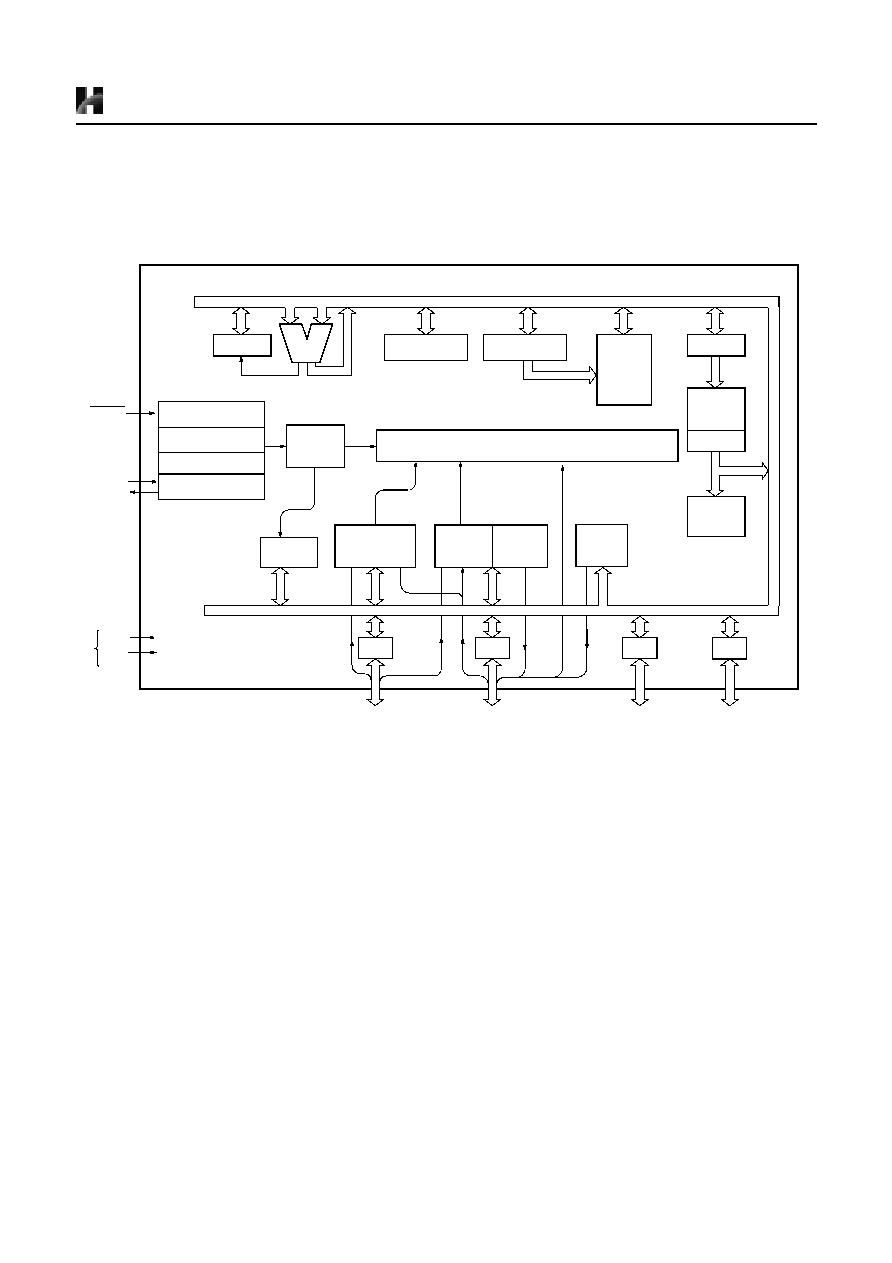
HYUNDAI MicroElectronics
HMS87C1304A/HMS87C1302A
Jan. 2001
Preliminary
3
2. BLOCK DIAGRAM
ALU
Accumulator
Stack Pointer
In te rru p t C o n tro lle r
Data
Memory
8-bit
Converter
A/D
8-bit
Counter
Timer/
Program
Memory
Data Table
PC
8-bit Basic
Timer
Interval
Watch-dog
Timer
Instruction
RA
RB
RC
Buzzer
Driver
PSW
System controller
Timing generator
System
Clock Controller
Clock Generator
RESET
Xin
Xout
RA0 / EC0
RA1 / AN1
RA2 / AN2
RA3 / AN3
RA4 / AN4
RA5 / AN5
RA6 / AN6
RA7 / AN7
RB0 / AN0 / Avref
RB1 / BUZ
RB2 / INT0
RB3 / INT1
RB4 / CMP0 / PWM0
RC0
RC1
V
DD
V
SS
Power
Supply
Decoder
High
PWM
Speed
RD
RD0
RD1
RD2
RD3
Preliminary
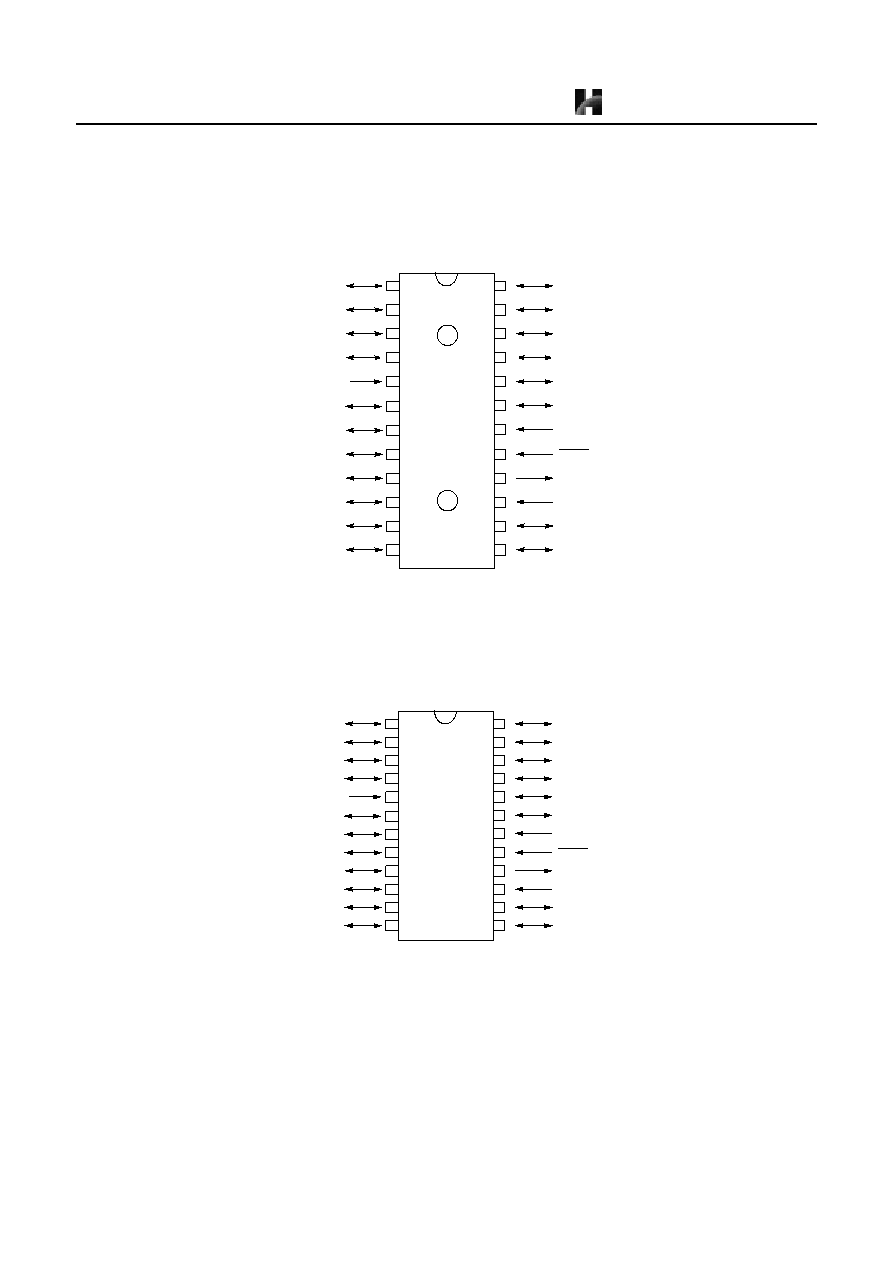
HMS87C1304A/HMS87C1302A
HYUNDAI MicroElectronics
4
Preliminary
Jan. 2001
3. PIN ASSIGNMENT
RA3 / AN3
RA2 / AN2
RA1 / AN1
RA0 / EC0
RC1
RC0
V
SS
RESET
Xout
Xin
AN4 / RA4
AN5 / RA5
AN6 / RA6
AN7 / RA7
V
DD
RD0
RD1
24 PDIP
1
2
3
4
5
6
7
8
9
10
24
23
22
21
20
19
18
17
16
15
11
12
RD3
RD2
14
13
RA3 / AN3
RA2 / AN2
RA1 / AN1
RA0 / EC0
RC1
RC0
V
SS
RESET
Xout
Xin
AN4 / RA4
AN5 / RA5
AN6 / RA6
AN7 / RA7
V
DD
AN0 / AVref / RB0
BUZ / RB1
INT0 / RB2
INT1 / RB3
PWM0 / COMP0 / RB4
24 SOP
1
2
3
4
5
6
7
8
9
10
24
23
22
21
20
19
18
17
16
15
11
12
RD3
RD2
14
13
AN0 / AVref / RB0
BUZ / RB1
INT0 / RB2
INT1 / RB3
PWM0 / COMP0 / RB4
RD1
RD0
Preliminary
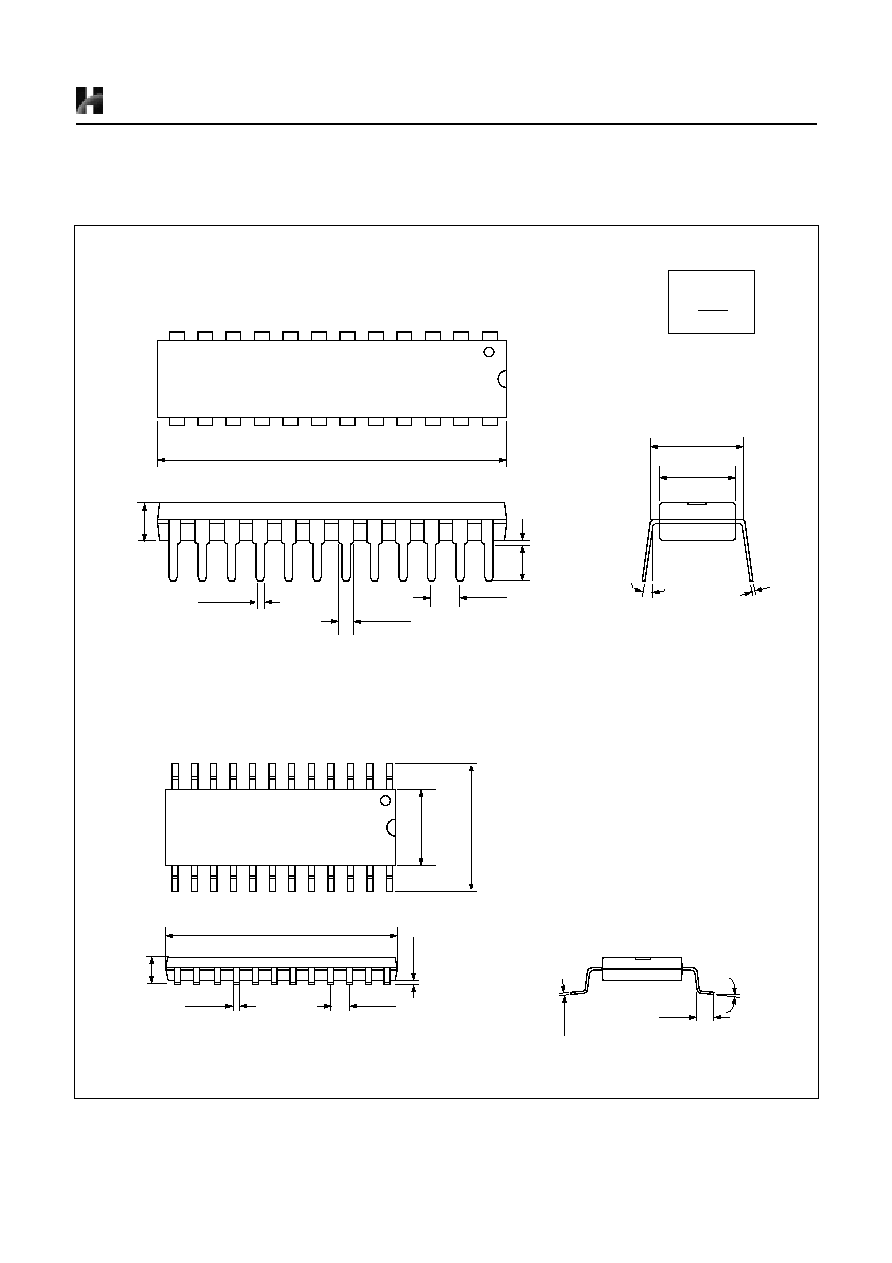
HYUNDAI MicroElectronics
HMS87C1304A/HMS87C1302A
Jan. 2001
Preliminary
5
4. PACKAGE DIAGRAM
1.265
0.045
TYP 0.100
TYP 0.300
0.300
0.01
4
0 ~ 15�
M
AX 0.18
0
M
I
N 0.015
0
.
120
0.
29
2
0.
39
8
0.614
0.
10
4
0.0138
TYP 0.050
0.
00
4
0.00
9
0 ~ 8�
0.016
24 PDIP
24 SOP
unit: inch
MAX
MIN
1.160
0.021
0
.
140
0.065
0.00
8
0.250
0.
41
9
0.
29
9
0.593
0.
09
3
0.019
0.042
0.01
25
0
.
01
18
0.015
Preliminary

HMS87C1304A/HMS87C1302A
HYUNDAI MicroElectronics
6
Preliminary
Jan. 2001
5. PIN FUNCTION
V
DD
: Supply voltage.
V
SS
: Circuit ground.
RESET: Reset the MCU.
X
IN
: Input to the inverting oscillator amplifier and input to
the internal main clock operating circuit.
X
OUT
: Output from the inverting oscillator amplifier.
RA0~RA7: RA is an 8-bit, CMOS, bidirectional I/O port.
RA pins can be used as outputs or inputs according to "1"
or "0" written the their Port Direction Register(RAIO).
In addition, RA serves the functions of the various special
features in Table 5-1 .
RB0~RB7: RB is a 8-bit, CMOS, bidirectional I/O port.
RB pins can be used as outputs or inputs according to "1"
or "0" written the their Port Direction Register(RBIO).
RB serves the functions of the various following special
features
in
Table 5-2
RC0, RC1: RC is a 2-bit, CMOS, bidirectional I/O port.
RC pins can be used as outputs or inputs according to "1"
or "0" written the their Port Direction Register(RCIO).
RD0~RD3: RD is a 4-bit, CMOS, bidirectional I/O port.
RC pins can be used as outputs or inputs according to "1"
or "0" written the their Port Direction Register(RDIO).
Port pin
Alternate function
RA0
RA1
RA2
RA3
RA4
RA5
RA6
RA7
EC0 ( Event Counter Input Source )
AN1 ( Analog Input Port 1 )
AN2 ( Analog Input Port 2 )
AN3 ( Analog Input Port 3 )
AN4 ( Analog Input Port 4 )
AN5 ( Analog Input Port 5 )
AN6 ( Analog Input Port 6 )
AN7 ( Analog Input Port 7 )
Table 5-1 RA Port
Port pin
Alternate function
RB0
RB1
RB2
RB3
RB4
AN0 ( Analog Input Port 0 )
AVref ( External Analog Reference Pin )
BUZ ( Buzzer Driving Output Port )
INT0 ( External Interrupt Input Port 0 )
INT1 ( External Interrupt Input Port 1 )
PWM0 (PWM0 Output)
COMP0 (Timer1 Compare Output)
Table 5-2 RB Port
Preliminary
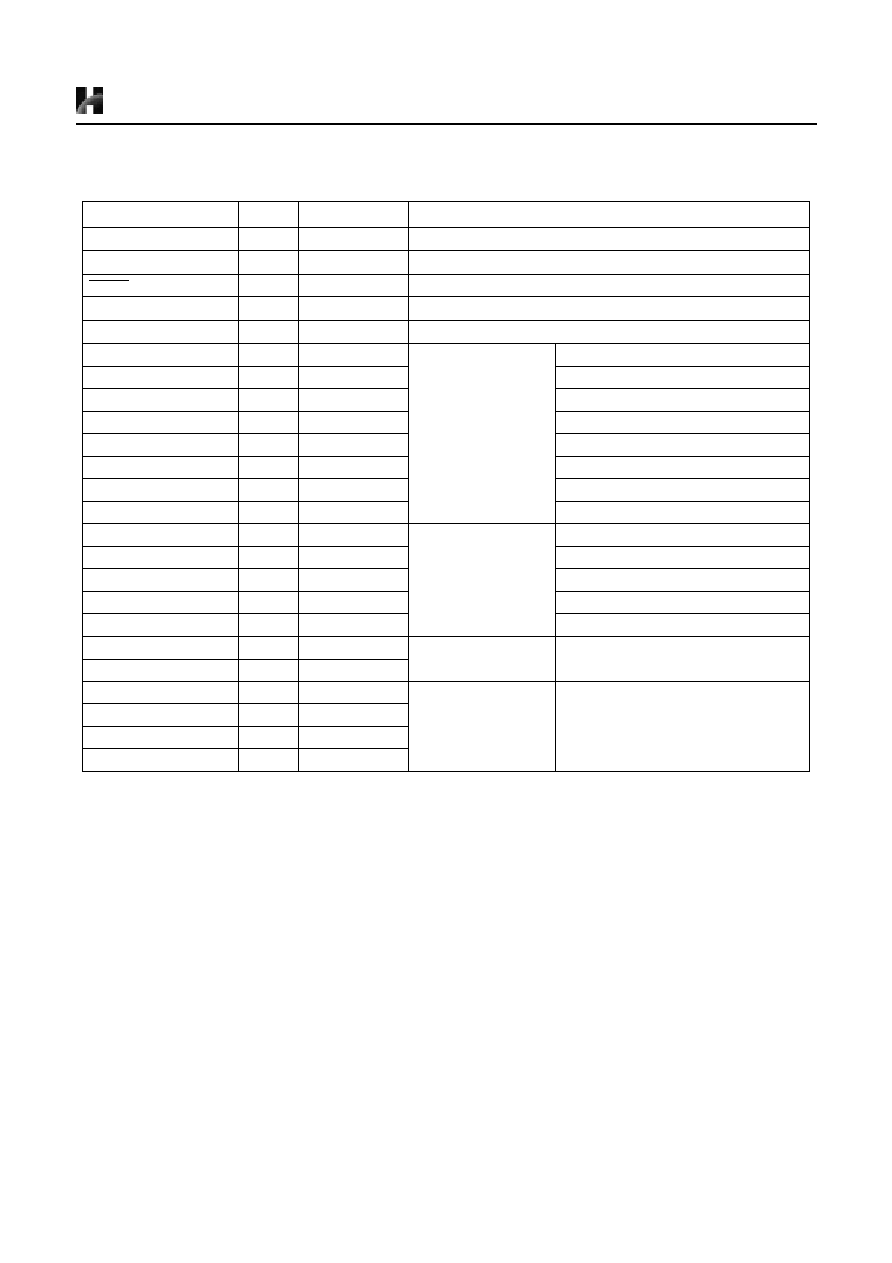
HYUNDAI MicroElectronics
HMS87C1304A/HMS87C1302A
Jan. 2001
Preliminary
7
PIN NAME
Pin No.
In/Out
Function
V
DD
5
-
Supply voltage
V
SS
18
-
Circuit ground
RESET
17
I
Reset signal input
X
IN
15
I
X
OUT
16
O
RA0 (EC0)
21
I/O (Input)
8-bit general I/O ports
External Event Counter input 0
RA1 (AN1)
22
I/O (Input)
Analog Input Port 1
RA2 (AN2)
23
I/O (Input)
Analog Input Port 2
RA3 (AN3)
24
I/O (Input)
Analog Input Port 3
RA4 (AN4)
1
I/O (Input)
Analog Input Port 4
RA5 (AN5)
2
I/O (Input)
Analog Input Port 5
RA6 (AN6)
3
I/O (Input)
Analog Input Port 6
RA7 (AN7)
4
I/O (Input)
Analog Input Port 7
RB0 (AVref/AN0)
8
I/O (Input)
5-bit general I/O ports
Analog Input Port 0 / Analog Reference
RB1 (BUZ)
9
I/O (Input)
Buzzer Driving Output
RB2 (INT0)
10
I/O (Input)
External Interrupt Input 0
RB3 (INT1)
11
I/O (Output)
External Interrupt Input 1
RB4 (PWM0/COMP0)
12
I/O (Output/Output)
PWM0 Output or Timer1 Compare Output
RC0
19
I/O
2-bit general I/O ports
RC1
20
I/O
RD0 6
I/O
4-bit general I/O ports
RD1
7
I/O
RD2
13
I/O
RD3
14
I/O
Table 5-3 Pin Description
Preliminary
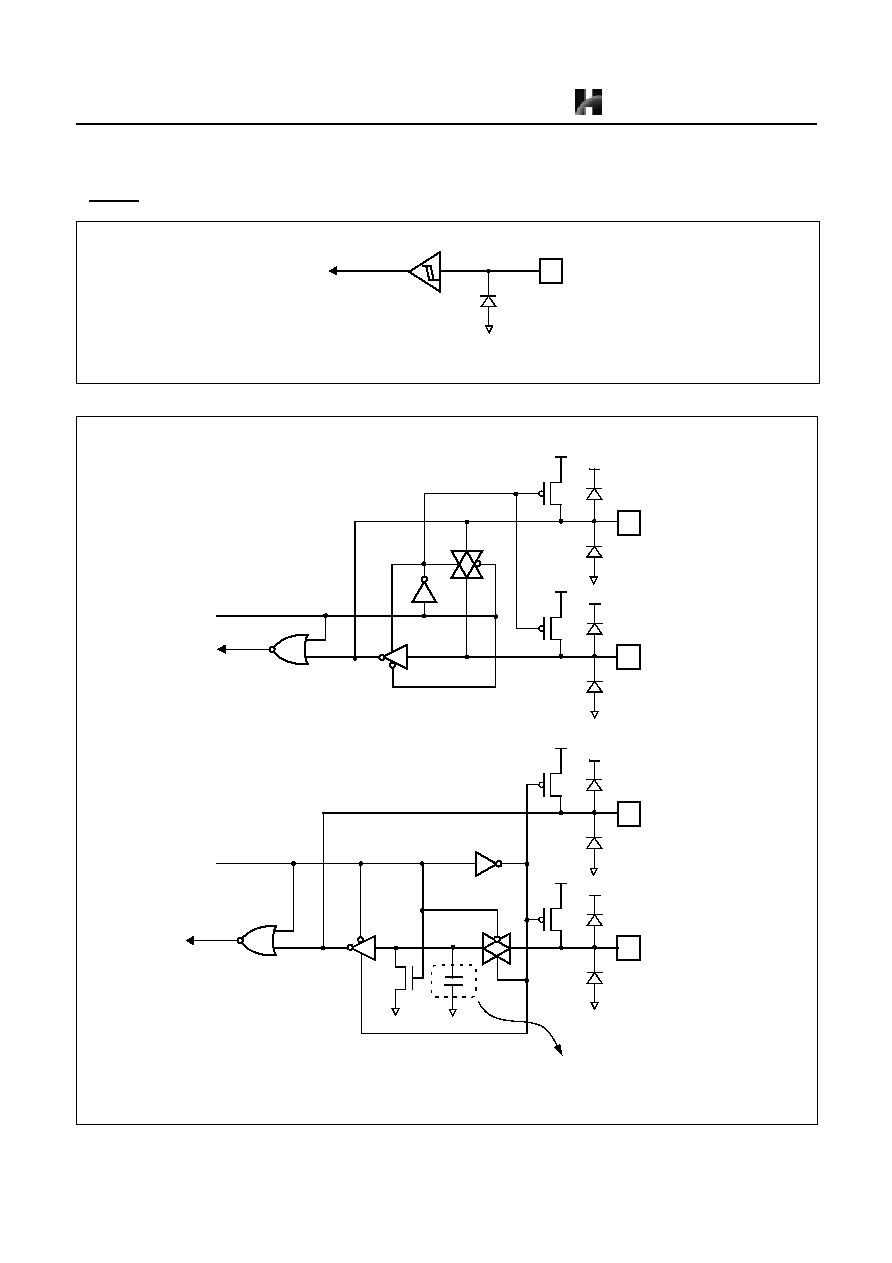
HMS87C1304A/HMS87C1302A
HYUNDAI MicroElectronics
8
Preliminary
Jan. 2001
6. PORT STRUCTURES
� RESET
� Xin, Xout
V
SS
Internal RESET
V
SS
Xout
Xin
STOP
To System CLK
V
DD
V
SS
Xout
Xin
STOP
To System CLK
V
DD
Internal Capacitor 6 pF
Crystal or Ceramic
RC Oscillation
Preliminary

HYUNDAI MicroElectronics
HMS87C1304A/HMS87C1302A
Jan. 2001
Preliminary
9
� RA0/EC0
� RA1/AN1 ~ RA7/AN7
Data Bus
Data Bus
Data Bus
Data Reg.
Direction Reg.
Read
EC0
Schmitt Trigger
Open Drain
V
DD
V
SS
Data Bus
Data Bus
Data Bus
Read
To A/D Converter
Analog Input Mode
(ANSEL7 ~ 1)
Analog CH. Selection
(ADCM.4 ~ 2)
Data Reg.
Direction Reg.
Preliminary

HMS87C1304A/HMS87C1302A
HYUNDAI MicroElectronics
10
Preliminary
Jan. 2001
� RB0 / AN0 / AVref
� RB1/BUZ, RB4/PWM0/COMP0
V
DD
V
SS
Data Bus
Data Bus
Data Bus
Read
To A/D Converter
Analog Input Mode
(ANSEL0)
Analog CH0 Selection
(ADCM.4 ~ 2)
AVREFS
AVREFS
Internal V
DD
0
1
To Vref of A/D
Data Reg.
Direction Reg.
V
DD
V
SS
Data Bus
Data Bus
Data Bus
Read
0
1
Function
Select
PWM/COMP
BUZ
Data Reg.
Direction Reg.
Preliminary
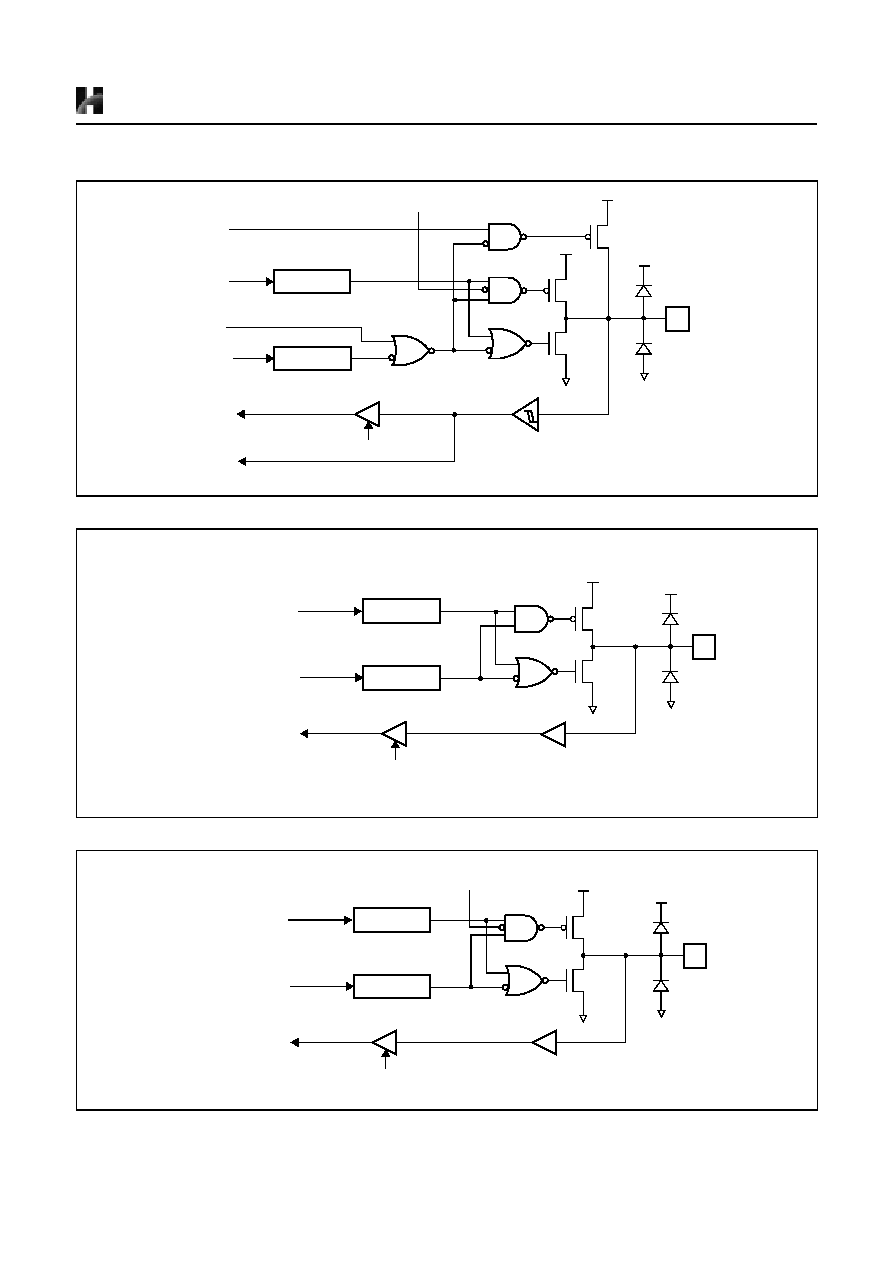
HYUNDAI MicroElectronics
HMS87C1304A/HMS87C1302A
Jan. 2001
Preliminary
11
� RB2/INT0, RB3/INT1
� RC0, RD0, RD1, RD2, RD3
� RC1
V
DD
V
SS
Data Bus
Data Bus
Data Bus
Read
Function
Select
Pull-up
Select
INT0, INT1
Schmitt Trigger
Weak Pull-up
Data Reg.
Direction Reg.
Open Drain
Data Bus
Data Bus
Data Bus
Data Reg.
Direction Reg.
Read
V
DD
V
SS
Data Bus
Data Bus
Data Bus
Read
Data Reg.
Direction Reg.
Open Drain
Preliminary
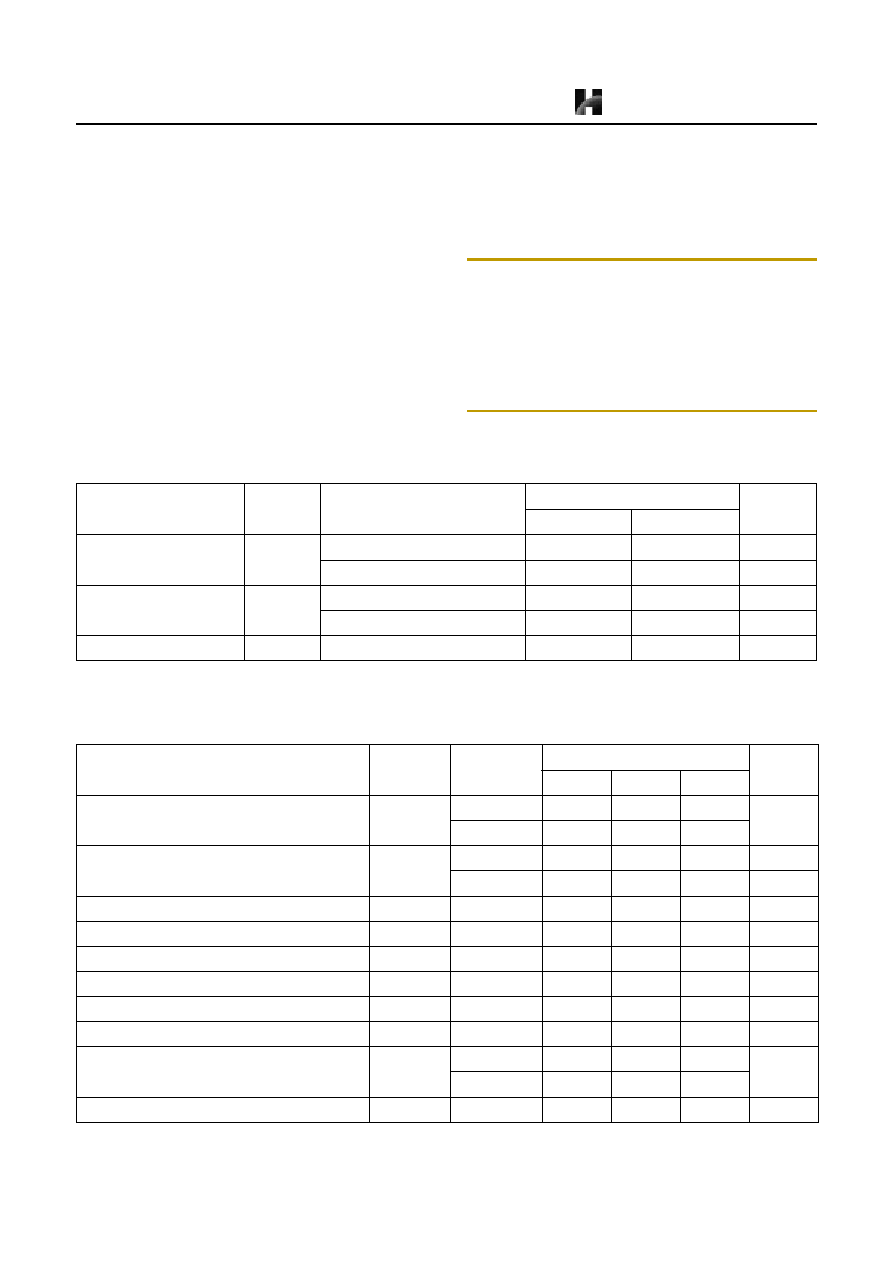
HMS87C1304A/HMS87C1302A
HYUNDAI MicroElectronics
12
Preliminary
Jan. 2001
7. ELECTRICAL CHARACTERISTICS
7.1 Absolute Maximum Ratings
Supply voltage ........................................... -0.3 to +6.0 V
Storage Temperature ................................-40 to +125
�
C
Voltage on any pin with respect to Ground (V
SS
)
............................................................... -0.3 to V
DD
+0.3
Maximum current out of V
SS
pin ........................200 mA
Maximum current into V
DD
pin ..........................150 mA
Maximum current sunk by (I
OL
per I/O Pin) ........25 mA
Maximum output current sourced by (I
OH
per I/O Pin)
...............................................................................15 mA
Maximum current (
I
OL
) ....................................150 mA
Maximum current (
I
OH
).................................... 100 mA
Note: Stresses above those listed under "Absolute Maxi-
mum Ratings" may cause permanent damage to the
device. This is a stress rating only and functional op-
eration of the device at any other conditions above
those indicated in the operational sections of this
specification is not implied. Exposure to absolute
maximum rating conditions for extended periods
may affect device reliability.
7.2 Recommended Operating Conditions
7.3 A/D Converter Characteristics
(T
A
=25
�
C, V
SS
=0V, V
DD
=5.12V @
f
XIN
=8MHz, V
DD
=3.072V @
f
XIN
=4MHz)
Parameter
Symbol
Condition
Specifications
Unit
Min.
Max.
Supply Voltage
V
DD
f
XIN
=8MHz
4.5
5.5
V
f
XIN
=4.2MHz
2.0
5.5
V
Operating Frequency
f
XIN
V
DD
=4.5~5.5V
1
8
MHz
V
DD
=2.0~5.5V
1
4.2
MHz
Operating Temperature
T
OPR
-20
85
�
C
Parameter
Symbol
Condition
Specifications
Unit
Min.
Typ.
Max.
Analog Input Voltage Range
V
AIN
AVREFS=0
V
SS
-
V
DD
V
AVREFS=1
V
SS
-
V
REF
Analog Power Supply Input Voltage Range
V
REF
V
DD
=5V
3
-
V
DD
V
V
DD
=3V
2.4
-
V
DD
V
Overall Accuracy
N
ACC
-
�
1.0
�
1.5
LSB
Non-Linearity Error
N
NLE
-
�
1.0
�
1.5
LSB
Differential Non-Linearity Error
N
DNLE
-
�
1.0
�
1.5
LSB
Zero Offset Error
N
ZOE
-
�
0.5
�
1.5
LSB
Full Scale Error
N
FSE
-
�
0.25
�
0.5
LSB
Gain Error
N
NLE
-
�
1.0
�
1.5
LSB
Conversion Time
T
CONV
f
XIN
=8MHz
-
-
10
�
S
f
XIN
=4MHz
-
-
20
AV
REF
Input Current
I
REF
AVREFS=1
-
0.5
1.0
mA
Preliminary

HYUNDAI MicroElectronics
HMS87C1304A/HMS87C1302A
Jan. 2001
Preliminary
13
7.4 DC Electrical Characteristics
(T
A
=-20~85
�
C, V
DD
=2.0~5.5V
,
V
SS
=0V)
,
Parameter
Symbol
Pin
Condition
Specifications
Unit
Min.
Typ.
Max.
Input High Voltage
V
IH1
X
IN
, RESET
0.8 V
DD
-
V
DD
V
V
IH2
Hysteresis Input
1
0.8 V
DD
-
V
DD
V
IH3
Normal Input
0.7 V
DD
-
V
DD
Input Low Voltage
V
IL1
X
IN
, RESET
0
-
0.2 V
DD
V
V
IL2
Hysteresis Input
1
0
-
0.2 V
DD
V
IL3
Normal Input
0
-
0.3 V
DD
Output High Voltage
V
OH
All Output Port
V
DD
=5V, I
OH
=-5mA
V
DD
-1
-
-
V
Output Low Voltage
V
OL
All Output Port
V
DD
=5V, I
OL
=10mA
-
-
1
V
Input Pull-up Current
I
P
RB2, RB3, RD0, RD1 V
DD
=5V
-550
-420
-200
�
A
Input High
Leakage Current
I
IH1
All Pins (except X
IN
)
V
DD
=5V
-
-
5
�
A
I
IH2
X
IN
V
DD
=5V
-
-
15
�
A
Input Low
Leakage Current
I
IL1
All Pins (except X
IN
)
V
DD
=5V
-5
-
-
�
A
I
IL2
X
IN
V
DD
=5V
-15
-
-
�
A
Hysteresis
| V
T
|
Hysteresis Input
1
V
DD
=5V
0.5
-
-
V
PFD Voltage
V
PFD1
V
DD
PFD Level = 0
2.5
3.0
3.5
V
V
PFD2
V
DD
PFD Level = 1
2.0
2.5
3.0
Internal RC WDT
Period
T
RCWDT
V
DD
=5V
40
120
�
S
V
DD
=3V
95
280
Operating Current
I
DD
V
DD
V
DD
=5.5V, f
XIN
=8MHz
-
5
6
mA
V
DD
=3.0V, f
XIN
=4MHz
-
2
3
Wake-up Timer
Mode Current
I
WKUP
V
DD
V
DD
=5.5V, f
XIN
=8MHz
-
1
2
mA
V
DD
=3.0V, f
XIN
=4MHz
-
0.5
1
RCWDT Mode
Current at STOP
Mode
I
RCWDT
V
DD
V
DD
=5.5V
-
-
200
�
A
V
DD
=3.0V
-
-
100
Stop Mode Current
I
STOP
V
DD
V
DD
=5.5V, f
XIN
=8MHz
-
0.5
3
�
A
V
DD
=3.0V, f
XIN
=4MHz
-
0.2
1
1. Hysteresis Input: RB2, RB3
Preliminary
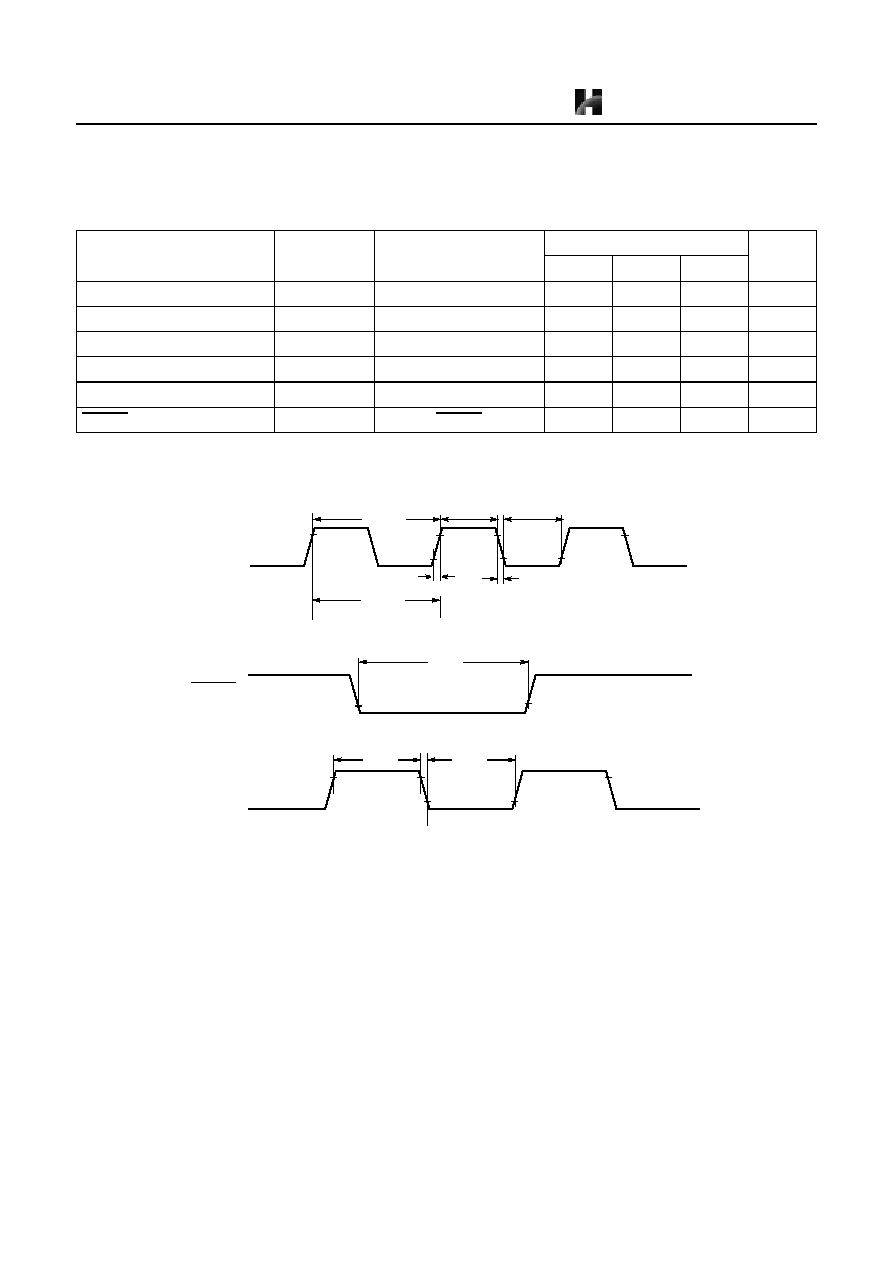
HMS87C1304A/HMS87C1302A
HYUNDAI MicroElectronics
14
Preliminary
Jan. 2001
7.5 AC Characteristics
(T
A
=-20~+85
�
C, V
DD
=5V
�
10%
,
V
SS
=0V)
Figure 7-1 Timing Chart
Parameter
Symbol
Pins
Specifications
Unit
Min.
Typ.
Max.
Operating Frequency
f
CP
X
IN
1
-
8
MHz
External Clock Pulse Width
t
CPW
X
IN
80
-
-
nS
External Clock Transition Time
t
RCP,
t
FCP
X
IN
-
-
20
nS
Oscillation Stabilizing Time
t
ST
X
IN
, X
OUT
-
-
20
mS
External Input Pulse Width
t
EPW
INT0, INT1, EC0
2
-
-
t
SYS
RESET Input Width
t
RST
RESET
8
-
-
t
SYS
t
RCP
t
FCP
X
IN
INT0, INT1
0.5V
V
DD
-0.5V
0.2V
DD
RESET
0.2V
DD
0.8V
DD
EC0
t
RST
t
EPW
t
EPW
1/f
CP
t
CPW
t
CPW
t
SYS
Preliminary

HYUNDAI MicroElectronics
HMS87C1304A/HMS87C1302A
Jan. 2001
Preliminary
15
7.6 Typical Characteristics
This graphs and tables provided in this section are for de-
sign guidance only and are not tested or guaranteed.
In some graphs or tables the data presented are out-
side specified operating range (e.g. outside specified
V
DD
range). This is for information only and devices
are guaranteed to operate properly only within the
specified range.
The data presented in this section is a statistical summary
of data collected on units from different lots over a period
of time. "Typical" represents the mean of the distribution
while "max" or "min" represents (mean + 3
) and (mean
-
3
) respectively where
is standard deviation
Ta= 25
�
C
Ta=25
�
C
I
DD
-
V
DD
8
6
4
2
0
(mA)
I
DD
2
3
4
5
6
V
DD
(V)
Normal Operation
8
6
4
2
0
(MHz)
f
XIN
2
3
4
5
6
V
DD
(V)
Operating Area
f
XIN
= 8MHz
4MHz
10
I
WKUP
-
V
DD
2.0
1.5
1.0
0.5
0
(mA)
I
DD
2
3
4
5
6
V
DD
(V)
Wake-up Timer Mode
I
RCWDT
-
V
DD
20
15
10
5
0
(
�
A)
I
DD
2
3
4
5
6
V
DD
(V)
RC-WDT in Stop Mode
Ta=25
�
C
f
XIN
= 8MHz
4MHz
Ta=25
�
C
I
STOP
-
V
DD
0.8
0.6
0.4
0.2
0
(
�
A)
I
DD
2
3
4
5
6
V
DD
(V)
STOP Mode
f
XIN
= 8MHz
-25
�
C
85
�
C
25
�
C
T
RCWDT
= 80uS
Preliminary
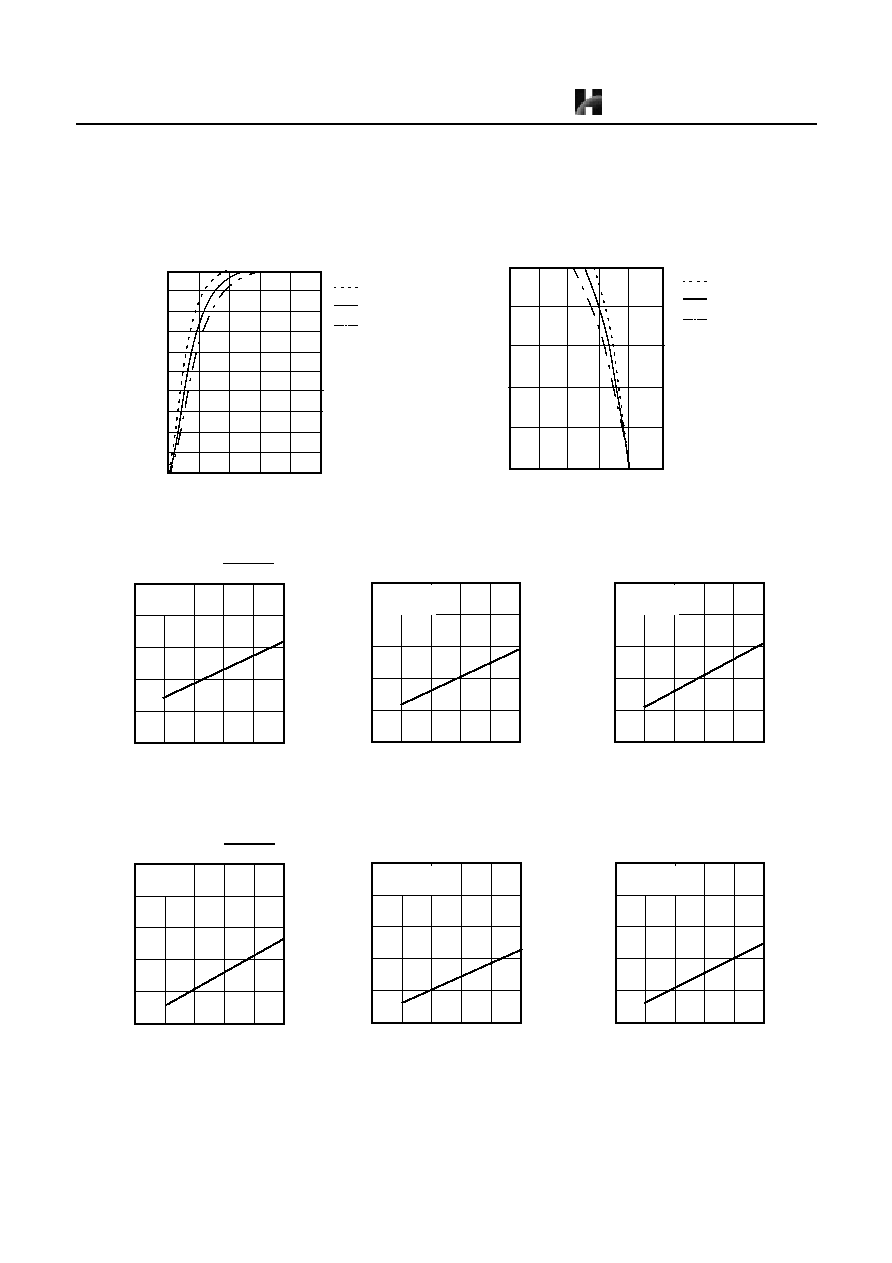
HMS87C1304A/HMS87C1302A
HYUNDAI MicroElectronics
16
Preliminary
Jan. 2001
I
OL
-
V
OL
, V
DD
=5V
40
30
20
10
0
(mA)
I
OL
V
OL
(V)
I
OH
-
V
OH
, V
DD
=5V
-20
-15
-10
-5
0
(mA)
I
OH
2
3
4
5
6
V
OH
(V)
1
2
3
4
5
f
XIN
=4MHz
V
DD
-
V
IH1
4
3
2
1
0
(V)
V
IH1
2
3
4
5
6
V
DD
(V)
V
DD
-
V
IH2
4
3
2
1
0
(V)
V
IH2
2
3
4
5
6
V
DD
(V)
Ta=25
�
C
f
X IN
=4kH z
Ta=25
�
C
1
X
IN
, RESET
Hysteresis input
-25
�
C
85
�
C
25
�
C
-25
�
C
85
�
C
25
�
C
V
DD
-
V
IH3
4
3
2
1
0
(V)
V
IH3
2
3
4
5
6
V
DD
(V)
f
X IN
=4kH z
Ta=25
�
C
Normal input
f
XIN
=4MHz
V
DD
-
V
IL1
4
3
2
1
0
(V)
V
IL1
2
3
4
5
6
V
DD
(V)
V
DD
-
V
IL2
4
3
2
1
0
(V)
V
IL2
2
3
4
5
6
V
DD
(V)
Ta=25
�
C
f
X IN
=4kH z
Ta=25
�
C
1
X
IN
, RESET
Hysteresis input
V
DD
-
V
IL3
4
3
2
1
0
(V)
V
IL3
2
3
4
5
6
V
DD
(V)
f
X IN
=4kH z
Ta=25
�
C
Normal input
Preliminary
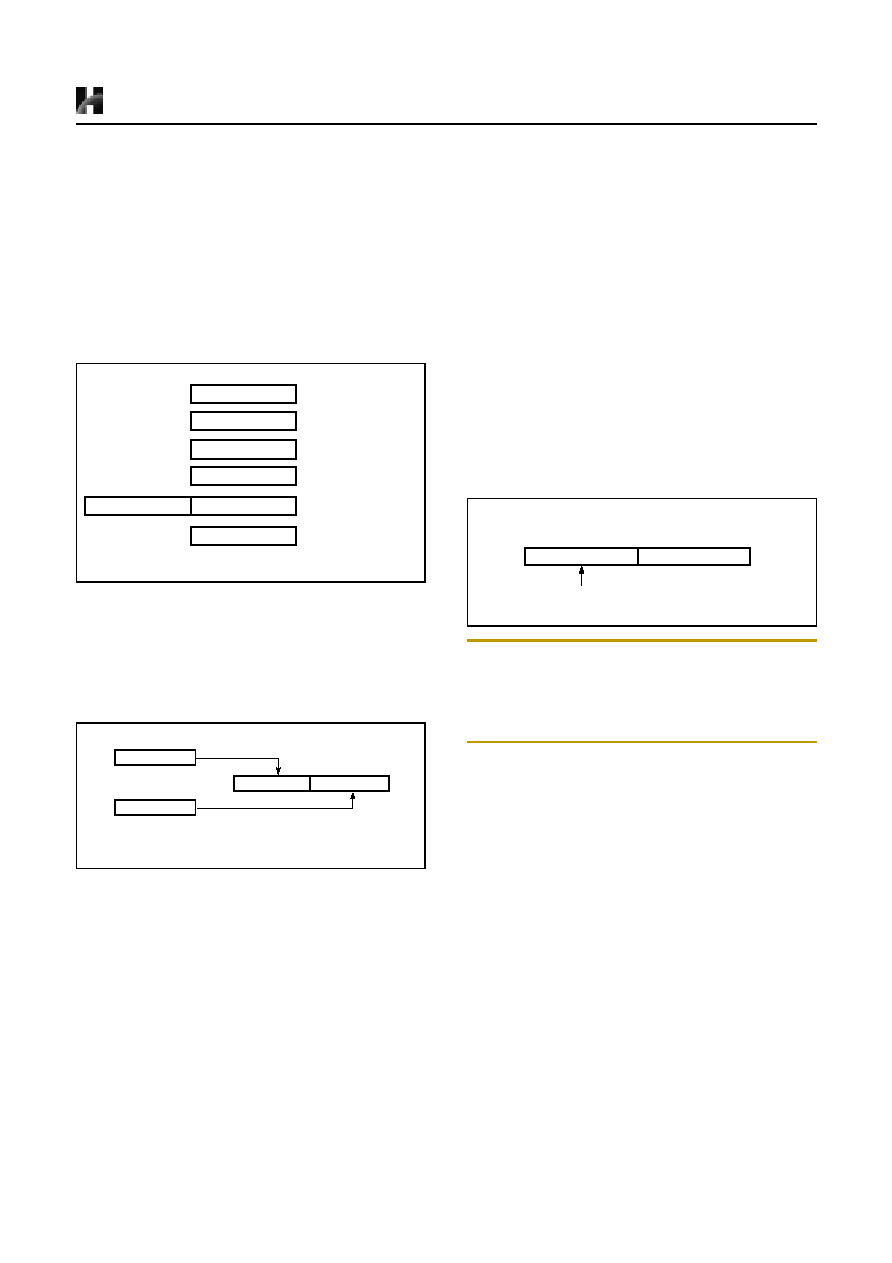
HYUNDAI MicroElectronics
HMS87C1304A/HMS87C1302A
Jan. 2001
Preliminary
17
8. MEMORY ORGANIZATION
The HMS87C1304A and HMS87C1302A have separate
address spaces for Program memory and Data Memory.
Program memory can only be read, not written to. It can be
up to 4K /8K bytes of Program memory. Data memory can
be read and written to up to 192 bytes including the stack
area.
8.1 Registers
This device has six registers that are the Program Counter
(PC), a Accumulator (A), two index registers (X, Y), the
Stack Pointer (SP), and the Program Status Word (PSW).
The Program Counter consists of 16-bit register.
Figure 8-1 Configuration of Registers
Accumulator: The Accumulator is the 8-bit general pur-
pose register, used for data operation such as transfer, tem-
porary saving, and conditional judgement, etc.
The Accumulator can be used as a 16-bit register with Y
Register as shown below.
Figure 8-2 Configuration of YA 16-bit Register
X, Y Registers: In the addressing mode which uses these
index registers, the register contents are added to the spec-
ified address, which becomes the actual address. These
modes are extremely effective for referencing subroutine
tables and memory tables. The index registers also have in-
crement, decrement, comparison and data transfer func-
tions, and they can be used as simple accumulators.
Stack Pointer: The Stack Pointer is an 8-bit register used
for occurrence interrupts and calling out subroutines. Stack
Pointer identifies the location in the stack to be accessed
(save or restore).
Generally, SP is automatically updated when a subroutine
call is executed or an interrupt is accepted. However, if it
is used in excess of the stack area permitted by the data
memory allocating configuration, the user-processed data
may be lost.
The stack can be located at any position within 00
H
to 7F
H
of the internal data memory. The SP is not initialized by
hardware, requiring to write the initial value (the location
with which the use of the stack starts) by using the initial-
ization routine. Normally, the initial value of "7F
H
" is
used.
Note: The Stack Pointer must be initialized by software be-
cause its value is undefined after RESET.
Example: To initialize the SP
LDX
#07FH
TXSP
; SP
7F
H
Program Counter: The Program Counter is a 16-bit wide
which consists of two 8-bit registers, PCH and PCL. This
counter indicates the address of the next instruction to be
executed. In reset state, the program counter has reset rou-
tine address (PC
H
:0FF
H
, PC
L
:0FE
H
).
Program Status Word: The Program Status Word (PSW)
contains several bits that reflect the current state of the
CPU. The PSW is described in Figure 8-3 . It contains the
Negative flag, the Overflow flag, the Break flag the Half
Carry (for BCD operation), the Interrupt enable flag, the
Zero flag, and the Carry flag.
[Carry flag C]
This flag stores any carry or borrow from the ALU of CPU
after an arithmetic operation and is also changed by the
Shift Instruction or Rotate Instruction.
[Zero flag Z]
This flag is set when the result of an arithmetic operation
or data transfer is "0" and is cleared by any other result.
A
ACCUMULATOR
X REGISTER
Y REGISTER
STACK POINTER
PROGRAM COUNTER
PROGRAM STATUS
WORD
X
Y
SP
PCL
PCH
PSW
Two 8-bit Registers can be used as a "YA" 16-bit Register
Y
A
Y
A
SP
0
Stack Address (000
H
~ 07F
H
)
15
0
8
7
Hardware fixed
Preliminary
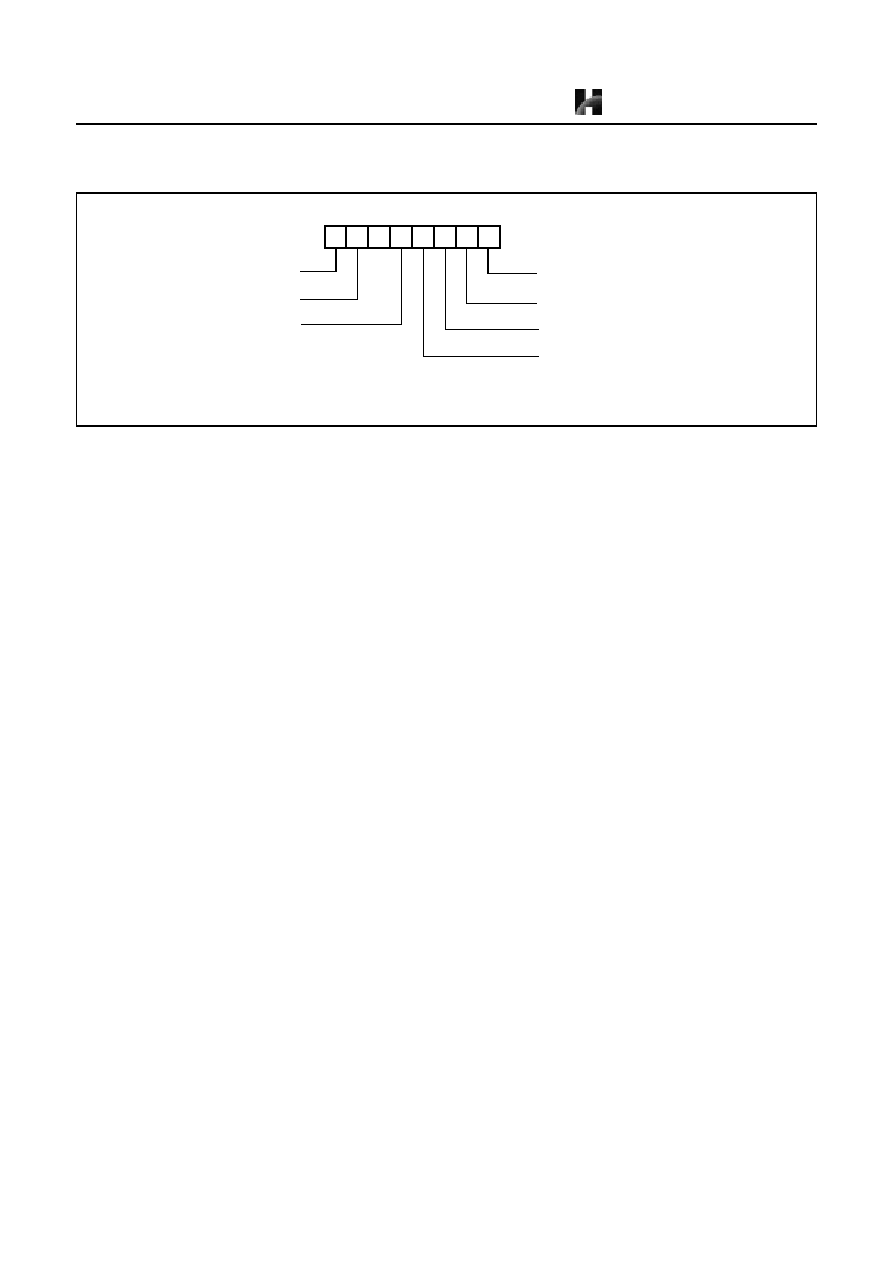
HMS87C1304A/HMS87C1302A
HYUNDAI MicroElectronics
18
Preliminary
Jan. 2001
Figure 8-3 PSW (Program Status Word) Register
[Interrupt disable flag I]
This flag enables/disables all interrupts except interrupt
caused by Reset or software BRK instruction. All inter-
rupts are disabled when cleared to "0". This flag immedi-
ately becomes "0" when an interrupt is served. It is set by
the EI instruction and cleared by the DI instruction.
[Half carry flag H]
After operation, this is set when there is a carry from bit 3
of ALU or there is no borrow from bit 4 of ALU. This bit
can not be set or cleared except CLRV instruction with
Overflow flag (V).
[Break flag B]
This flag is set by software BRK instruction to distinguish
BRK from TCALL instruction with the same vector ad-
dress.
[Overflow flag V]
This flag is set to "1" when an overflow occurs as the result
of an arithmetic operation involving signs. An overflow
occurs when the result of an addition or subtraction ex-
ceeds +127(7F
H
) or -128(80
H
). The CLRV instruction
clears the overflow flag. There is no set instruction. When
the BIT instruction is executed, bit 6 of memory is copied
to this flag.
[Negative flag N]
This flag is set to match the sign bit (bit 7) status of the re-
sult of a data or arithmetic operation. When the BIT in-
struction is executed, bit 7 of memory is copied to this flag.
N
NEGATIVE FLAG
V
-
B
H
I
Z
C
MSB
LSB
RESET VALUE: 00
H
PSW
OVERFLOW FLAG
BRK FLAG
CARRY FLAG RECEIVES
ZERO FLAG
INTERRUPT ENABLE FLAG
CARRY OUT
HALF CARRY FLAG RECEIVES
CARRY OUT FROM BIT 1 OF
ADDITION OPERLANDS
Preliminary
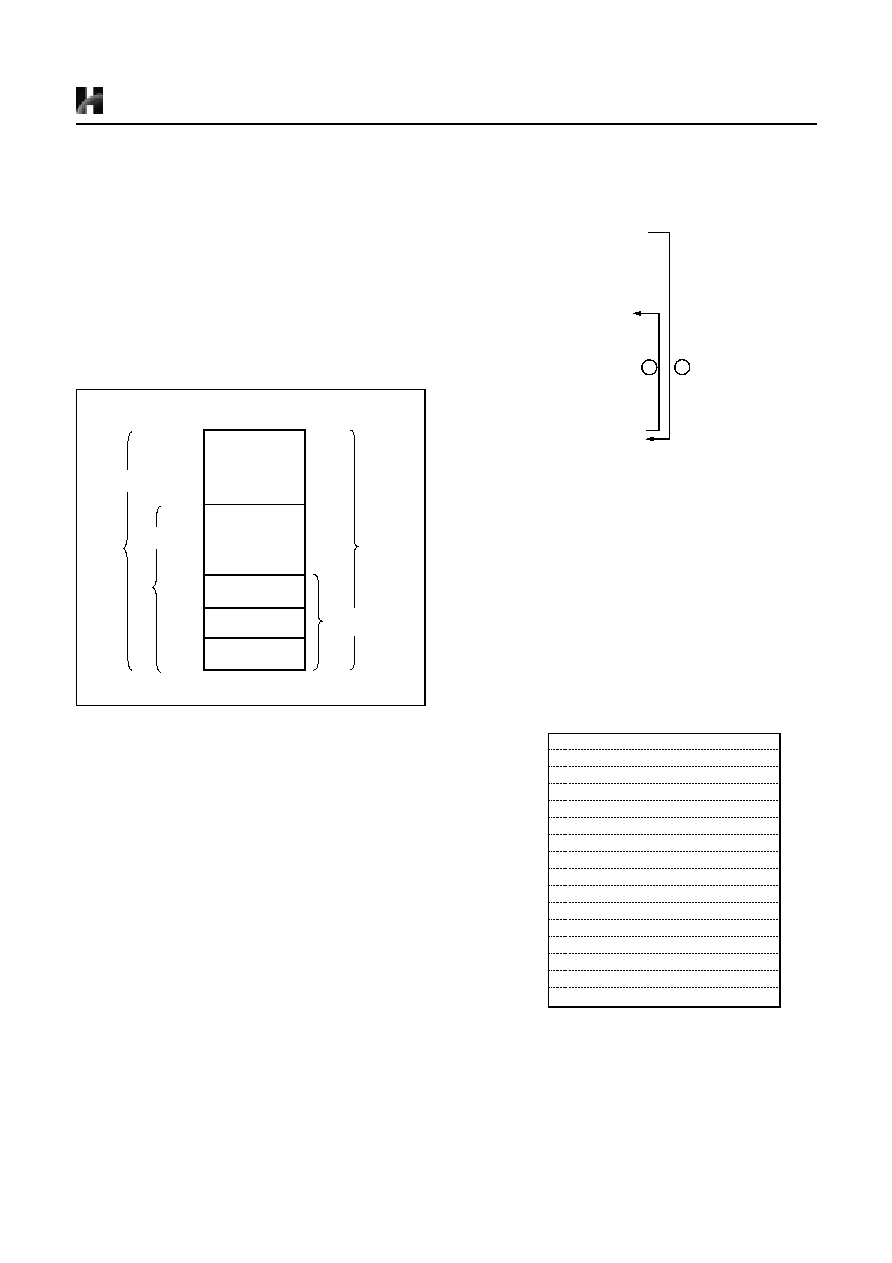
HYUNDAI MicroElectronics
HMS87C1304A/HMS87C1302A
Jan. 2001
Preliminary
19
8.2 Program Memory
A 16-bit program counter is capable of addressing up to
64K bytes, but these devices have 4K/2K bytes program
memory space only physically implemented. Accessing a
location above FFFF
H
will cause a wrap-around to 0000
H
.
Figure 8-4 , shows a map of Program Memory. After reset,
the CPU begins execution from reset vector which is stored
in address FFFE
H
and FFFF
H
as shown in Figure 8-5 .
As shown in Figure 8-4 , each area is assigned a fixed lo-
cation in Program Memory. Program Memory area con-
tains the user program.
Figure 8-4 Program Memory Map
Page Call (PCALL) area contains subroutine program to
reduce program byte length by using 2 bytes PCALL in-
stead of 3 bytes CALL instruction. If it is frequently called,
it is more useful to save program byte length.
Table Call (TCALL) causes the CPU to jump to each
TCALL address, where it commences the execution of the
service routine. The Table Call service area spaces 2-byte
for every TCALL: 0FFC0
H
for TCALL15, 0FFC2
H
for
TCALL14, etc., as shown in Figure 8-6 .
Example: Usage of TCALL
The interrupt causes the CPU to jump to specific location,
where it commences the execution of the service routine.
The External interrupt 0, for example, is assigned to loca-
tion 0FFFA
H
. The interrupt service locations spaces 2-byte
interval: 0FFF8
H
and 0FFF9
H
for External Interrupt 1,
0FFFA
H
and 0FFFB
H
for External Interrupt 0, etc.
As for the area from 0FF00
H
to 0FFFF
H
, if any area of
them is not going to be used, its service location is avail-
able as general purpose Program Memory.
Figure 8-5 Interrupt Vector Area
PROGRAM
MEMORY
TCALL
AREA
INTERRUPT
VECTOR AREA
F000H
FEFFH
FF00H
FFC0H
FFDFH
FFE0H
FFFFH
PCALL
AREA
F800H
HMS87C1302A
HMS87C1304A
LDA
#5
TCALL 0FH
;
1BYTE IN STRU C TIO N
:
;
INS TE AD O F 3 BYTES
:
;
NO R M AL C ALL
;
;TABLE CALL ROUTINE
;
FUNC_A:
LDA
LRG0
RET
;
FUNC_B:
LDA
LRG1
RET
;
;TABLE CALL ADD. AREA
;
ORG
0FFC0H
;
TC ALL AD D RE SS AR EA
DW
FUNC_A
DW
FUNC_B
1
2
0FFE0
H
E2
Address
Vector Area Memory
E4
E6
E8
EA
EC
EE
F0
F2
F4
F6
F8
FA
FC
FE
-
-
-
Basic Interval Interrupt Vector Area
A/D Converter Interrupt Vector Area
-
-
-
Timer/Counter 1 Interrupt Vector Area
Timer/Counter 0 Interrupt Vector Area
External Interrupt 0 Vector Area
-
RESET Vector Area
External Interrupt 1 Vector Area
-
Watchdog Timer Interrupt Vector Area
"-" means reserved area.
NOTE:
Preliminary
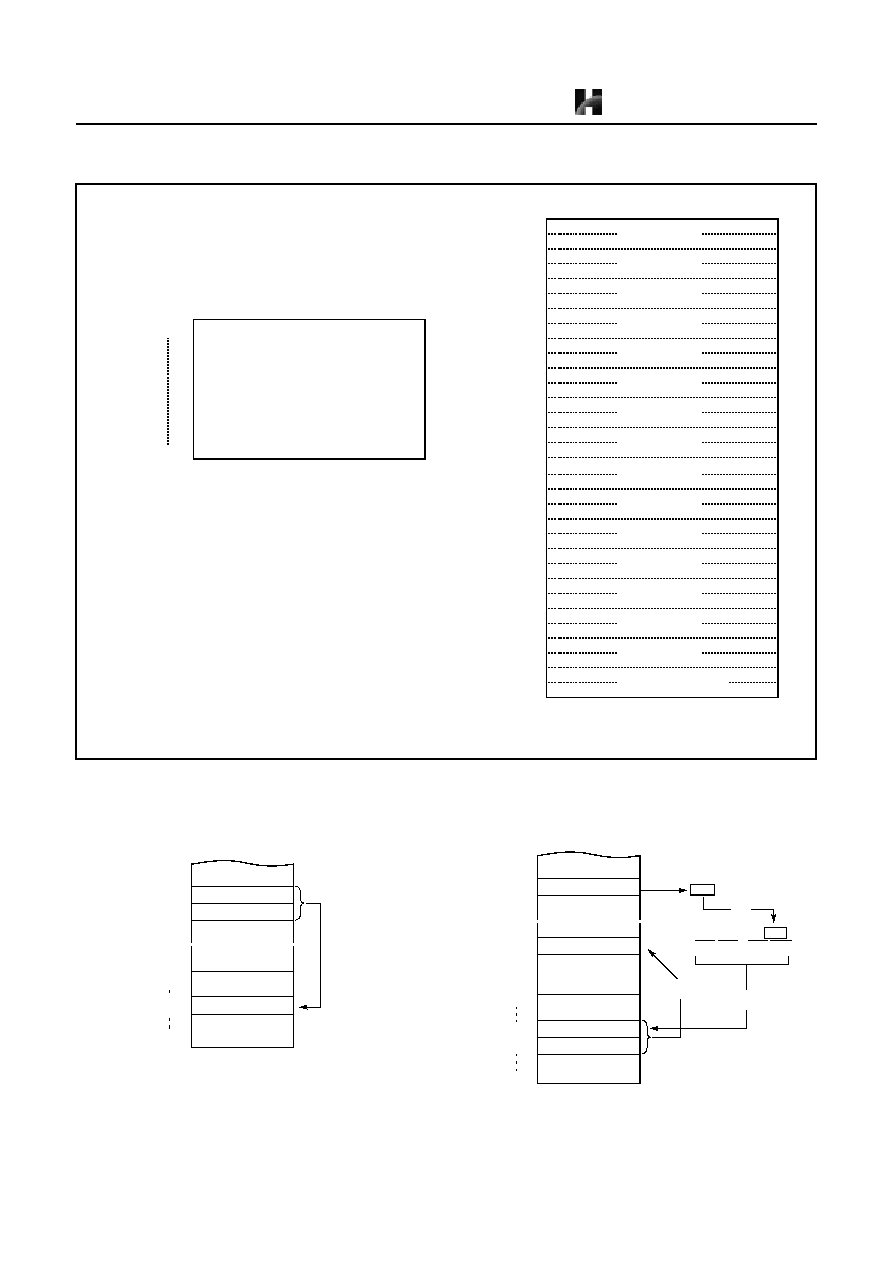
HMS87C1304A/HMS87C1302A
HYUNDAI MicroElectronics
20
Preliminary
Jan. 2001
Figure 8-6 PCALL and TCALL Memory Area
PCALL
rel
4F35
PCALL
35H
TCALL
n
4A
TCALL 4
0FFC0
H
C1
Address
Program Memory
C2
C3
C4
C5
C6
C7
C8
0FF00
H
Address
PCALL Area Memory
0FFFF
H
PCALL Area
(256 Bytes)
* means that the BRK software interrupt is using
same address with TCALL0.
NOTE:
TCALL 15
TCALL 14
TCALL 13
TCALL 12
TCALL 11
TCALL 10
TCALL 9
TCALL 8
TCALL 7
TCALL 6
TCALL 5
TCALL 4
TCALL 3
TCALL 2
TCALL 1
TCALL 0 / BRK *
C9
CA
CB
CC
CD
CE
CF
D0
D1
D2
D3
D4
D5
D6
D7
D8
D9
DA
DB
DC
DD
DE
DF
4F
~
~
~
~
NEXT
35
0FF35H
0FF00H
0FFFFH
11111111 11010110
01001010
PC:
F
H
F
H
D
H
6
H
4A
~
~
~
~
25
0FFD6H
0FF00H
0FFFFH
F1
NEXT
0FFD7H
�
�
�
0F125H
Reverse
Preliminary

HYUNDAI MicroElectronics
HMS87C1304A/HMS87C1302A
Jan. 2001
Preliminary
21
Example: The usage software example of Vector address and the initialize part.
ORG
0FFE0H
DW
NOT_USED
; (0FFEO)
DW
NOT_USED
; (0FFE2)
DW
NOT_USED
; (0FFE4)
DW
BIT_INT
; (0FFE6) Basic Interval Timer
DW
WDT_INT
; (0FFE8) Watchdog Timer
DW
AD_INT
; (0FFEA) A/D
DW
NOT_USED
; (0FFEC)
DW
NOT_USED
; (0FFEE)
DW
NOT_USED
; (0FFF0)
DW
NOT_USED
; (0FFF2)
DW
TMR1_INT
; (0FFF4) Timer-1
DW
TMR0_INT
; (0FFF6) Timer-0
DW
INT1
; (0FFF8) Int.1
DW
INT0
; (0FFFA) Int.0
DW
NOT_USED
; (0FFFC)
DW
RESET
; (0FFFE) Reset
ORG
0F000H
;********************************************
;
MAIN PROGRAM
*
;*******************************************
;
RESET:
DI
;Disable All Interrupts
LDX
#0
RAM_CLR: LDA
#0
;RAM Clear(!0000H->!007FH)
STA
{X}+
CMPX
#080H
BNE
RAM_CLR
;
LDX
#07FH
;Stack Pointer Initialize
TXSP
;
CALL
INITIAL
;
;
LDM
RA, #0
;Normal Port A
LDM
RAIO,#1000_0010B
;Normal Port Direction
LDM
RB, #0
;Normal Port B
LDM
RBIO,#0000_0010B
;Normal Port Direction
:
:
LDM
PFDR,#0
;Enable Power Fail Detector
:
:
Preliminary

HMS87C1304A/HMS87C1302A
HYUNDAI MicroElectronics
22
Preliminary
Jan. 2001
8.3 Data Memory
Figure 8-7 shows the internal Data Memory space availa-
ble. Data Memory is divided into two groups, a user RAM
(including Stack) and control registers.
Figure 8-7 Data Memory Map
User Memory
The HMS87C1304A and HMS87C1302A has 128
�
8 bits
for the user memory (RAM).
Control Registers
The control registers are used by the CPU and Peripheral
function blocks for controlling the desired operation of the
device. Therefore these registers contain control and status
bits for the interrupt system, the timer/ counters, analog to
digital converters and I/O ports. The control registers are in
address range of 0C0
H
to 0FF
H
.
Note that unoccupied addresses may not be implemented
on the chip. Read accesses to these addresses will in gen-
eral return random data, and write accesses will have an in-
determinate effect.
More detailed informations of each register are explained
in each peripheral section.
Note: Write only registers can not be accessed by bit ma-
nipulation instruction. Do not use read-modify-write
instruction. Use byte manipulation instruction.
Example; To write at CKCTLR
LDM
CKCTLR,#09H ;Divide ratio
�
16
USER
MEMORY
CONTROL
REGISTERS
0000H
00BFH
00C0H
00FFH
PAGE0
(including STACK)
007FH
0080H
Address
Symbol
R/W
RESET
Value
Addressing
mode
0C0H
0C1H
0C2H
0C3H
0C4H
0C5H
0C6H
0C7H
0CAH
0CBH
0CCH
RA
RAIO
RB
RBIO
RC
RCIO
RD
RDIO
RAFUNC
RBFUNC
PUPSEL
R/W
W
R/W
W
R/W
W
R/W
W
W
W
W
Undefined
0000_0000
Undefined
0000_0000
Undefined
----_--00
Undefined
----_0000
0000_0000
0000_0000
----_--00
byte, bit
1
byte
2
byte, bit
byte
byte, bit
byte
byte, bit
byte
byte
byte
byte
0D0H
0D1H
0D1H
0D1H
0D2H
0D3H
0D3H
0D4H
0D4H
0D4H
0D5H
TM0
T0
TDR0
CDR0
TM1
TDR1
T1PPR
T1
CDR1
T1PDR
PWM0HR
R/W
R
W
R
R/W
W
W
R
R
R/W
W
--00_0000
0000_0000
1111_1111
0000_0000
0000_0000
1111_1111
1111_1111
0000_0000
0000_0000
0000_0000
----_0000
byte, bit
byte
byte
byte
byte, bit
byte
byte
byte
byte
byte, bit
byte
0DEH
BUR
W
1111_1111
byte
0E2H
0E3H
0E4H
0E5H
0E6H
0EAH
0EBH
0ECH
0ECH
0EDH
0EDH
0EFH
IENH
IENL
IRQH
IRQL
IEDS
ADCM
ADCR
BITR
CKCTLR
WDTR
WDTR
PFDR
R/W
R/W
R/W
R/W
R/W
R/W
R
R
W
R
W
R/W
0000_----
000-_----
0000_----
000-_----
----_0000
--00_0001
Undefined
0000_0000
-001_0111
0000_0000
0111_1111
----_-100
byte, bit
byte, bit
byte, bit
byte, bit
byte, bit
byte, bit
byte
byte
byte
byte
byte
byte, bit
Table 8-1 Control Registers
1. "byte, bit" means that register can be addressed by not only bit
but byte manipulation instruction.
2. "byte" means that register can be addressed by only byte
manipulation instruction. On the other hand, do not use any
read-modify-write instruction such as bit manipulation for
clearing bit.
Preliminary
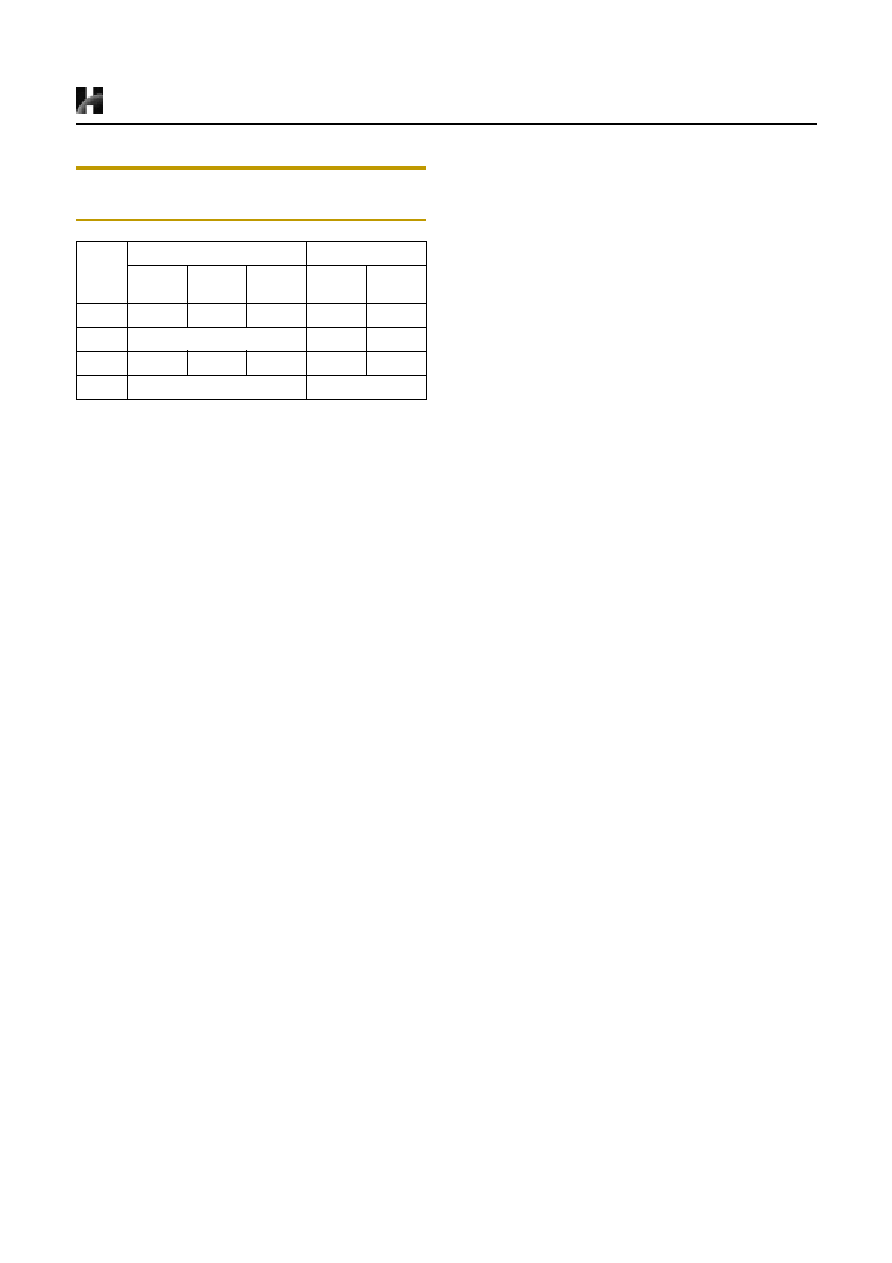
HYUNDAI MicroElectronics
HMS87C1304A/HMS87C1302A
Jan. 2001
Preliminary
23
Note: Several names are given at same address. Refer to
below table.
Stack Area
The stack provides the area where the return address is
saved before a jump is performed during the processing
routine at the execution of a subroutine call instruction or
the acceptance of an interrupt.
When returning from the processing routine, executing the
subroutine return instruction [RET] restores the contents of
the program counter from the stack; executing the interrupt
return instruction [RETI] restores the contents of the pro-
gram counter and flags.
The save/restore locations in the stack are determined by
the stack pointed (SP). The SP is automatically decreased
after the saving, and increased before the restoring. This
means the value of the SP indicates the stack location
number for the next save.
Addr.
When read
When write
Timer
Mode
Capture
Mode
PWM
Mode
Timer
Mode
PWM
Mode
D1H
T0
CDR0
-
TDR0
-
D3H
-
TDR1
T1PPR
D4H
T1
CDR1
T1PDR
-
T1PDR
ECH
BITR
CKCTLR
Table 8-2 Various Register Name in Same Address
Preliminary

HMS87C1304A/HMS87C1302A
HYUNDAI MicroElectronics
24
Preliminary
Jan. 2001
Address
Name
Bit 7
Bit 6
Bit 5
Bit 4
Bit 3
Bit 2
Bit 1
Bit 0
C0H
RA
RA Port Data Register
C1H
RAIO
RA Port Direction Register
C2H
RB
RB Port Data Register
C3H
RBIO
RB Port Direction Register
C4H
RC
RC Port Data Register
C5H
RCIO
RC Port Direction Register
C6H
RD
RD Port Data Register
C7H
RDIO
RD Port Direction Register
CAH
RAFUNC
ANSEL7
ANSEL6
ANSEL5
ANSEL4
ANSEL3
ANSEL2
ANSEL1
ANSEL0
CBH
RBFUNC
TMR2OV
EC1I
PWM1O
PWM0O
INT1I
INT0I
BUZO
AVREFS
CCH
PUPSEL
-
-
-
-
PUPSEL1 PUPSEL0
D0H
TM0
-
-
CAP0
T0CK2
T0CK1
T0CK0
T0CN
T0ST
D1H
T0/TDR0/
CDR0
Timer0 Register / Timer0 Data Register / Capture0 Data Register
D2H
TM1
POL
16BIT
PWM0E
CAP1
T1CK1
T1CK0
T1CN
T1ST
D3H
TDR1/
T1PPR
Timer1 Data Register / PWM0 Period Register
D4H
T1/CDR1/
T1PDR
Timer1 Register / Capture1 Data Register / PWM0 Duty Register
D5H
PWM0HR
PWM0 High Register
DEH
BUR
BUCK1
BUCK0
BUR5
BUR4
BUR3
BUR2
BUR1
BUR0
E2H
IENH
INT0E
INT1E
T0E
T1E
-
-
-
-
E3H
IENL
ADE
WDTE
BITE
-
-
-
-
-
E4H
IRQH
INT0IF
INT1IF
T0IF
T1IF
-
-
-
-
E5H
IRQL
ADIF
WDTIF
BITIF
-
-
-
-
-
E6H
IEDS
-
-
-
-
IED1H
IED1L
IED0H
IED0L
EAH
ADCM
-
-
ADEN
ADS2
ADS1
ADS0
ADST
ADSF
EBH
ADCR
ADC Result Data Register
ECH
BITR
1
Basic Interval Timer Data Register
ECH
CKCTLR
1
-
WAKEUP
RCWDT
WDTON
BTCL
BTS2
BTS1
BTS0
EDH
WDTR
WDTCL
7-bit Watchdog Counter Register
EFH
PFDR
2
-
-
-
-
-
PFDIS
PFDM
PFDS
Table 8-3 Control Registers of HMS87C1304A and HMS87C1302A
These registers of shaded area can not be accessed by bit manipulation instruction as "SET1, CLR1", but should be accessed by
register operation instruction as "LDM dp,#imm".
1.The register BITR and CKCTLR are located at same address. Address ECH is read as BITR, written to CKCTLR.
2.The register PFDR only be implemented on devices, not on In-circuit Emulator.
Preliminary

HYUNDAI MicroElectronics
HMS87C1304A/HMS87C1302A
Jan. 2001
Preliminary
25
8.4 Addressing Mode
The HMS87C1304A and HMS87C1302A uses six ad-
dressing modes;
� Register addressing
� Immediate addressing
� Direct page addressing
� Absolute addressing
� Indexed addressing
� Register-indirect addressing
(1) Register Addressing
Register addressing accesses the A, X, Y, C and PSW.
(2) Immediate Addressing
#imm
In this mode, second byte (operand) is accessed as a data
immediately.
Example:
0435
ADC
#35H
E45535
LDM
35H,#55H
(3) Direct Page Addressing
dp
In this mode, a address is specified within direct page.
Example;
C535
LDA
35H
;A
RAM[35H]
(4) Absolute Addressing
!abs
Absolute addressing sets corresponding memory data to
Data, i.e. second byte(Operand I) of command becomes
lower level address and third byte (Operand II) becomes
upper level address.
With 3 bytes command, it is possible to access to whole
memory area.
ADC, AND, CMP, CMPX, CMPY, EOR, LDA, LDX,
LDY, OR, SBC, STA, STX, STY
Example;
0735F0
ADC
!0F035H
;A
ROM[0F035H]
35
A+35H+C
A
04
MEMORY
E4
0F100
H
data
55H
~
~
~
~
data
0035
H
�
35
0F102
H
55
0F101
H
�
data
35
0035
H
0F551
H
data
A
�
�
~
~
~
~
C5
0F550
H
07
0F100
H
~
~
~
~
data
0F035
H
�
F0
0F102
H
35
0F101
H
�
A+data+C
A
address: 0F035
Preliminary
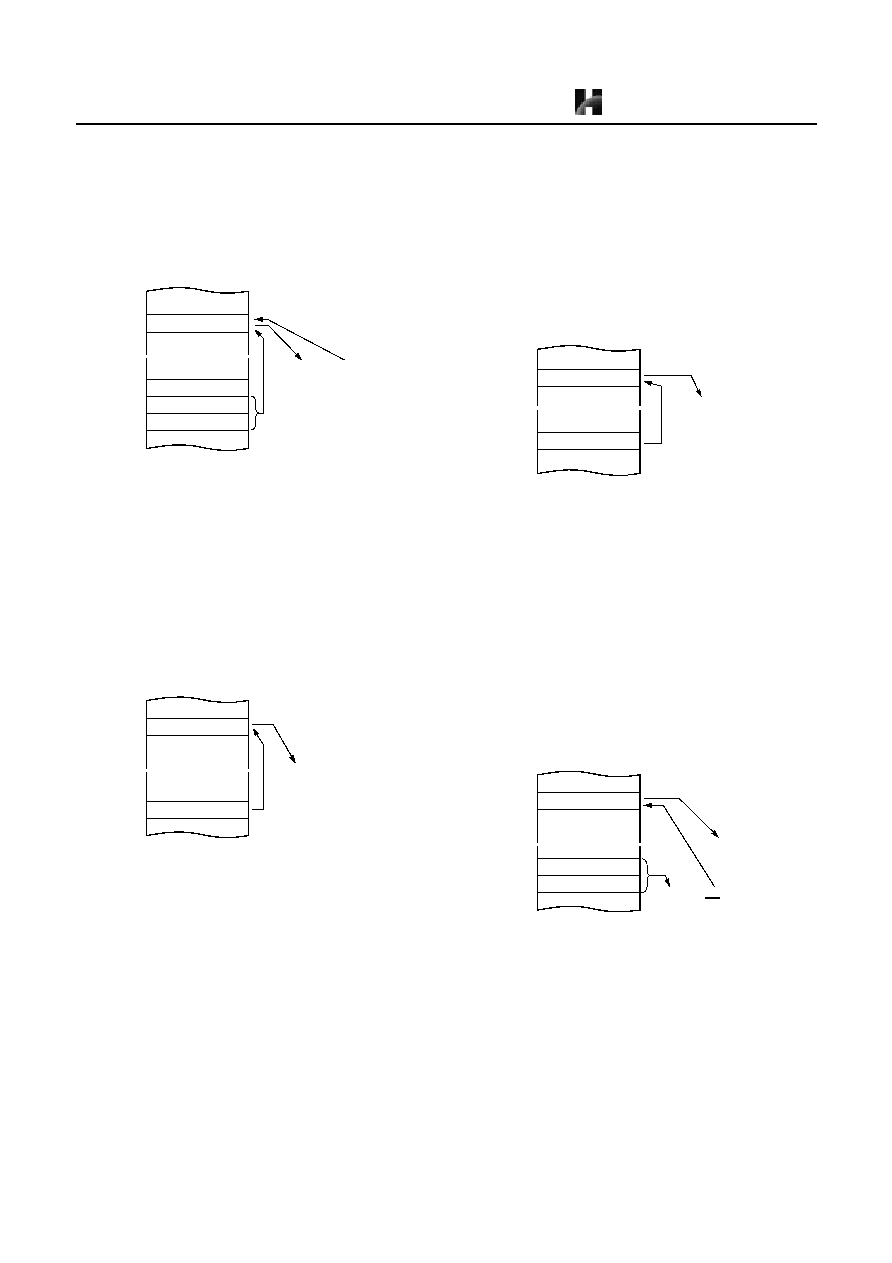
HMS87C1304A/HMS87C1302A
HYUNDAI MicroElectronics
26
Preliminary
Jan. 2001
The operation within data memory (RAM)
ASL, BIT, DEC, INC, LSR, ROL, ROR
Example; Addressing accesses the address 0135
H
.
983500
INC
!0035H
;A
RAM[035H]
(5) Indexed Addressing
X indexed direct page (no offset)
{X}
In this mode, a address is specified by the X register.
ADC, AND, CMP, EOR, LDA, OR, SBC, STA, XMA
Example; X=15
H
D4
LDA
{X}
;ACC
RAM[X].
X indexed direct page, auto increment
{X}+
In this mode, a address is specified within direct page by
the X register and the content of X is increased by 1.
LDA, STA
Example; X=35
H
DB
LDA
{X}+
X indexed direct page (8 bit offset)
dp+X
This address value is the second byte (Operand) of com-
mand plus the data of
-register. And it assigns the mem-
ory in Direct page.
ADC, AND, CMP, EOR, LDA, LDY, OR, SBC, STA
STY, XMA, ASL, DEC, INC, LSR, ROL, ROR
Example; X=015
H
C645
LDA
45H+X
98
0F100
H
~
~
~
~
data
0035
H
�
00
0F102
H
35
0F101
H
�
data+1
data
�
address: 0035
data
D4
15
H
0E550
H
data
A
�
�
~
~
~
~
data
DB
35
H
data
A
�
�
~
~
~
~
36H
X
data
45
5A
H
0E551
H
data
A
�
�
~
~
~
~
C6
0E550
H
45H+15H=5AH
�
Preliminary

HYUNDAI MicroElectronics
HMS87C1304A/HMS87C1302A
Jan. 2001
Preliminary
27
Y indexed direct page (8 bit offset)
dp+Y
This address value is the second byte (Operand) of com-
mand plus the data of Y-register, which assigns Memory in
Direct page.
This is same with above (2). Use Y register instead of X.
Y indexed absolute
!abs+Y
Sets the value of 16-bit absolute address plus Y-register
data as Memory. This addressing mode can specify mem-
ory in whole area.
Example; Y=55
H
D500FA
LDA
!0FA00H+Y
(6) Indirect Addressing
Direct page indirect
[dp]
Assigns data address to use for accomplishing command
which sets memory data(or pair memory) by Operand.
Also index can be used with Index register X,Y.
JMP, CALL
Example;
3F35
JMP
[35H]
X indexed indirect
[dp+X]
Processes memory data as Data, assigned by 16-bit pair
m e m o r y w h i c h i s d e t e r m i n e d b y p a i r d a t a
[dp+X+1][dp+X] Operand plus
X-register data in Direct
page.
ADC, AND, CMP, EOR, LDA, OR, SBC, STA
Example; X=10
H
1625
ADC
[25H+X]
D5
0F100
H
data
A
�
~
~
~
~
data
0FA55
H
0FA00H+55H=0FA55H
�
FA
0F102
H
00
0F101
H
�
0A
35
H
jump to address 0E30A
H
�
~
~
~
~
35
0FA00
H
E3
36
H
�
3F
0E30A
H
NEXT
~
~
~
~
05
35
H
0E005
H
~
~
~
~
25
0FA00
H
E0
36
H
16
0E005
H
data
~
~
~
~
�
A + data + C
A
25 + X(10) = 35
H
�
�
Preliminary
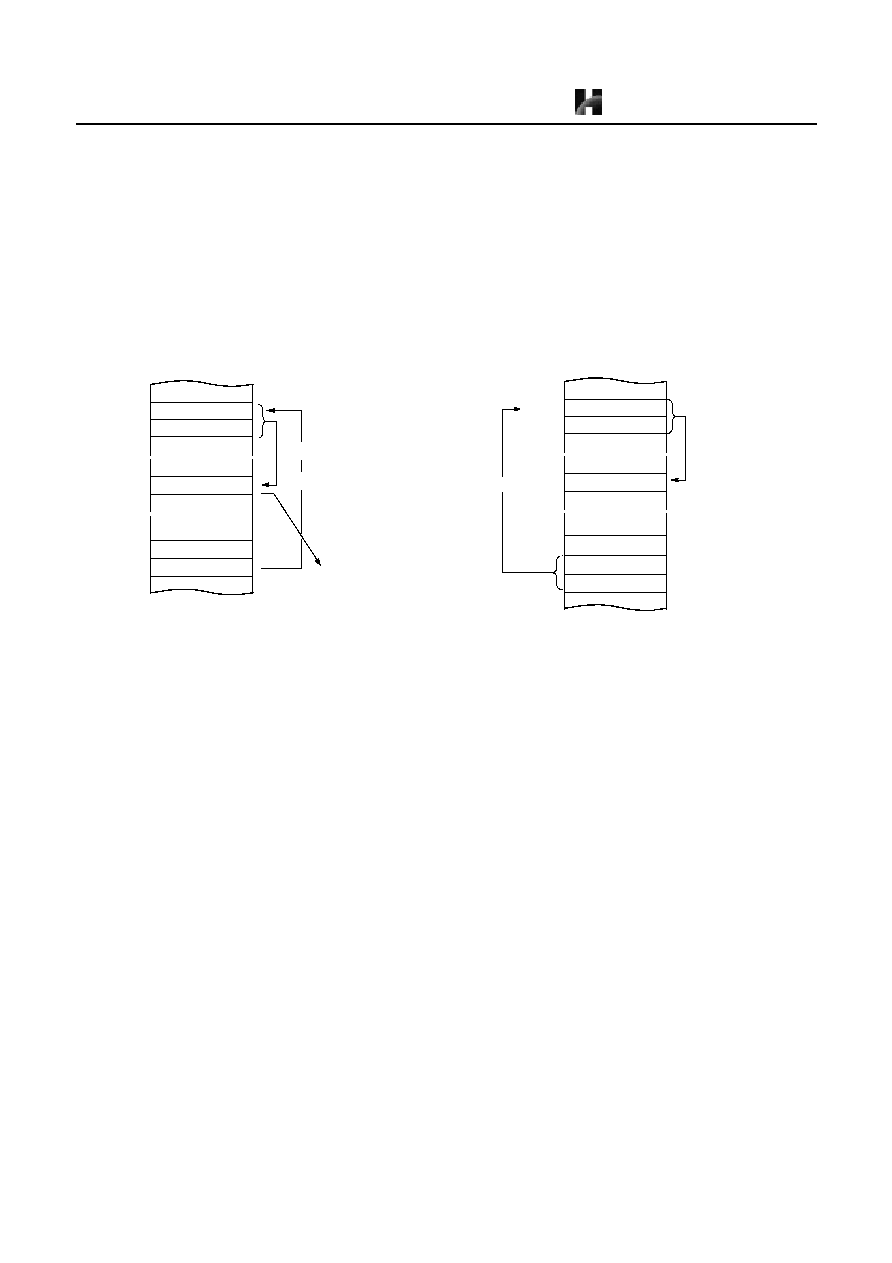
HMS87C1304A/HMS87C1302A
HYUNDAI MicroElectronics
28
Preliminary
Jan. 2001
Y indexed indirect
[dp]+Y
Processes memory data as Data, assigned by the data
[dp+1][dp] of 16-bit pair memory paired by Operand in Di-
rect page
plus Y-register data.
ADC, AND, CMP, EOR, LDA, OR, SBC, STA
Example; Y=10
H
1725
ADC
[25H]+Y
Absolute indirect
[!abs]
The program jumps to address specified by 16-bit absolute
address.
JMP
Example;
1F25E0
JMP
[!0C025H]
05
25
H
0E005
H
+ Y(10) = 0E015
H
�
~
~
~
~
25
0FA00
H
E0
26
H
�
17
0E015
H
data
~
~
~
~
�
A + data + C
A
25
0E025
H
jump to
~
~
~
~
E0
0FA00
H
E7
0E026
H
�
25
0E725
H
NEXT
~
~
~
~
1F
PROGRAM MEMORY
�
address 0E30A
H
Preliminary
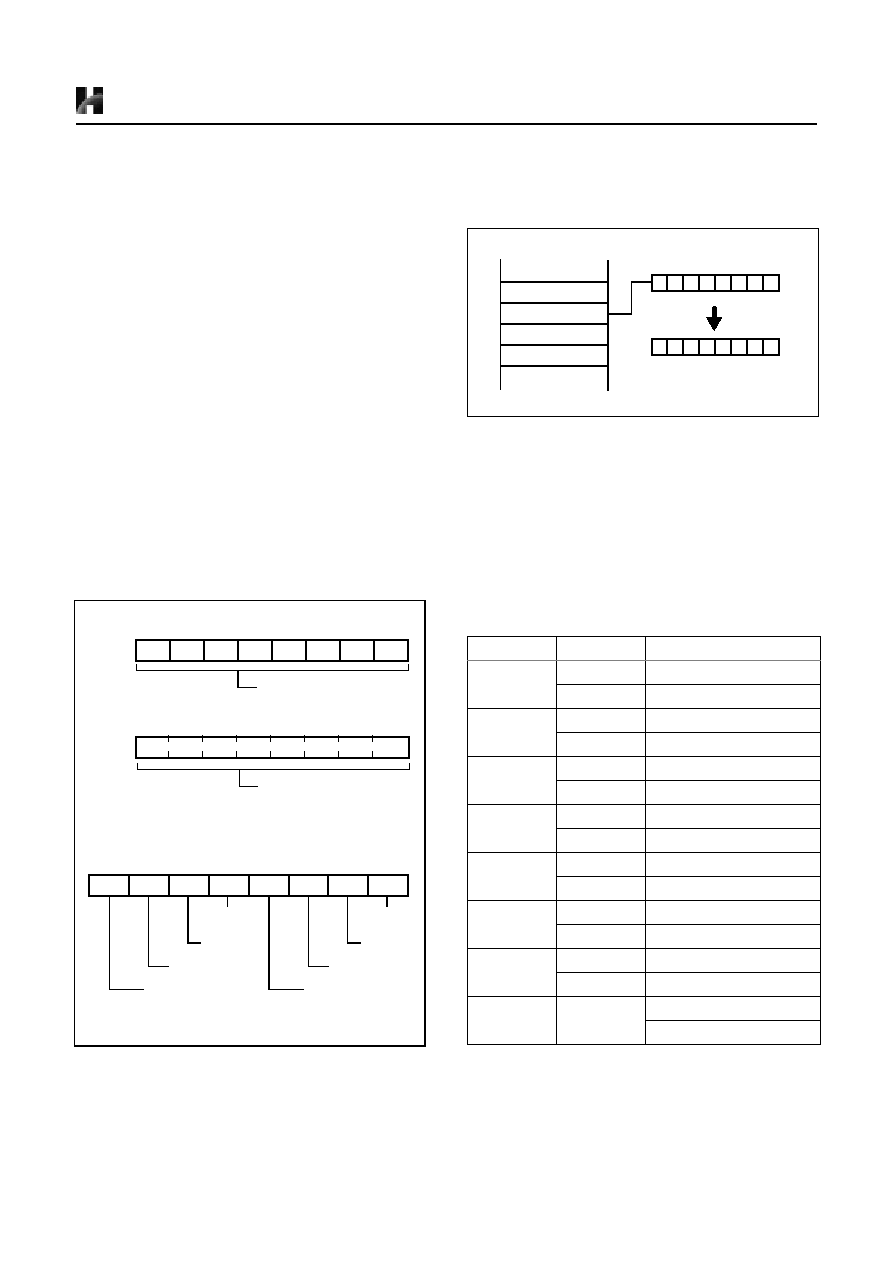
HYUNDAI MicroElectronics
HMS87C1304A/HMS87C1302A
Jan. 2001
Preliminary
29
9. I/O PORTS
The HMS87C1304A and HMS87C1302A has four ports,
RA, RB, RC and RD. These ports pins may be multiplexed
with an alternate function for the peripheral features on the
device. In general, when a initial reset state, all ports are
used as a general purpose input port.
All pins have data direction registers which can set these
ports as output or input. A "1" in the port direction register
defines the corresponding port pin as output. Conversely,
write "0" to the corresponding bit to specify as an input
pin. For example, to use the even numbered bit of RA as
output ports and the odd numbered bits as input ports, write
"55
H
" to address C1
H
(RA direction register) during initial
setting as shown in Figure 9-1 .
Reading data register reads the status of the pins whereas
writing to it will write to the port latch.
Figure 9-1 Example of port I/O assignment
9.1 RA and RAIO registers
RA is an 8-bit bidirectional I/O port (address C0
H
). Each
port can be set individually as input and output through the
RAIO register (address C1
H
).
RA7~RA1 ports are multiplexed with Analog Input Port
(AN7~AN1) and RA0 port is multiplexed with Event
Counter Input Port (EC0)
.
Figure 9-2 Registers of Port RA
The control register RAFUNC (address CA
H
) controls to
select alternate function. After reset, this value is "0", port
may be used as general I/O ports. To select alternate func-
tion such as Analog Input or External Event Counter Input,
write "1" to the corresponding bit of RAFUNC.Regardless
of the direction register RAIO, RAFUNC is selected to use
as alternate functions, port pin can be used as a correspond-
ing alternate features (RA0/EC0 is controlled by RB-
FUNC)
I: INPUT PORT
WRITE "55H" TO PORT RA DIRECTION REGISTER
0
1
0
1
0
1
0
1
I
O
I
O
I
O
I
O
RA DATA
RB DATA
RA DIRECTION
RB DIRECTION
C0H
C1H
C2H
C3H
7
6
5
4
3
2
1
0
BIT
7
6
5
4
3
2
1
0 PORT
O: OUTPUT PORT
RA7 RA6 RA5 RA4 RA3 RA2 RA1 RA0
INPUT / OUTPUT DATA
0 : INPUT PORT
1 : OUTPUT PORT
DIRECTION SELECT
RA Data Register
RA
ADDRESS : C0H
RESET VALUE : Undefined
RA Direction Register
RAIO
ADDRESS : C1H
RESET VALUE : 00000000
ANSEL0
RA Function Selection Register
RAFUNC
ADDRESS : CAH
RESET VALUE : 00000000
ANSEL7
ANSEL1
ANSEL2
ANSEL3
ANSEL4
ANSEL5
ANSEL6
0 : RB0
1 : AN0
0 : RA1
1 : AN1
0 : RA2
1 : AN2
0 : RA3
1 : AN3
0 : RA4
1 : AN4
0 : RA5
1 : AN5
0 : RA6
1 : AN6
0 : RA7
1 : AN7
PORT
RAFUNC.7~0
Description
RA7/AN7
0
RA7 (Normal I/O Port)
1
AN7 (ADS2~0=111)
RA6/AN6
0
RA6 (Normal I/O Port)
1
AN6 (ADS2~0=110)
RA5/AN5
0
RA5 (Normal I/O Port)
1
AN5 (ADS2~0=101)
RA4/AN4
0
RA4 (Normal I/O Port)
1
AN4 (ADS2~0=100)
RA3/AN3
0
RA3 (Normal I/O Port)
1
AN3 (ADS2~0=011)
RA2/AN2
0
RA2 (Normal I/O Port)
1
AN2 (ADS2~0=010)
RA1/AN1
0
RA1 (Normal I/O Port)
1
AN1 (ADS2~0=001)
RA0/EC0
1
1. This port is not an Analog Input port, but Event Counter clock
source input port. ECO is controlled by setting TOCK2~0 =
111. The bit RAFUNC.0 (ANSEL0) controls the RB0/AN0/AVref
port (Refer to Port RB).
RA0 (Normal I/O Port)
EC0 (T0CK2~0=111)
Preliminary
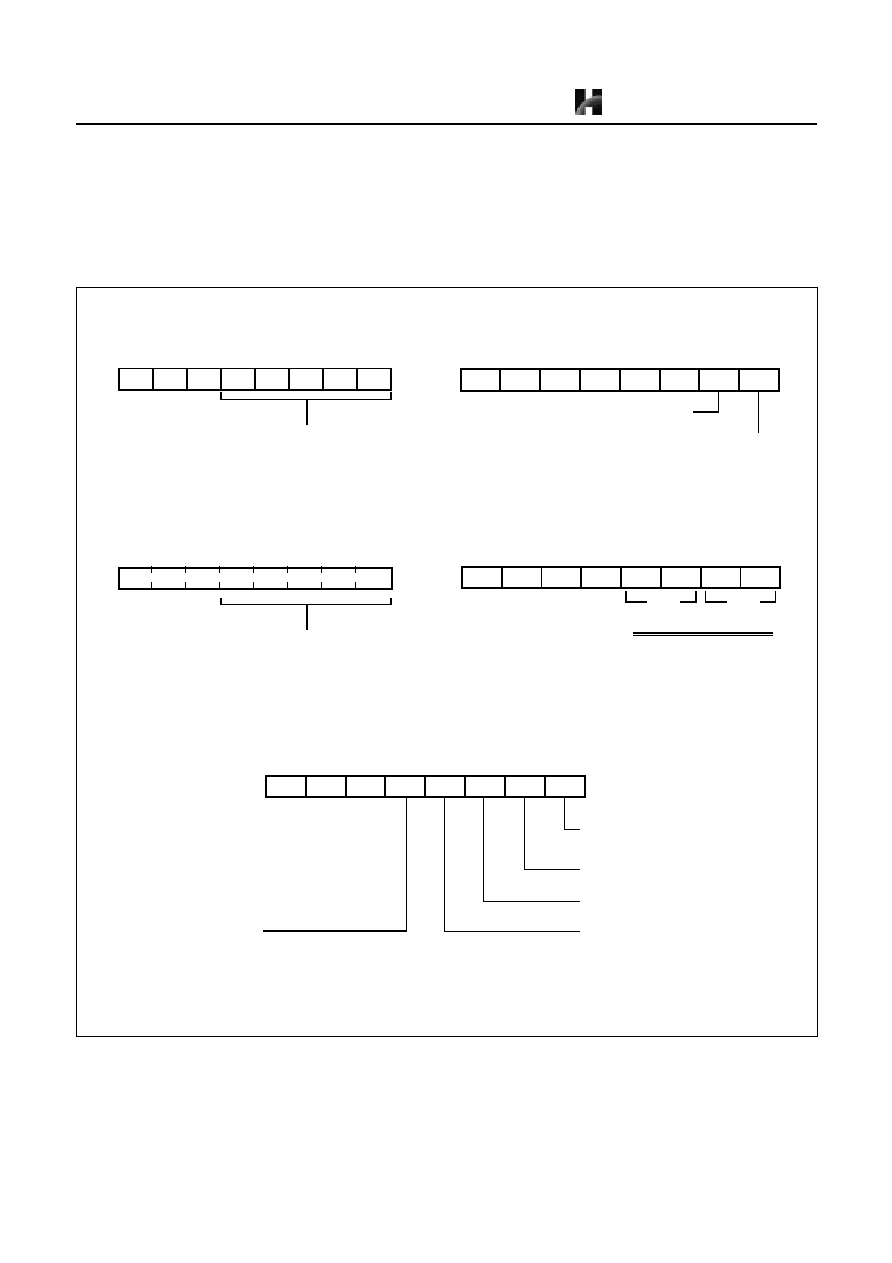
HMS87C1304A/HMS87C1302A
HYUNDAI MicroElectronics
30
Preliminary
Jan. 2001
9.2 RB and RBIO registers
RB is a 5-bit bidirectional I/O port (address C2
H
). Each
pin can be set individually as input and output through the
RBIO register (address C3
H
). In addition, Port RB is mul-
tiplexed with various special features. The control register
RBFUNC (address CB
H
) controls to select alternate func-
tion. After reset, this value is "0", port may be used as gen-
eral I/O ports. To select alternate function such as External
interrupt or Timer compare output, write "1" to the corre-
sponding bit of RBFUNC.
Figure 9-3 Registers of Port RB
Regardless of the direction register RBIO, RBFUNC is se-
lected to use as alternate functions, port pin can be used as
a corresponding alternate features.
-
RB4
RB3 RB2 RB1 RB0
INPUT / OUTPUT DATA
0 : INPUT PORT
1 : OUTPUT PORT
DIRECTION SELECT
RB Data Register
RB
ADDRESS : C2H
RESET VALUE : Undefined
RB Direction Register
RBIO
ADDRESS : C3H
RESET VALUE : ---00000
AVREFS
RB Function Selection Register
RBFUNC
ADDRESS : CBH
RESET VALUE : ---00000
BUZO
INT0I
INT1I
PWM0O
0 : RB0 when ANSEL0 = 0
1 : AVref
0 : RB1
1 : BUZ Output
0 : RB4
1 : PWM0 Output or
0 : RB2
1 : INT0
0 : RB3
1 : INT1
PUP0
Pull-up Selection Register
PUPSEL
ADDRESS : CCH
RESET VALUE : ------00
-
PUP1
-
-
-
0 : No Pull-up
1 : With Pull-up
0 : No Pull-up
1 : With Pull-up
IED0L
Interrupt Edge Selection Register
IEDS
ADDRESS : E6H
RESET VALUE : ----0000
IED0H
IED1L
IED1H
External Interrupt Edge Select
INT0
INT1
00 : Normal I/O port
01 : Falling (1-to-0 transition)
10 : Rising (0-to-1 transition)
11 : Both (Rising & Falling)
Compare Output
RB0 / INT0 Pull-up
RB1 / INT1 Pull-up
AN0 when ANSEL0 = 1
-
-
-
-
-
-
-
-
-
-
-
Preliminary
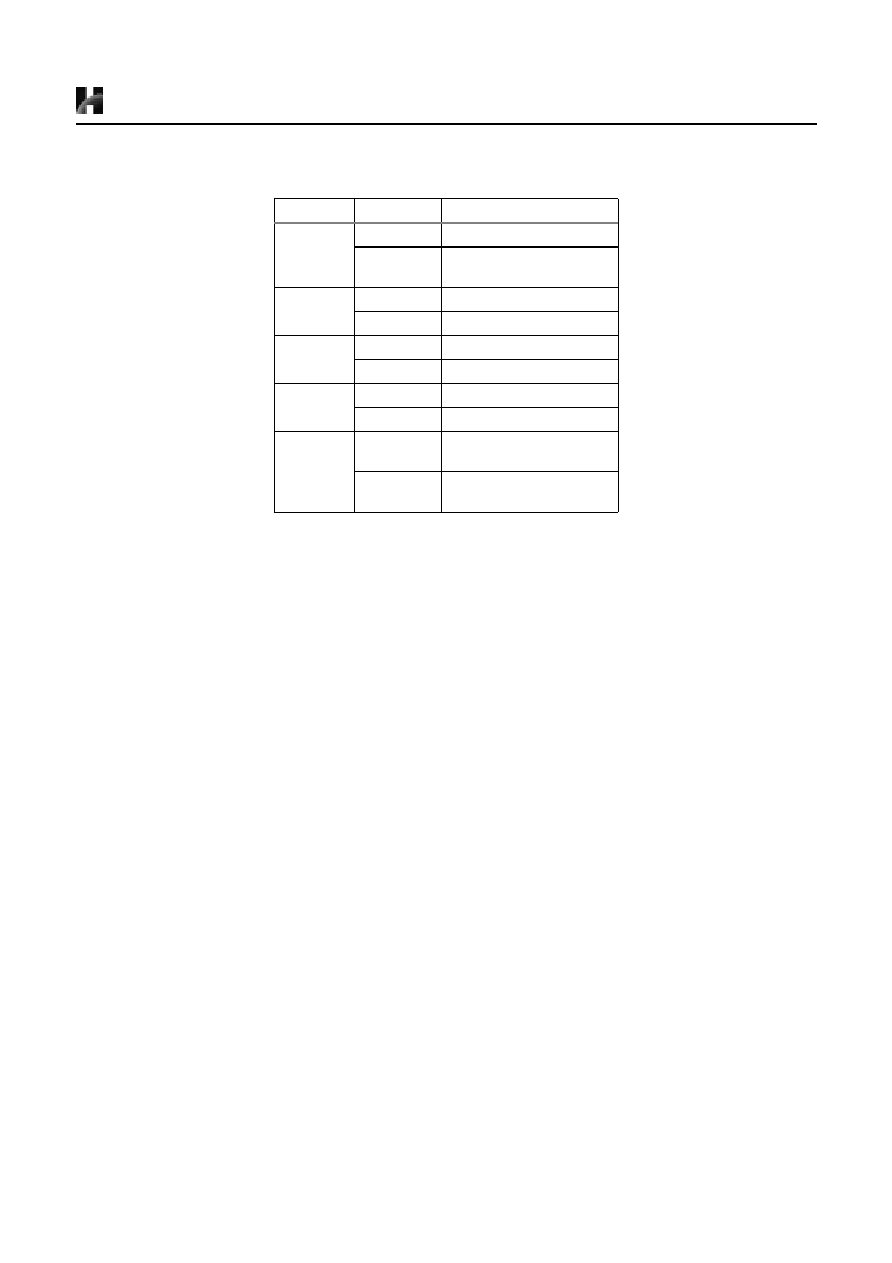
HYUNDAI MicroElectronics
HMS87C1304A/HMS87C1302A
Jan. 2001
Preliminary
31
PORT
RBFUNC.4~0
Description
RB4/
PWM0/
COMP0
0
RB4 (Normal I/O Port)
1
PWM0 Output /
Timer1 Compare Output
RB3/INT1
0
RB3 (Normal I/O Port)
1
External Interrupt Input 1
RB2/INT0
0
RB2 (Normal I/O Port)
1
External Interrupt Input 0
RB1/BUZ
0
RB1 (Normal I/O Port)
1
Buzzer Output
RB0/AN0/
AVref
0
1
1. When ANSEL0 = "0", this port is defined for normal I/O port
(RB0).
When ANSEL0 = "1" and ADS2~0 = "000", this port
can be used Analog Input Port (AN0).
RB0 (Normal I/O Port)/
AN0 (ANSEL0=1)
1
2
2. When this bit set to "1", this port defined for AVref, so it can
not be used Analog Input Port AN0 and Normal I/O
Port RB0.
External Analog Reference
Voltage
Preliminary
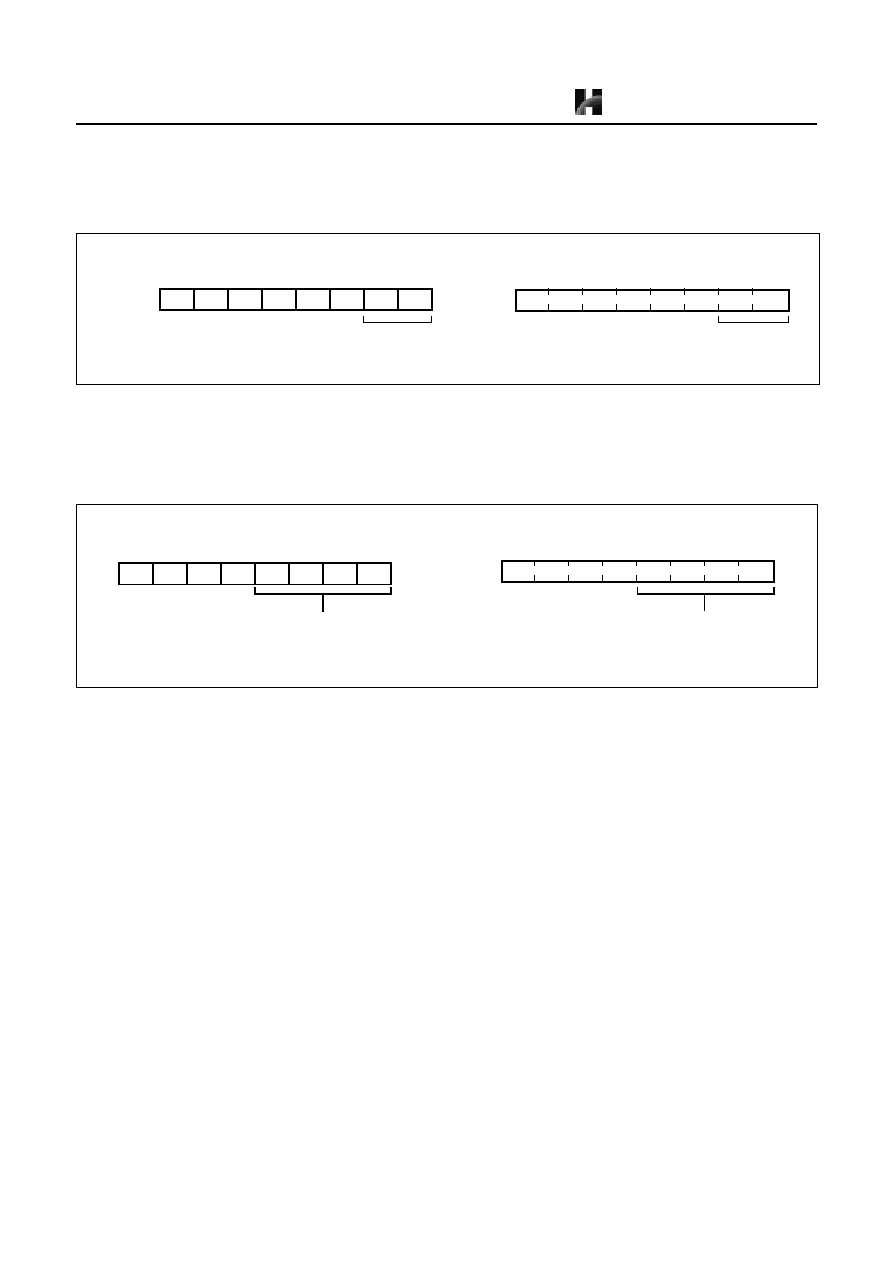
HMS87C1304A/HMS87C1302A
HYUNDAI MicroElectronics
32
Preliminary
Jan. 2001
9.3 RC and RCIO registers
RC is a 2-bit bidirectional I/O port (address C4
H
). Each
pin can be set individually as input and output through the
RCIO register (address C5
H
).
Figure 9-4 Registers of Port RC
9.4 RD and RDIO registers
RD is a 4-bit bidirectional I/O port (address C6
H
). Each
pin can be set individually as input and output through the
RDIO register (address C7
H
).
Figure 9-5 Registers of Port RD
-
RC1
RC0
INPUT / OUTPUT DATA
0 : INPUT PORT
1 : OUTPUT PORT
DIRECTION SELECT
RC Data Register
RC
ADDRESS : C4H
RESET VALUE : Undefined
RC Direction Register
RCIO
ADDRESS : C5H
RESET VALUE : ------00
-
-
-
-
-
RD2 RD1 RD0
INPUT / OUTPUT DATA
0 : INPUT PORT
1 : OUTPUT PORT
DIRECTION SELECT
RD Data Register
RD
ADDRESS : C6H
RESET VALUE : Undefined
RD Direction Register
RDIO
ADDRESS : C7H
RESET VALUE : -----000
RD3
-
-
-
-
Preliminary
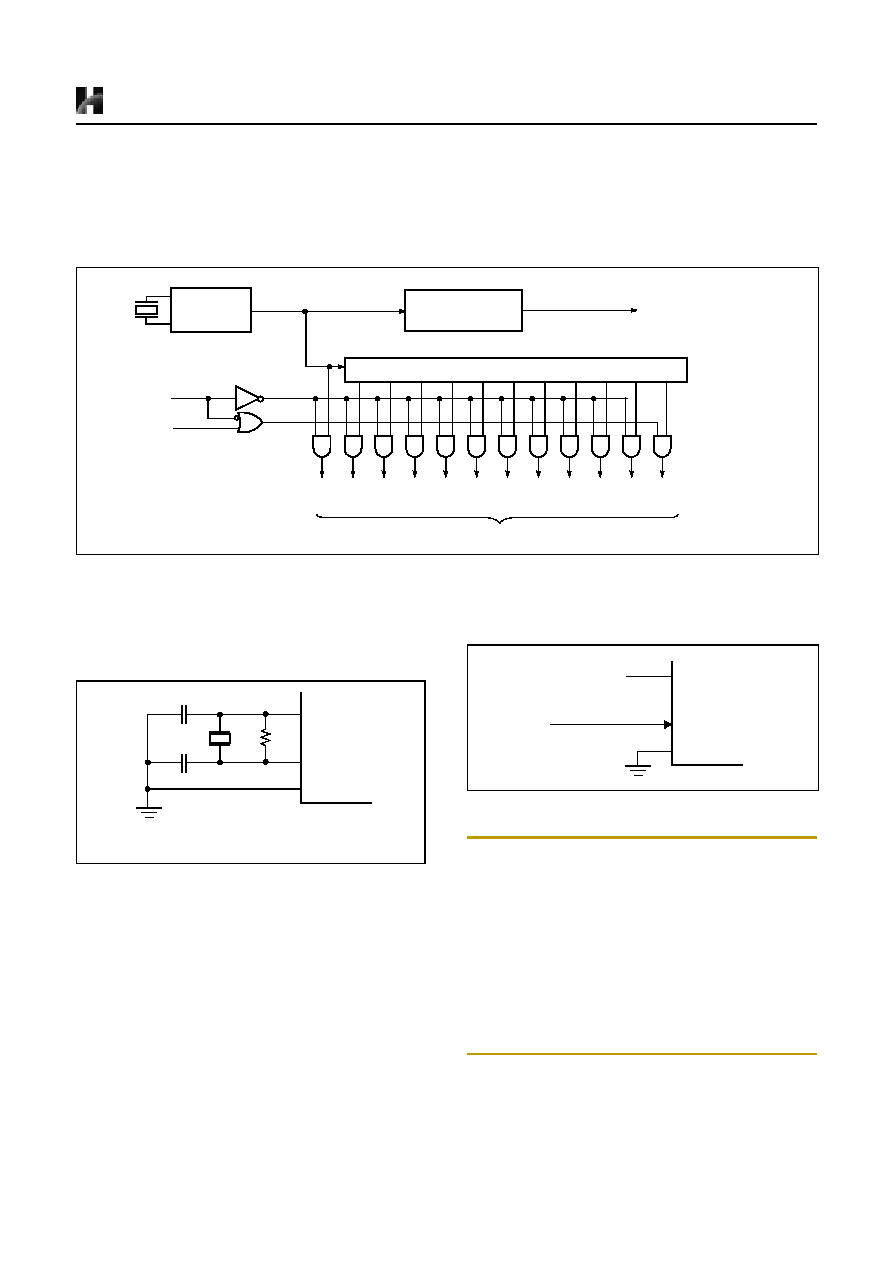
HYUNDAI MicroElectronics
HMS87C1304A/HMS87C1302A
Jan. 2001
Preliminary
33
10. CLOCK GENERATOR
The clock generator produces the basic clock pulses which
provide the system clock to be supplied to the CPU and pe-
ripheral hardware.
The main system clock oscillator oscillates
with a crystal resonator or a ceramic resonator
connected to the
Xin and Xout pins. External clocks can be input to the main
system clock oscillator. In this case, input a clock signal to
the Xin pin and open the Xout pin.
Figure 10-1 Block Diagram of Clock Pulse Generator
10.1 Oscillation Circuit
X
IN
and X
OUT
are the input and output, respectively, a in-
verting amplifier which can be set for use as an on-chip os-
cillator, as shown in Figure 10-2 .
Figure 10-2 Oscillator Connections
To drive the device from an external clock source, Xout
should be left unconnected while Xin is driven as shown in
Figure 10-3 . There are no requirements on the duty cycle
of the external clock signal, since the input to the internal
clocking circuitry is through a divide-by-two flip-flop, but
minimum and maximum high and low times specified on
the data sheet must be observed.
Oscillation circuit is designed to be used either with a ce-
ramic resonator or crystal oscillator. Since each crystal and
ceramic resonator have their own characteristics, the user
should consult the crystal manufacturer for appropriate
values of external components.
Figure 10-3 External Clock Connections
Note: When using a system clock oscillator, carry out wir-
ing in the broken line area in Figure 10-2 to prevent
any effects from wiring capacities.
- Minimize the wiring length.
- Do not allow wiring to intersect with other signal
conductors.
- Do not allow wiring to come near changing high
current.
- Set the potential of the grounding position of the
oscillator capacitor to that of V
SS
. Do not ground to
any ground pattern where high current is present.
- Do not fetch signals from the oscillator.
In addition, the HMS87C1304A and HMS87C1302A has
an ability for the external RC oscillated operation. It offers
additional cost savings for timing insensitive applica-
Internal system clock
PRESCALER
CLOCK PULSE
�
1
Peripheral clock
�
2
�
4
�
8
�
16
�
128
�
256
�
512
�
1024
�
32
�
64
GENERATOR
�
2048
STOP
WAKEUP
fxin
OSCILLATION
CIRCUIT
Xout
Xin
Vss
C1
C2
Recommended: C1, C2 = 30pF
�
10pF for Crystals
R1
R1 = 1M
Xout
Xin
Vss
OPEN
External
Clock
Source
Preliminary
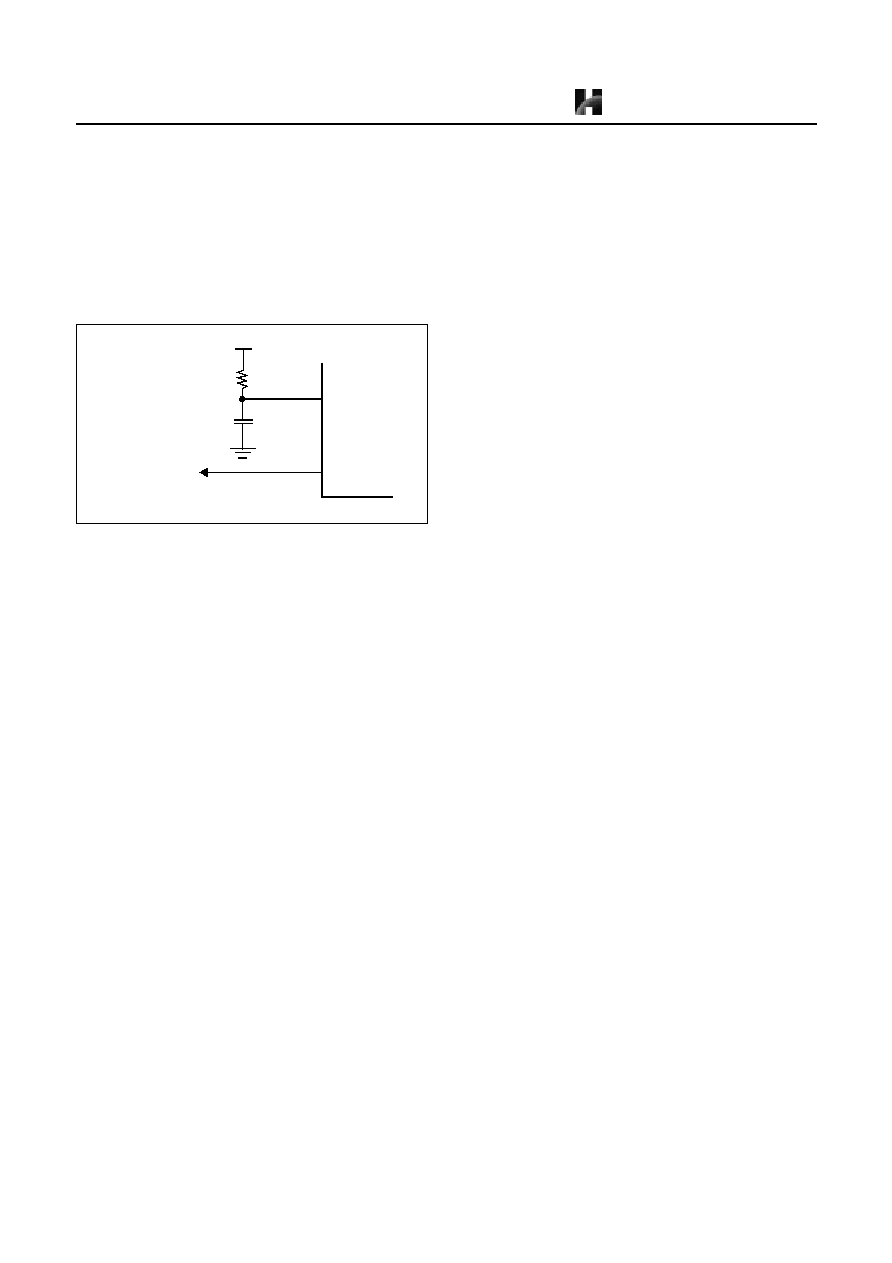
HMS87C1304A/HMS87C1302A
HYUNDAI MicroElectronics
34
Preliminary
Jan. 2001
tions. The RC oscillator frequency is a function of the sup-
ply voltage, the external resistor (Rext) and capacitor
(Cext) values, and the operating temperature.
The user needs to take into account variation due to toler-
ance of external R and C components used. Figure 10-4
shows how the RC combination is connected to the
HMS87C1304A or HMS87C1302A.
Figure 10-4 RC Oscillator Connections
The oscillator frequency, divided by 4, is output from the
Xout pin, and can be used for test purpose or to synchroze
other logic.
To set the RC oscillation, it should be programmed
RCOPT bit to "1" to CONFIG (0FF0
H
). ( Refer to DE-
VICE CONFIGURATION AREA )
Xout
Xin
Vdd
Cext
fxin
�
4
Rext
Preliminary
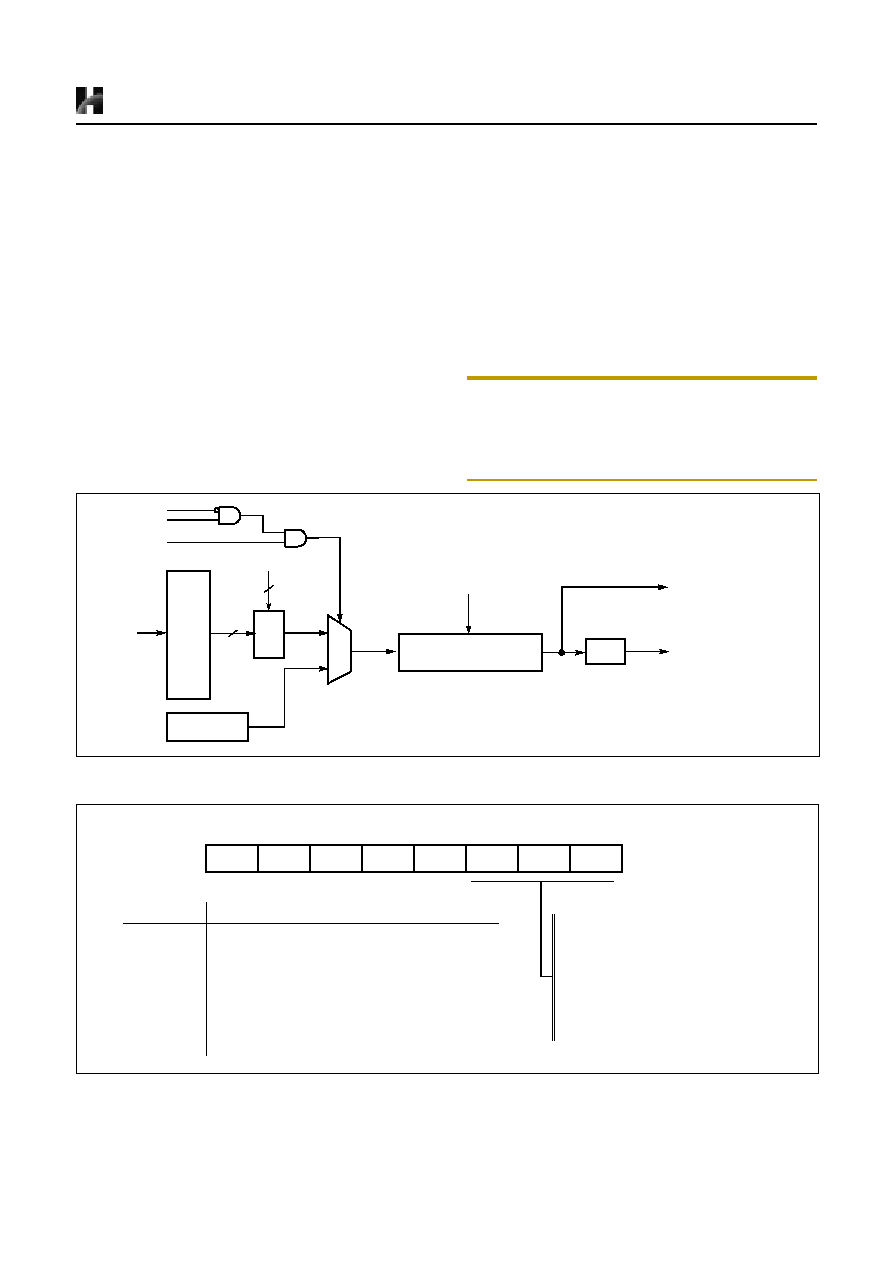
HYUNDAI MicroElectronics
HMS87C1304A/HMS87C1302A
Jan. 2001
Preliminary
35
11. Basic Interval Timer
The HMS87C1304A and HMS87C1302A has one 8-bit
Basic Interval Timer that is free-run, can not stop. Block
diagram is shown in Figure 11-1 .The 8-bit Basic interval
timer register (BITR) is increased every internal count
pulse which is divided by prescaler. Since prescaler has di-
vided ratio by 8 to 1024, the count rate is 1/8 to 1/1024 of
the oscillator frequency. As the count overflows from FF
H
to 00
H
, this overflow causes to generate the Basic interval
timer interrupt. The BITF is interrupt request flag of Basic
interval timer.
When write "1" to bit BTCL of CKCTLR, BITR register is
cleared to "0" and restart to count-up. The bit BTCL be-
comes "0" after one machine cycle by hardware.
If the STOP instruction executed after writing "1" to bit
WAKEUP of CKCTLR, it goes into the wake-up timer
mode. In this mode, all of the block is halted except the os-
cillator, prescaler (only fxin
�
2048) and Timer0.
If the STOP instruction executed after writing "1" to bit
RCWDT of CKCTLR, it goes into the internal RC oscillat-
ed watchdog timer mode. In this mode, all of the block is
halted except the internal RC oscillator, Basic Interval
Timer and Watchdog Timer. More detail informations are
explained in Power Saving Function. The bit WDTON de-
cides Watchdog Timer or the normal 7-bit timer
Note: All control bits of Basic interval timer are in CKCTLR
register which is located at same address of BITR
(address EC
H
). Address EC
H
is read as BITR, writ-
ten to CKCTLR. Therefore, the CKCTLR can not be
accessed by bit manipulation instruction..
Figure 11-1 Block Diagram of Basic Interval Timer
Figure 11-2 CKCTLR: Clock Control Register
�
8
�
16
�
128
�
256
�
512
�
1024
�
32
�
64
0
1
MUX
8
3
fxin
BITR (8BIT)
BITIF
BTS[2:0]
Internal RC OSC
Basic Interval Timer
Interrupt
BTCL
Clear
To Watchdog Timer
STOP
WAKEUP
RCWDT
Clock Control Register
CKCTLR
ADDRESS : ECH
RESET VALUE : -0010111
-
WAKEUP
RCWDT
WDTON
BTCL
BTS2
BTS1
BTS0
Basic Interval Timer Clock Selection
000 : fxin
�
8
001 : fxin
�
16
100 : fxin
�
128
101 : fxin
�
256
110 : fxin
�
512
111 : fxin
�
1024
010 : fxin
�
32
011 : fxin
�
64
Symbol
Function Description
WAKEUP
1 : Enables Wake-up Timer
0 : Disables Wake-up Timer
RCWDT
1 : Enables Internal RC Watchdog Timer
0 : Disables Internal RC Watchdog Time
WDTON
1 : Enables Watchdog Timer
0 : Operates as a 7-bit Timer
BTCL
1 : BITR is cleared and BTCL becomes "0" automatically
after one machine cycle, and BITR continue to count-up
Bit Manipulation Not Available
Preliminary
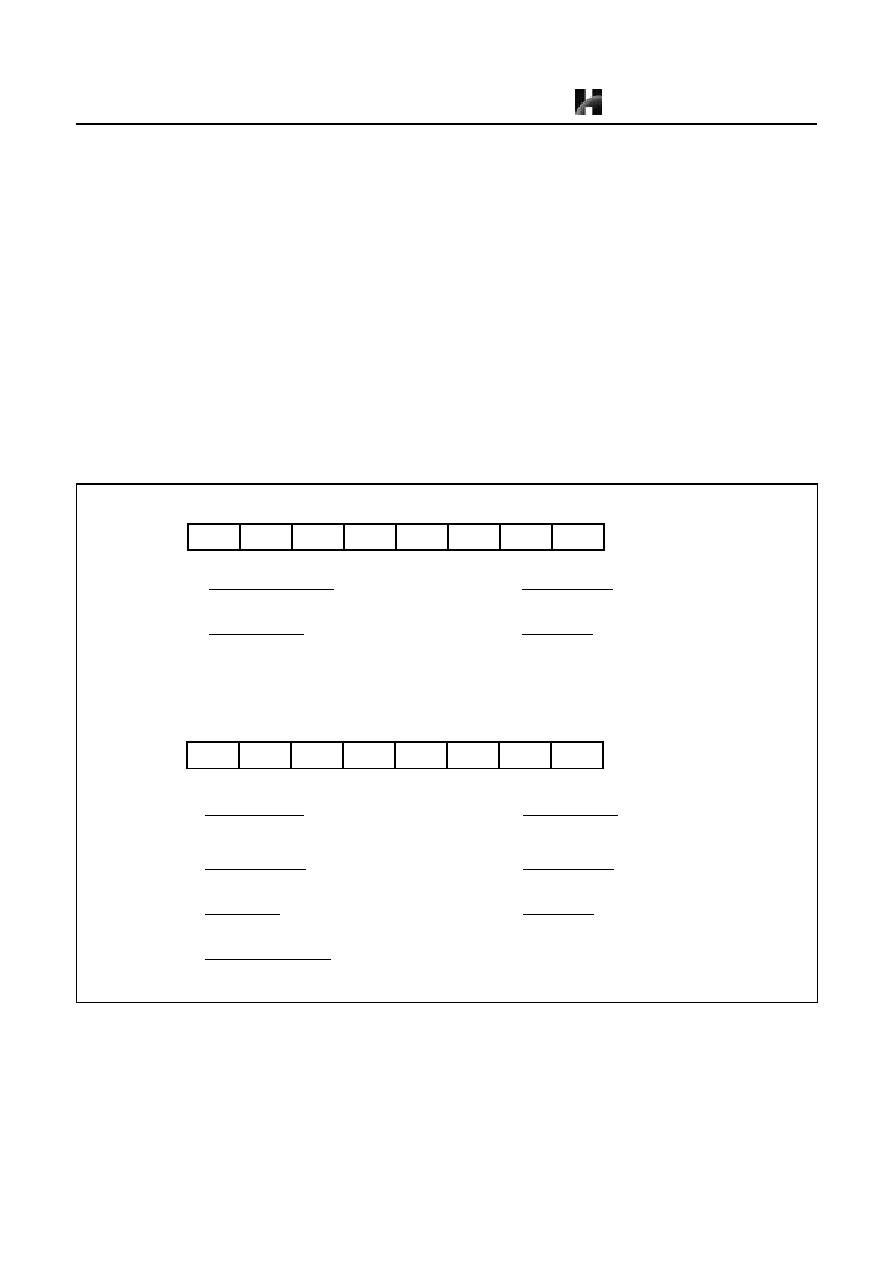
HMS87C1304A/HMS87C1302A
HYUNDAI MicroElectronics
36
Preliminary
Jan. 2001
12. TIMER / COUNTER
The HMS87C1304A and HMS87C1302A has two Timer/
Counter registers. Each module can generate an interrupt
to indicate that an event has occurred (i.e. timer match).
Timer 0 and Timer 1 can be used either the two 8-bit Tim-
er/Counter or one 16-bit Timer/Counter by combining
them.
In the "timer" function, the register is increased every in-
ternal clock input. Thus, one can think of it as counting in-
ternal clock input. Since a least clock consists of 2 and
most clock consists of 2048 oscillator periods, the count
rate is 1/2 to 1/2048 of the oscillator frequency in Timer0.
And Timer1 can use the same clock source too. In addition,
Timer1 has more fast clock source (1/1 to 1/8).
In the "counter" function, the register is increased in re-
sponse to a 0-to-1 (rising edge) transition at its correspond-
ing external input pin, EC0(Timer 0).
In addition the "capture" function, the register is increased
in response external interrupt same with timer function.
When external interrupt edge input, the count register is
captured into capture data register CDRx.
Timer1 is shared with "PWM" function and "Compare
output" function
It has seven operating modes: "8-bit timer/counter", "16-
bit timer/counter", "8-bit capture", "16-bit capture", "8-bit
compare output", "16-bit compare output" and "10-bit
PWM" which are selected by bit in Timer mode register
TMx as shown in Figure 12-1 and Table 12-1 .
Figure 12-1 Timer Mode Register (TM0, TM1)
Timer 0 Mode Register
TM0
ADDRESS : D0H
RESET VALUE : --000000
-
-
CAP0
T0CK2
T0CK1
T0CK0
T0CN
T0ST
Timer 1 Mode Register
TM1
ADDRESS : D2H
RESET VALUE : 00000000
POL
16BIT
PWM0E
CAP1
T1CK1
T1CK0
T1CN
T1ST
CAP0
Capture mode selection bit.
0 : Disables Capture
1 : Enables Capture
T0CN
Continue control bit
0 : Stop counting
1 : Start counting continuously
T0CK[2:0]
Input clock selection
000 : fxin
�
2, 100 : fxin
�
128
001 : fxin
�
4, 101 : fxin
�
512
010 : fxin
�
8, 110 : fxin
�
2048
011 : fxin
�
32, 111 : External Event ( EC0 )
T0ST
Start control bit
0 : Stop counting
1 : Counter start ( It must be stop before restart )
POL
PWM Output Polarity
0 : Duty active low
1 : Duty active high
T1CK[2:0]
Input clock selection
00 : fxin 10 : fxin
�
8
01 : fxin
�
2 11 : using the Timer 0 clock
16BIT
16-bit mode selection
0 : 8-bit mode
1 : 16-bit mode
T1CN
Continue control bit
0 : Stop counting
1 : Start counting continuously
PWM0E
PWM enable bit
0 : Disables PWM
1 : Enables PWM
T1ST
Start control bit
0 : Stop counting
1 : Counter start ( It must be stop before restart )
CAP1
Capture mode selection bit.
0 : Disables Capture
1 : Enables Capture
Preliminary
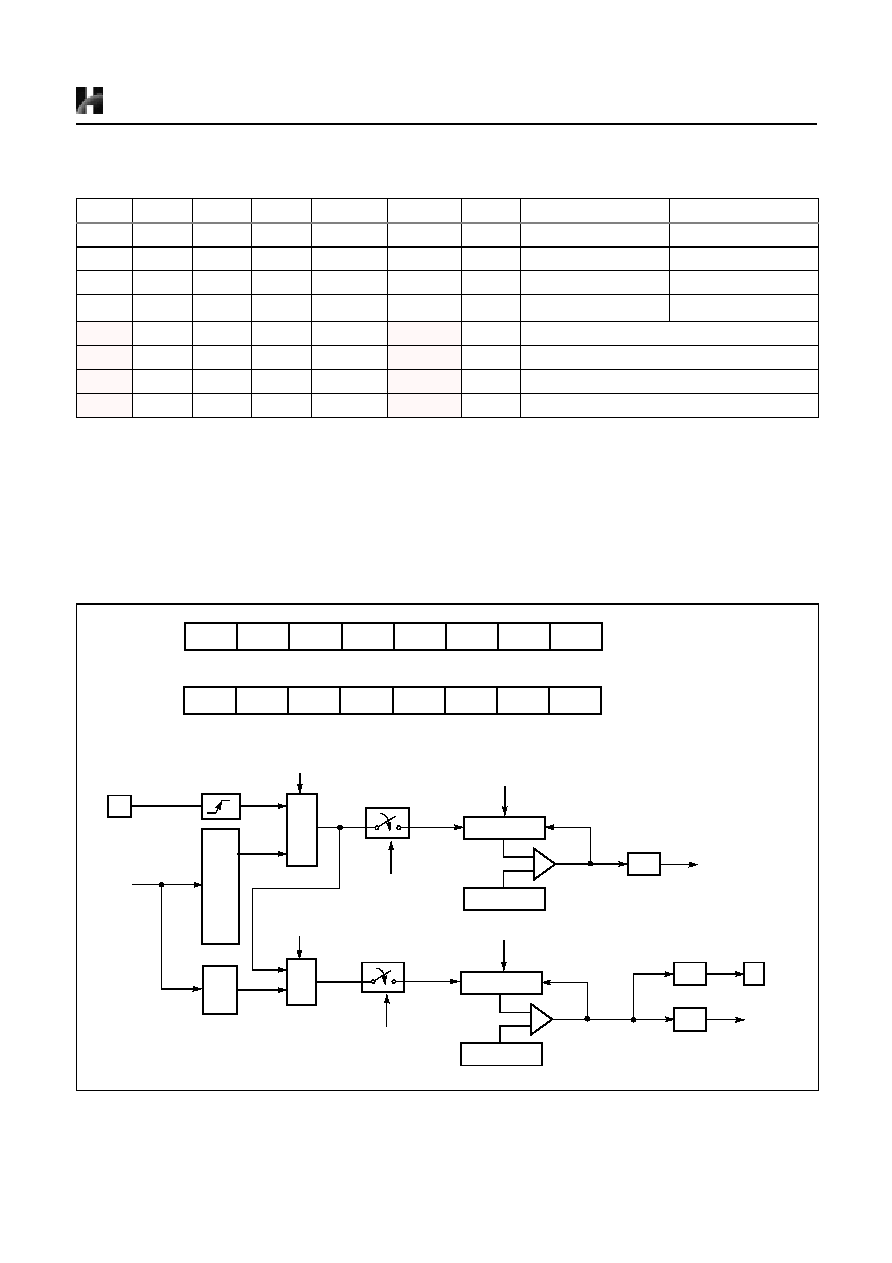
HYUNDAI MicroElectronics
HMS87C1304A/HMS87C1302A
Jan. 2001
Preliminary
37
12.1 8-bit Timer/Counter Mode
The HMS87C1304A and HMS87C1302A has four 8-bit
Timer/Counters, Timer 0 and Timer 1 as shown in Figure
12-2 .
The "timer" or "counter" function is selected by mode reg-
isters TMx as shown in Figure 12-1 and Table 12-1 . To
use as an 8-bit timer/counter mode, bit CAP0 of TM0 is
cleared to "0" and bits 16BIT of TM1 should be cleared to
"0"(Table 12-1 ).
Figure 12-2 8-bit Timer / Counter Mode
16BIT
CAP0
CAP1
PWME
T0CK[2:0]
T1CK[1:0]
PWMO
TIMER 0
TIMER1
0
0
0
0
XXX
XX
0
8-bit Timer
8-bit Timer
0
0
1
0
111
XX
0
8-bit Event Counter
8-bit Capture
0
1
0
0
XXX
XX
1
8-bit Capture
8-bit Compare output
0
X
1
0
1
XXX
XX
1
8-bit Timer/Counter
10-bit PWM
1
0
0
0
XXX
11
0
16-bit Timer
1
0
0
0
111
11
0
16-bit Event Counter
1
1
X
0
XXX
11
0
16-bit Capture
1
0
0
0
XXX
11
1
16-bit Compare output
Table 12-1 Operating Modes of Timer 0 and Timer 1
1. X: The value "0" or "1" corresponding your operation.
�
1
�
2
�
8
TM0
ADDRESS : D0H
RESET VALUE : --000000
-
-
CAP0
T0CK2
T0CK1
T0CK0
T0CN
T0ST
TM1
ADDRESS : D2H
RESET VALUE : 00000000
POL
16BIT
PWME
CAP1
T1CK1
T1CK0
T1CN
T1ST
-
-
0
X
X
X
X
X
X
0
0
0
X
X
X
X
�
2
�
4
�
128
�
512
�
8
�
32
fxin
EC0
Edge Detector
MUX
MUX
1
1
T0 (8-bit)
TDR0 (8-bit)
T0IF
CLEAR
COMPARATOR
TIMER 0
INTERRUPT
T1 (8-bit)
TDR1 (8-bit)
T1IF
CLEAR
COMPARATOR
TIMER 1
INTERRUPT
T0ST
0 : Stop
1 : Start
T1ST
0 : Stop
1 : Start
T0CN
T1CN
T0CK[2:0]
T1CK[1:0]
F/F
COMP0 PIN
�
2048
X: The value "0" or "1" corresponding your operation.
Preliminary
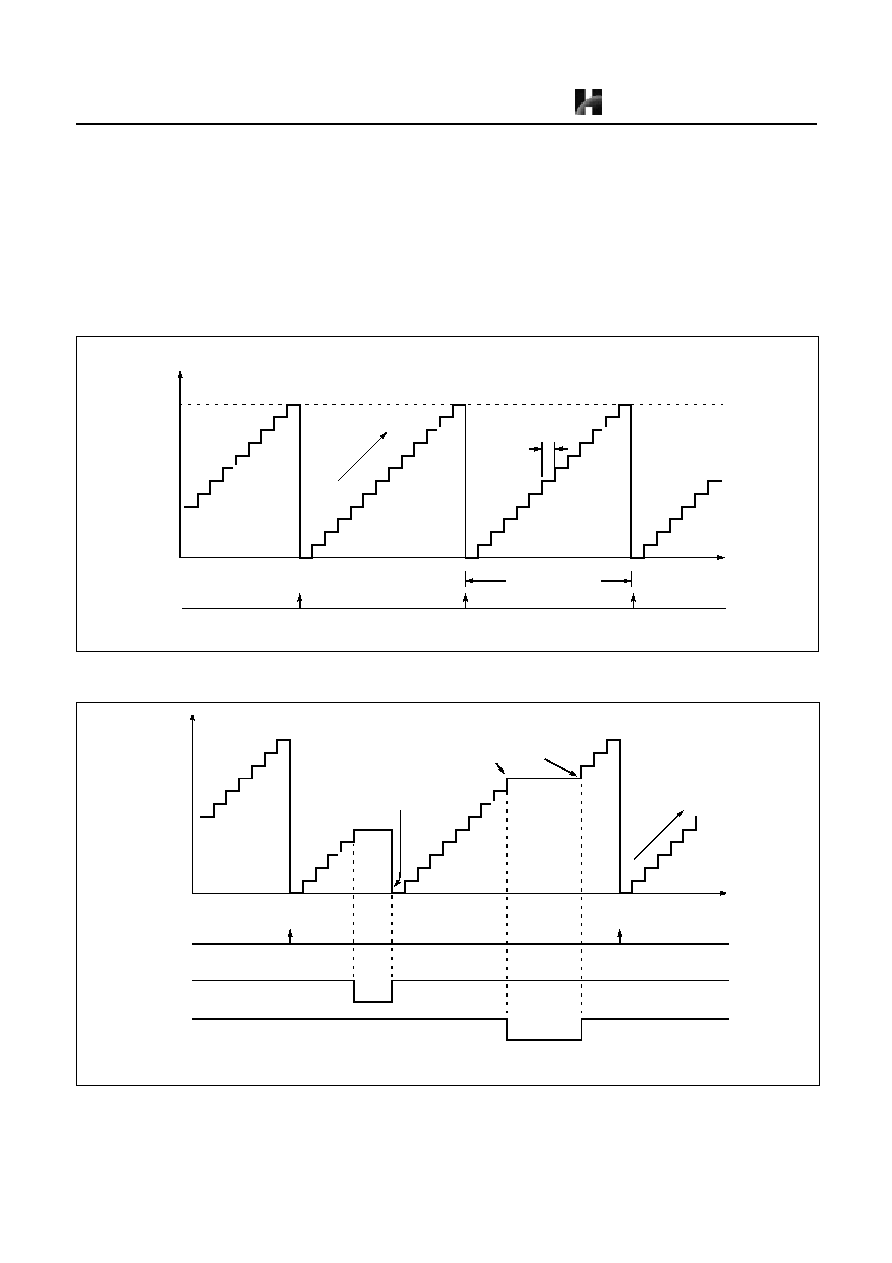
HMS87C1304A/HMS87C1302A
HYUNDAI MicroElectronics
38
Preliminary
Jan. 2001
These timers have each 8-bit count register and data regis-
ter. The count register is increased by every internal or ex-
ternal clock input. The internal clock has a prescaler divide
ratio option of 2, 4, 8, 32,128, 512, 2048 (selected by con-
trol bits T0CK2, T0CK1 and T0CK0 of register TM0) and
1, 2, 8 (selected by control bits T1CK1 and T1CK0 of reg-
ister TM1). In the Timer 0, timer register T0 increases
from 00
H
until it matches TDR0 and then reset to 00
H
. The
match output of Timer 0 generates Timer 0 interrupt
(latched in T0F bit). As TDRx and Tx register are in same
address, when reading it as a Tx, written to TDRx.
In counter function, the counter is increased every 0-to 1
(rising edge) transition of EC0 pin. In order to use counter
function, the bit RA0 of the RA Direction Register RAIO
is set to "0". The Timer 0 can be used as a counter by pin
EC0 input, but Timer 1 can not.
Figure 12-3 Counting Example of Timer Data Registers
Figure 12-4 Timer Count Operation
~~
Timer 1 (T1IF)
Interrupt
TDR1
TIME
Occur interrupt
Occur interrupt
Occur interrupt
Interrupt period
up
-c
ou
nt
~~
~~
0
1
2
3
4
5
6
7
8
9
n
n-1
P
CP
= P
CP
x (n+1)
Timer 1 (T1IF)
Interrupt
TDR1
TIME
Occur interrupt
Occur interrupt
stop
clear & start
disable
enable
Start & Stop
T1ST
T1CN
Control count
up
-c
ou
nt
~~
~~
T1ST = 0
T1ST = 1
T1CN = 0
T1CN = 1
Preliminary
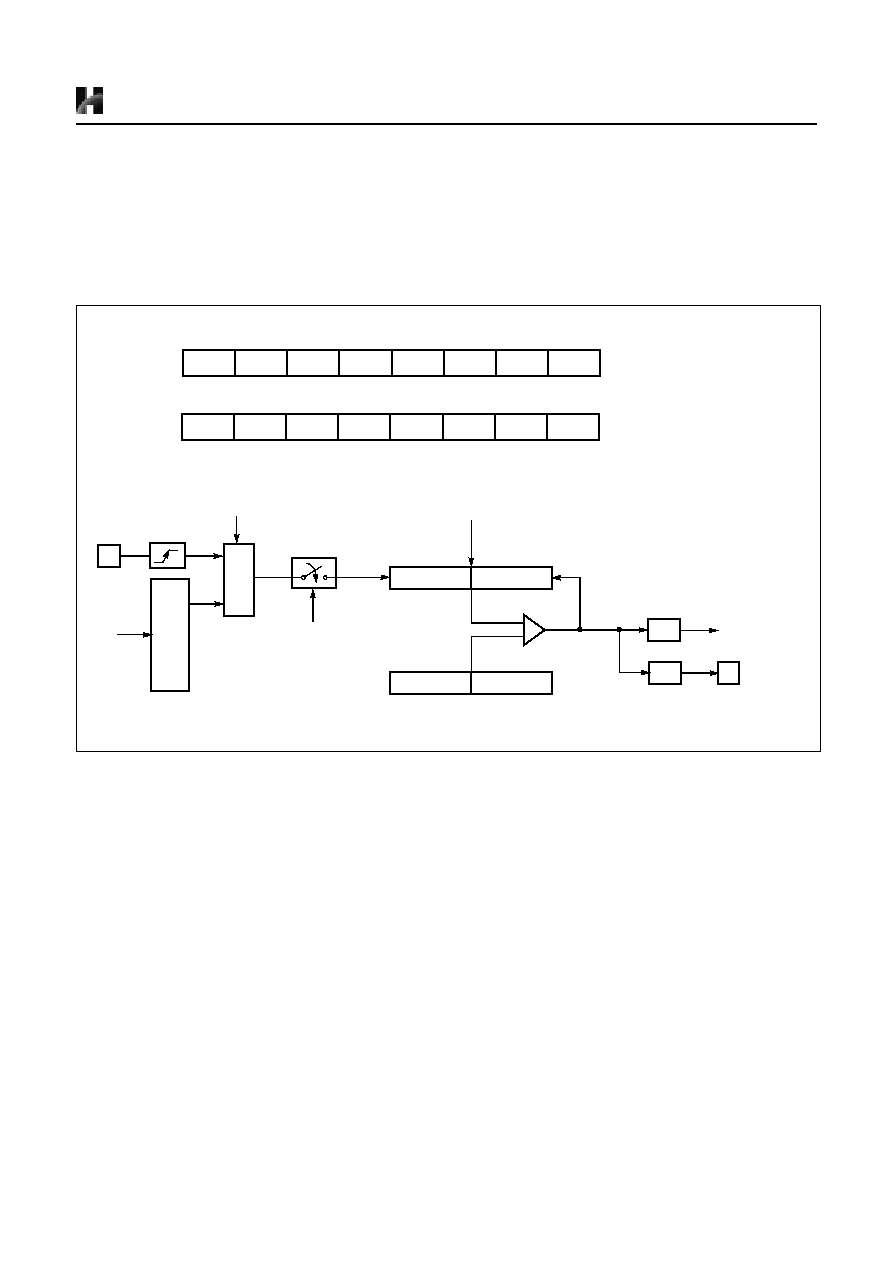
HYUNDAI MicroElectronics
HMS87C1304A/HMS87C1302A
Jan. 2001
Preliminary
39
12.2 16-bit Timer/Counter Mode
The Timer register is being run with 16 bits. A 16-bit timer/
counter register T0, T1 are increased from 0000
H
until it
matches TDR0, TDR1 and then resets to 0000
H
. The
match output generates Timer 0 interrupt not Timer 1 in-
terrupt.
The clock source of the Timer 0 is selected either internal
or external clock by bit T0CK2, T0CK1 and T0SL0.
In 16-bit mode, the bits T1CK1,T1CK0 and 16BIT of TM1
should be set to "1" respectively.
Figure 12-5 16-bit Timer / Counter Mode
12.3 8-bit Compare Output (16-bit)
The HMS87C1304A and HMS87C1302A has a function
of Timer Compare Output. To pulse out, the timer match
can goes to port pin(COMP0) as shown in Figure 12-2 and
Figure 12-5 . Thus, pulse out is generated by the timer
match. These operation is implemented to pin, RB4/
COMP0/PWM.
This pin output the signal having a 50: 50 duty square
wave, and output frequency is same as below equation.
In this mode, the bit PWMO of RB function register (RB-
FUNC) should be set to "1", and the bit PWME of timer1
mode register (TM1) should be set to "0".
In addition, 16-bit Compare output mode is available, also.
12.4 8-bit Capture Mode
The Timer 0 capture mode is set by bit CAP0 of timer
mode register TM0 (bit CAP1 of timer mode register TM1
for Timer 1) as shown in Figure 12-6 .
As mentioned above, not only Timer 0 but Timer 1 can also
be used as a capture mode.
The Timer/Counter register is increased in response inter-
nal or external input. This counting function is same with
normal timer mode, and Timer interrupt is generated when
TM0
ADDRESS : D0H
RESET VALUE : --000000
-
-
CAP0
T0CK2
T0CK1
T0CK0
T0CN
T0ST
TM1
ADDRESS : D2H
RESET VALUE : 00000000
POL
16BIT
PWME
CAP1
T1CK1
T1CK0
T1CN
T1ST
-
-
0
X
X
X
X
X
X
1
0
0
1
1
X
X
�
2
�
4
�
128
�
512
�
8
�
32
fxin
EC0
Edge Detector
MUX
1
T1 (8-bit)
TDR1 (8-bit)
T0IF
CLEAR
COMPARATOR
TIMER 0
INTERRUPT
T0 (8-bit)
TDR0 (8-bit)
T0ST
0 : Stop
1 : Start
T0CN
T0CK[2:0]
F/F
COMP0 PIN
�
2048
X: The value "0" or "1" corresponding your operation.
�
�
�
)
+
(
�
�
-------------------------------------------------------------------------------------------
=
Preliminary
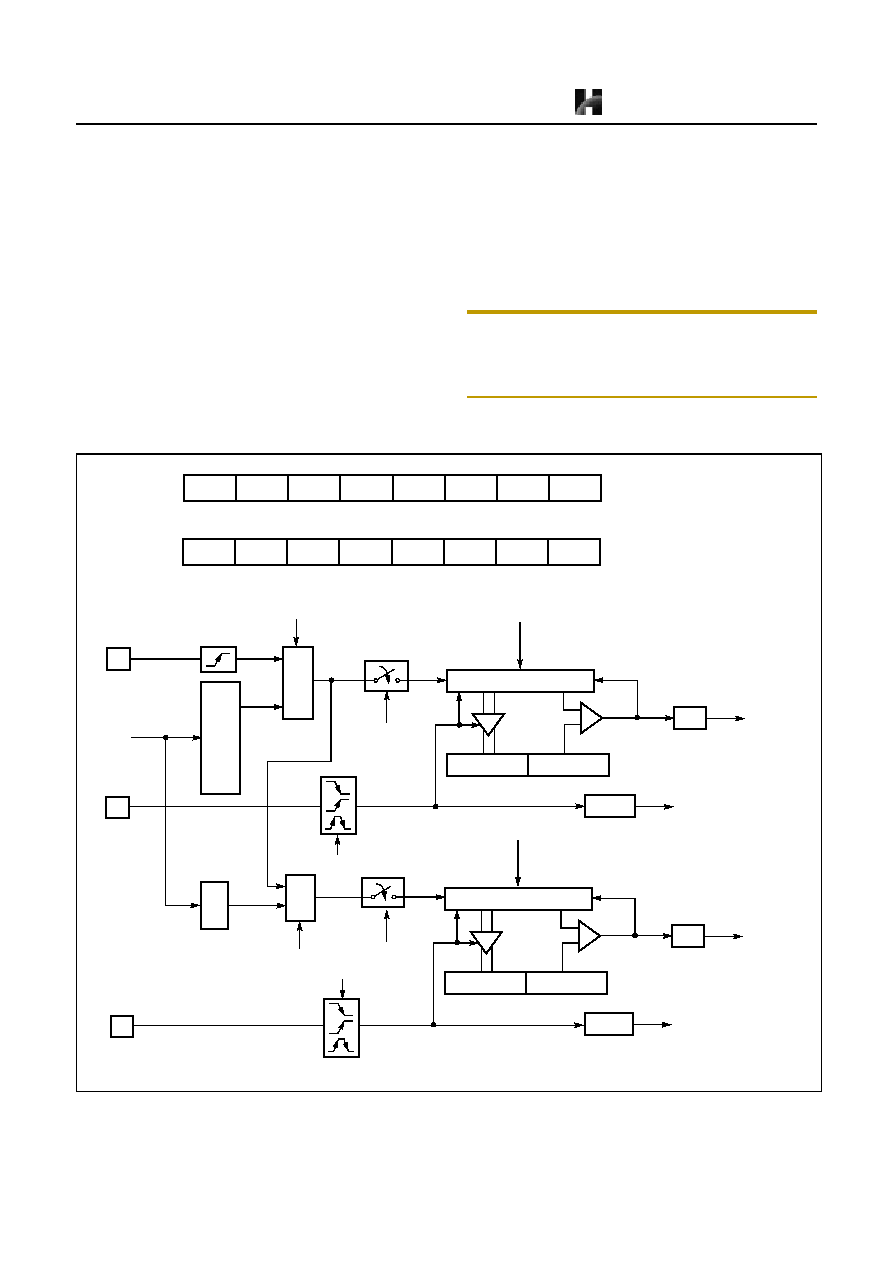
HMS87C1304A/HMS87C1302A
HYUNDAI MicroElectronics
40
Preliminary
Jan. 2001
timer register T0 (T1) increases and matches TDR0
(TDR1).
This timer interrupt in capture mode is very useful when
the pulse width of captured signal is more wider than the
maximum period of Timer.
For example, in Figure 12-8 , the pulse width of captured
signal is wider than the timer data value (FF
H
) over 2
times. When external interrupt is occurred, the captured
value (13
H
) is more little than wanted value. It can be ob-
tained correct value by counting the number of timer over-
flow occurrence.
Timer/Counter still does the above, but with the added fea-
ture that a edge transition at external input INTx pin causes
the current value in the Timer x register (T0,T1), to be cap-
tured into registers CDRx (CDR0, CDR1), respectively.
After captured, Timer x register is cleared and restarts by
hardware.
It has three transition modes: "falling edge", "rising edge",
"both edge" which are selected by interrupt edge selection
register IEDS (Refer to External interrupt section). In ad-
dition, the transition at INTx pin generate an interrupt.
Note: The CDRx, TDRx and Tx are in same address. In
the capture mode, reading operation is read the
CDRx, not Tx because path is opened to the CDRx,
and TDRx is only for writing operation.
Figure 12-6 8-bit Capture Mode
�
1
�
2
�
8
TM0
ADDRESS : D0H
RESET VALUE : --000000
-
-
CAP0
T0CK2
T0CK1
T0CK0
T0CN
T0ST
TM1
ADDRESS : D2H
RESET VALUE : 00000000
POL
16BIT
PWME
CAP1
T1CK1
T1CK0
T1CN
T1ST
-
-
1
X
X
X
X
X
X
0
0
1
X
X
X
X
�
2
�
4
�
128
�
512
�
8
�
32
fxin
EC0
Edge Detector
MUX
MUX
1
1
T0 (8-bit)
CDR0 (8-bit)
T0IF
CLEAR
COMPARATOR
TIMER 0
INTERRUPT
T0ST
0 : Stop
1 : Start
T0CN
T1CN
T0CK[2:0]
T1CK[1:0]
TDR0 (8-bit)
INT0IF
INT 0
INTERRUPT
INT0
T1 (8-bit)
CDR1 (8-bit)
T1IF
CLEAR
COMPARATOR
TIMER 1
INTERRUPT
TDR1 (8-bit)
INT1IF
INT 1
INTERRUPT
INT1
T0ST
0 : Stop
1 : Start
IEDS[1:0]
IEDS[3:2]
CAPTURE
CAPTURE
�
2048
Preliminary
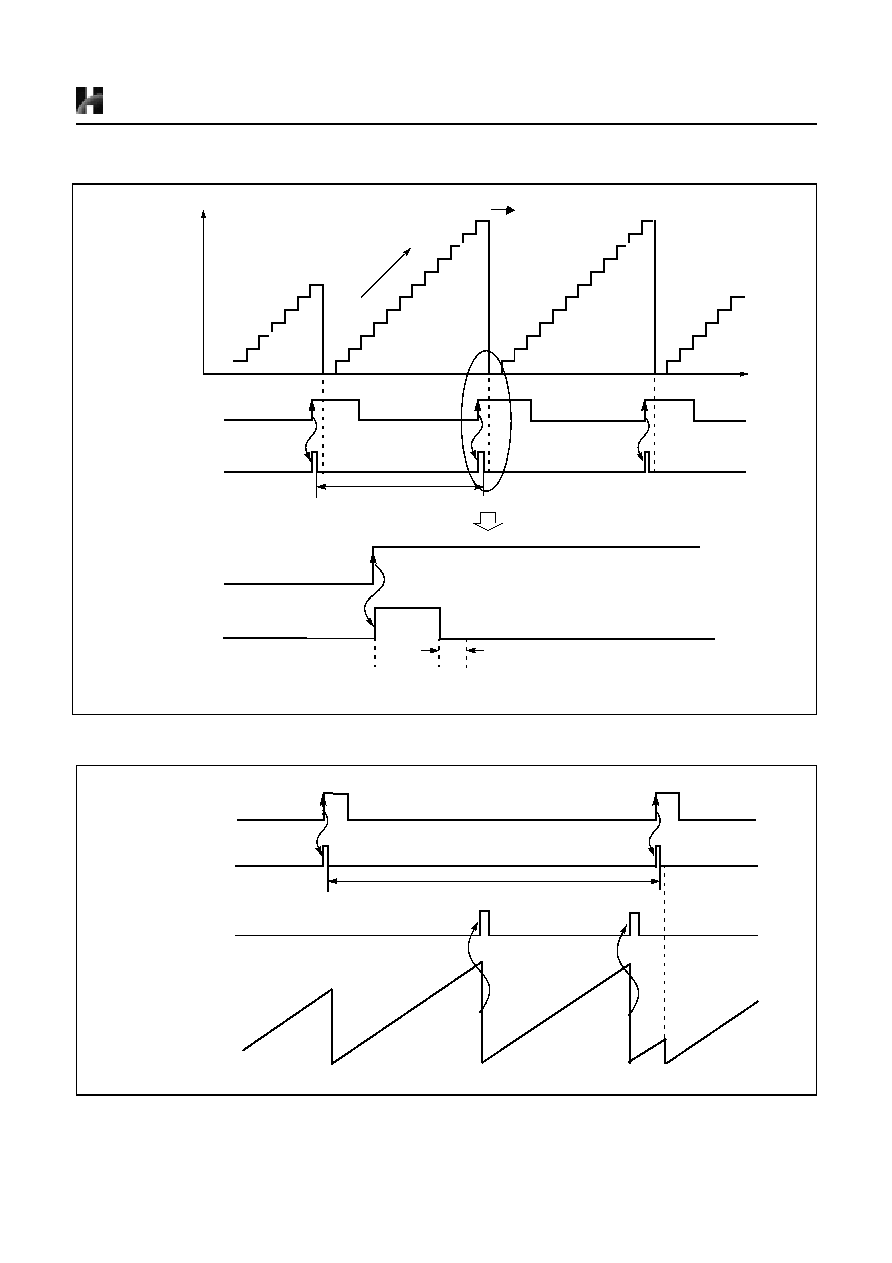
HYUNDAI MicroElectronics
HMS87C1304A/HMS87C1302A
Jan. 2001
Preliminary
41
Figure 12-7 Input Capture Operation
Figure 12-8 Excess Timer Overflow in Capture Mode
~~
Ext. INT0 Pin
Interrupt Request
T0
TIME
up
-c
ou
nt
~~
~~
0
1
2
3
4
5
6
7
8
9
n
n-1
Capture
(Timer Stop)
Clear & Start
Interrupt Interval Period
Delay
(INT0F)
Ext. INT0 Pin
Interrupt Request
(INT0F)
This value is loaded to CDR0
Interrupt Interval Period = FF
H
+ 01
H
+ FF
H
+01
H
+ 13
H
= 213
H
FF
H
FF
H
Ext. INT0 Pin
Interrupt Request
(INT0F)
00
H
00
H
Interrupt Request
(T0F)
T0
13
H
Preliminary
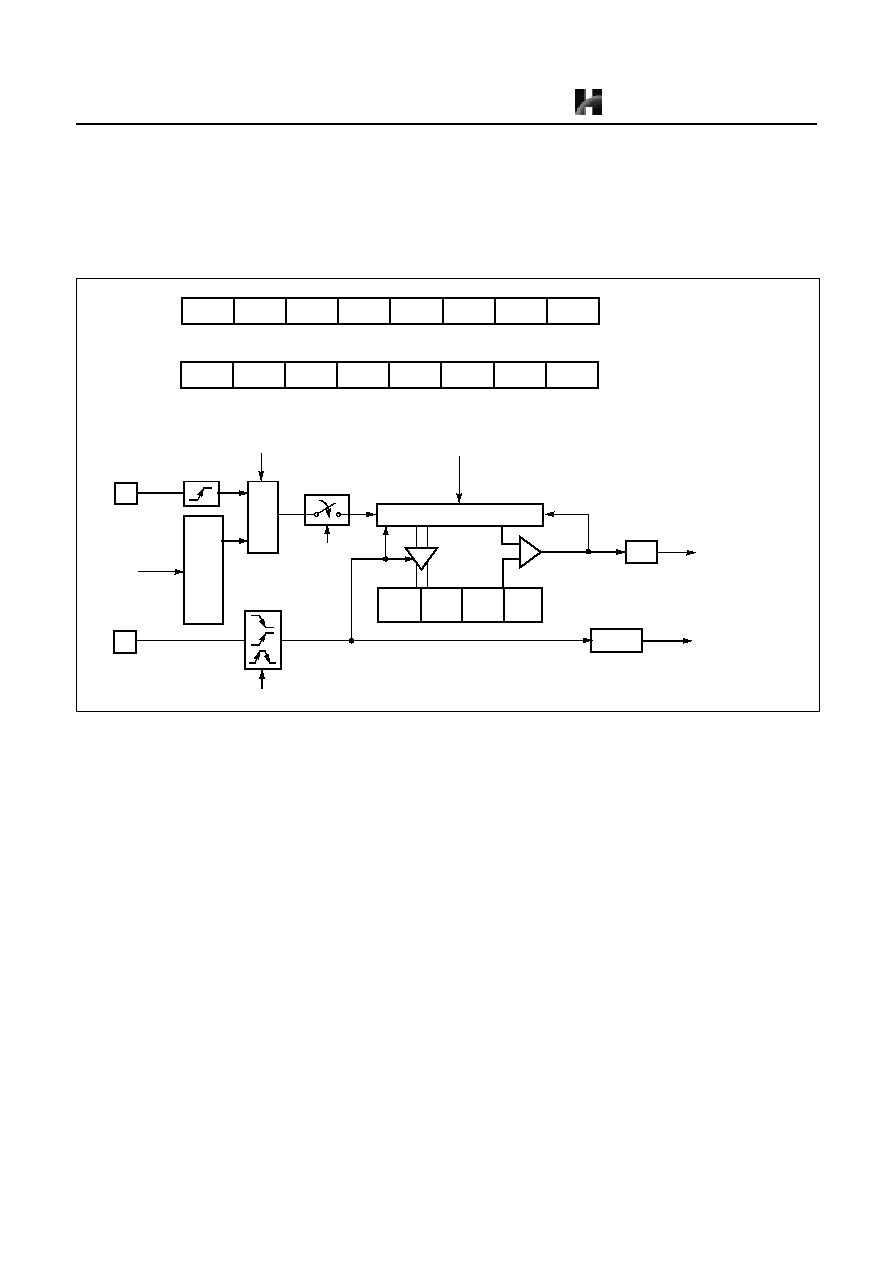
HMS87C1304A/HMS87C1302A
HYUNDAI MicroElectronics
42
Preliminary
Jan. 2001
12.5 16-bit Capture Mode
16-bit capture mode is the same as 8-bit capture, except
that the Timer register is being run will 16 bits.
The clock source of the Timer 0 is selected either internal
or external clock by bit T0CK2, T0CK1 and T0CK0.
In 16-bit mode, the bits T1CK1,T1CK0 and 16BIT of TM1
should be set to "1" respectively.
Figure 12-9 16-bit Capture Mode
12.6 PWM Mode
The HMS87C1304A and HMS87C1302A has a high speed
PWM (Pulse Width Modulation) functions which shared
with Timer1.
In PWM mode, pin RB4/COMP0/PWM0 outputs up to a
10-bit resolution PWM output. This pin should be config-
ure as a PWM output by setting "1" bit PWM0O in RB-
FUNC register.
The period of the PWM output is determined by the
T1PPR (PWM0 Period Register) and PWM0HR[3:2]
(bit3,2 of PWM0 High Register) and the duty of the PWM
output is determined by the T1PDR (PWM0 Duty Regis-
ter) and PWM0HR[1:0] (bit1,0 of PWM0 High Register).
The user writes the lower 8-bit period value to the T1PPR
and the higher 2-bit period value to the PWM0HR[3:2].
A n d w r i t e s d u t y v a l u e t o t h e T 1 P D R a n d t h e
PWM0HR[1:0] same way.
The T1PDR is configure as a double buffering for glitch-
less PWM output. In Figure 12-10 , the duty data is trans-
ferred from the master to the slave when the period data
matched to the counted value. (i.e. at the beginning of next
duty cycle)
PWM Period = [PWM0HR[3:2]T1PPR] X Source Clock
PWM Duty = [PWM0HR[1:0]T1PDR] X Source Clock
The relation of frequency and resolution is in inverse pro-
portion. Table 12-2 shows the relation of PWM frequency
vs. resolution.
TM0
ADDRESS : D0H
RESET VALUE : --000000
-
-
CAP0
T0CK2
T0CK1
T0CK0
T0CN
T0ST
TM1
ADDRESS : D2H
RESET VALUE : 00000000
POL
16BIT
PWME
CAP1
T1CK1
T1CK0
T1CN
T1ST
-
-
1
X
X
X
X
X
X
1
0
X
1
1
X
X
�
2
�
4
�
128
�
512
�
8
�
32
fxin
EC0
Edge Detector
MUX
1
T0 + T1 (16-bit)
TDR1
T0IF
CLEAR
COMPARATOR
TIMER 0
INTERRUPT
T0ST
0 : Stop
1 : Start
T0CN
T0CK[2:0]
TDR0
INT0IF
INT 0
INTERRUPT
INT0
IEDS[1:0]
CAPTURE
CDR1
CDR0
(8-bit)
(8-bit)
(8-bit)
(8-bit)
�
2048
X: The value "0" or "1" corresponding your operation.
Preliminary
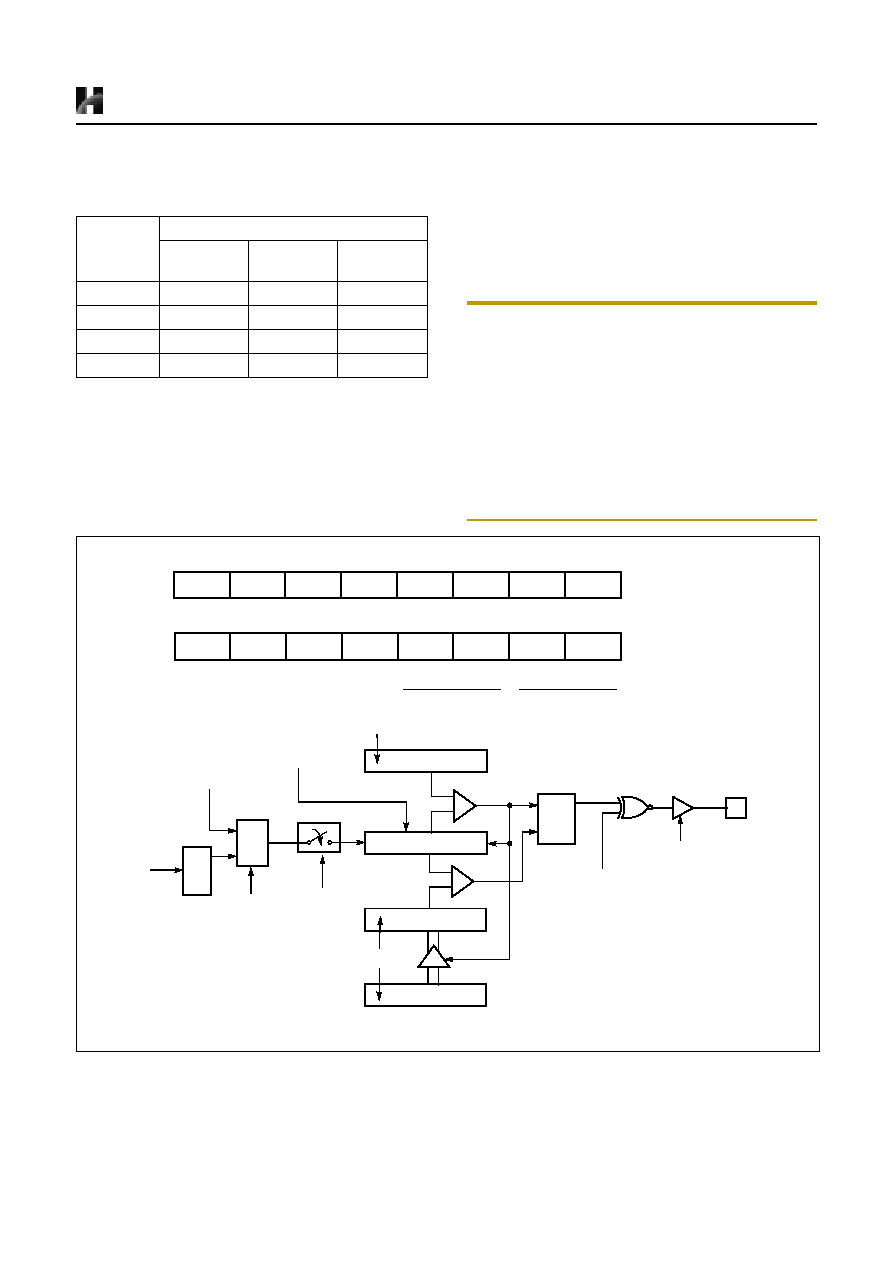
HYUNDAI MicroElectronics
HMS87C1304A/HMS87C1302A
Jan. 2001
Preliminary
43
If it needed more higher frequency of PWM, it should be
reduced resolution.
The bit POL of TM1 decides the polarity of duty cycle.
If the duty value is set same to the period value, the PWM
output is determined by the bit POL (1: High, 0: Low). And
if the duty value is set to "00
H
", the PWM output is deter-
mined by the bit POL (1: Low, 0: High).
It can be changed duty value when the PWM output. How-
ever the changed duty value is output after the current pe-
riod is over. And it can be maintained the duty value at
present output when changed only period value shown as
Figure 12-12 . As it were, the absolute duty time is not
changed in varying frequency. But the changed period val-
ue must greater than the duty value.
Note:
If changing the Timer1 to PWM function, it
should be stop the timer clock firstly, and then
set period and duty register value. If user
writes register values while timer is in opera-
tion, these register could be set with certain
values.
Ex)
LDM TM1,#00H
LDM T1PPR,#00H
LDM T1PDR,#00H
LDM PWM0HR,#00H
LDM RBFUNC,#0001_1100B
LDM TM1,#1010_1011B
Figure 12-10 PWM Mode
Resolution
Frequency
T1CK[1:0] =
00(125nS)
T1CK[1:0] =
01(250nS)
T1CK[1:0] =
10(1uS)
10-bit
7.8KHz
3.9KHz
0.98KHZ
9-bit
15.6KHz
7.8KHz
1.95KHz
8-bit
31.2KHz
15.6KHz
3.90KHz
7-bit
62.5KHz
31.2KHz
7.81KHz
Table 12-2 PWM Frequency vs. Resolution at 8MHz
�
1
�
2
�
8
PWM0HR
ADDRESS : D5H
RESET VALUE : ----0000
-
-
-
-
PW M 0HR3 PW M 0HR2 PW M 0HR1 PW M 0HR0
-
-
-
-
X
X
X
X
MUX
1
T1CN
T1CK[1:0]
T1 (8-bit)
T1ST
0 : Stop
1 : Start
CLEAR
COMPARATOR
COMPARATOR
T1PDR(8-bit)
PWM0HR[1:0]
T1PPR(8-bit)
PWM0HR[3:2]
T1PDR(8-bit)
S
Q
R
POL
PWM0O
RB4/
PWM0
T0 clock source
fxin
TM1
ADDRESS : D2H
RESET VALUE : 00000000
P O L
16B IT
PW M E
CA P1
T 1C K 1
T 1C K 0
T 1 C N
T 1 S T
X
0
1
0
X
X
X
X
[RBFUNC.4]
Period High
Duty High
Slave
Master
Bit Manipulation Not Available
X: The value "0" or "1" corresponding your operation.
Preliminary

HMS87C1304A/HMS87C1302A
HYUNDAI MicroElectronics
44
Preliminary
Jan. 2001
Figure 12-11 Example of PWM at 8MHz
Figure 12-12 Example of Changing the Period in Absolute Duty Cycle (@8MHz)
fxin
T1
PWM
~~
~~
~~
01
02
03
04
05
7F
80
81
3FF
02
03
~~
~~
~~
~~
~~
~~
~~
POL=1
PWM
POL=0
Duty Cycle [80H x 125nS = 16uS]
Period Cycle [3FFH x 125nS = 127.875uS, 7.8KHz]
PWM0HR = 0CH
T1PPR = FFH
T1PDR = 80H
T1CK[1:0] = 00 (fxin)
PWM0HR3 PWM0HR2
PWM0HR1 PWM0HR0
T1PPR (8-bit)
T1PDR (8-bit)
Period
Duty
1
1
FFH
0
0
80H
00
01
00
Source
T1
PWM
POL=1
Duty Cycle
Period Cycle [0EH x 1uS = 14uS, 71KHz]
P W M 0 H R = 0 0H
T 1P P R = 0 E H
T 1P D R = 0 5 H
T 1C K [1 :0 ] = 1 0 (1 uS )
01 02
03
04
05
06
08
09
0B 0C 0D 0E
01 02 03
04
05
06 07
08
09
0A
01 02
03 04
07
0A
05
[05H x 1uS = 5uS]
Duty Cycle
[05H x 1uS = 5uS]
Period Cycle [0AH x 1uS = 10uS, 100KHz]
Duty Cycle
[05H x 1uS = 5uS]
Write T1PPR to 0AH
Period changed
clock
Preliminary
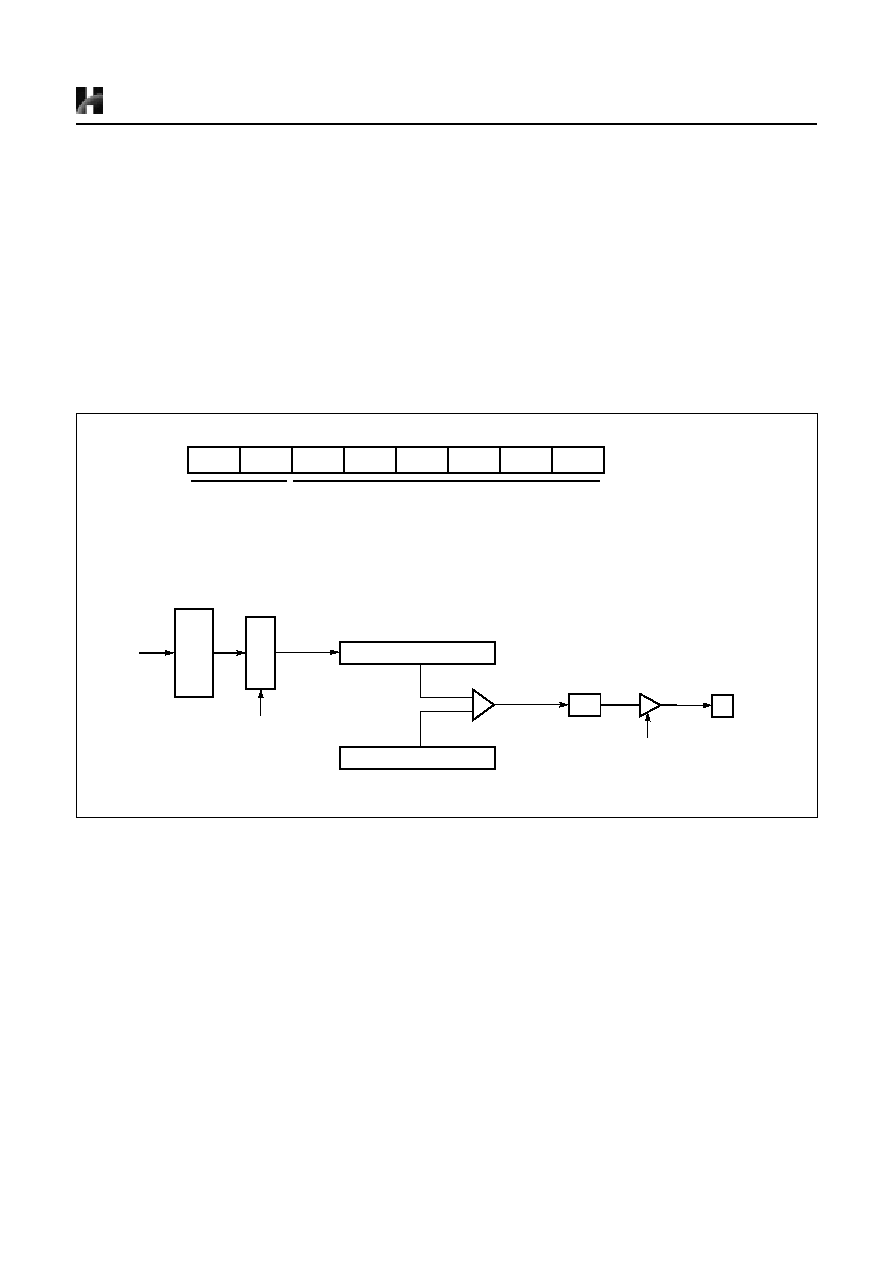
HYUNDAI MicroElectronics
HMS87C1304A/HMS87C1302A
Jan. 2001
Preliminary
45
13. Buzzer Output function
The buzzer driver consists of 6-bit binary counter, the
buzzer register BUR and the clock selector. It generates
square-wave which is very wide range frequency (480
Hz~250 KHz at fxin = 4 MHz) by user programmable
counter.
Pin RB1 is assigned for output port of Buzzer driver by set-
ting the bit BUZO of RBFUNC to "1".
The 6-bit buzzer counter is cleared and start the counting
by writing signal to the register BUR. It is increased from
00H until it matches 6-bit register BUR.
Also, it is cleared by counter overflow and count up to out-
put the square wave pulse of duty 50%.
The bit 0 to 5 of BUR determines output frequency for
buzzer driving. Frequency calculation is following as
shown below.
The bits BUCK1, BUCK0 of BUR selects the source clock
from prescaler output.
Figure 13-1 Buzzer Driver
(
)
Oscillator Frequency
Prescaler Ratio
+
(
)
�
�
-------------------------------------------------------------------------------------
=
BUR
ADDRESS : DEH
RESET VALUE : 11111111
BUCK1
BUCK0
BUR5
BUR4
BUR3
BUR2
BUR1
BUR0
�
64
�
16
�
32
fxin
MUX
COUNTER (6-bit)
BUR (6-bit)
F/F
COMPARATOR
BUCK[1:0]
RB1/BUZ PIN
�
8
Input clock selection
00 : fxin
�
8
01 : fxin
�
16
10 : fxin
�
32
11 : fxin
�
64
Buzzer Period Data
BUZO
[RBFUNC.1]
Bit Manipulation Not Available
Preliminary
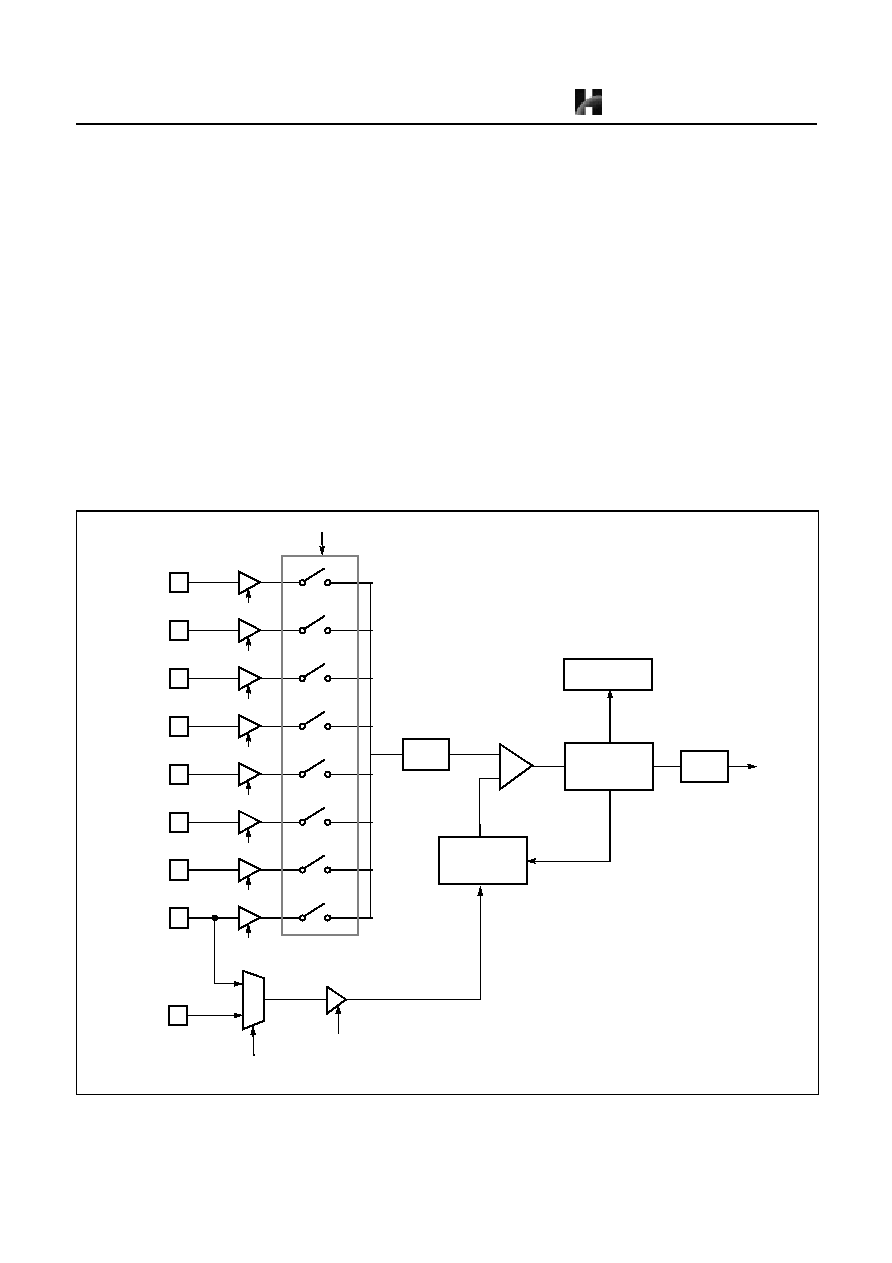
HMS87C1304A/HMS87C1302A
HYUNDAI MicroElectronics
46
Preliminary
Jan. 2001
14. ANALOG TO DIGITAL CONVERTER
The analog-to-digital converter (A/D) allows conversion
of an analog input signal to a corresponding 8-bit digital
value. The A/D module has eight analog inputs, which are
multiplexed into one sample and hold. The output of the
sample and hold is the input into the converter, which gen-
erates the result via successive approximation.
The analog reference voltage is selected to V
DD
or AVref
by setting of the bit AVREFS in RBFUNC register. If ex-
ternal analog reference AVref is selected, the bit ANSEL0
should not be set to "1", because this pin is used to an an-
alog reference of A/D converter.
The A/D module has two registers which are the control
register ADCM and A/D result register ADCR. The
ADCM register, shown in Figure 14-2 , controls the oper-
ation of the A/D converter module. The port pins can be
configure as analog inputs or digital I/O.
To use analog inputs, each port is assigned analog input
port by setting the bit ANSEL[7:0] in RAFUNC register.
And selected the corresponding channel to be converted by
setting ADS[2:0].
The processing of conversion is start when the start bit
ADST is set to "1". After one cycle, it is cleared by hard-
ware. The register ADCR contains the results of the A/D
conversion. When the conversion is completed, the result
is loaded into the ADCR, the A/D conversion status bit
ADSF is set to "1", and the A/D interrupt flag ADIF is set.
The block diagram of the A/D module is shown in Figure
14-1 . The A/D status bit ADSF is set automatically when
A/D conversion is completed, cleared when A/D conver-
sion is in process. The conversion time takes maximum 10
uS (at fxin=8 MHz).
Figure 14-1 A/D Converter Block Diagram
RB0/AN0/AVref
ANSEL0 (RAFUNC.0)
RA1/AN1
ANSEL1
RA2/AN2
ANSEL2
RA3/AN3
ANSEL3
RA4/AN4
ANSEL4
RA5/AN5
ANSEL5
RA6/AN6
ANSEL6
RA7/AN7
ANSEL7
000
001
010
011
100
101
110
111
V
DD
Pin
1
0
AVREFS (RBFUNC.0)
ADEN
S/H
Successive
Approximation
Circuit
A D IF
Resistor
Ladder
Circuit
ADS[2:0]
ADCR(8-bit)
Sample & Hold
A/D Interrupt
ADDRESS : EBH
RESET VALUE : Undefined
A/D Result Register
Preliminary
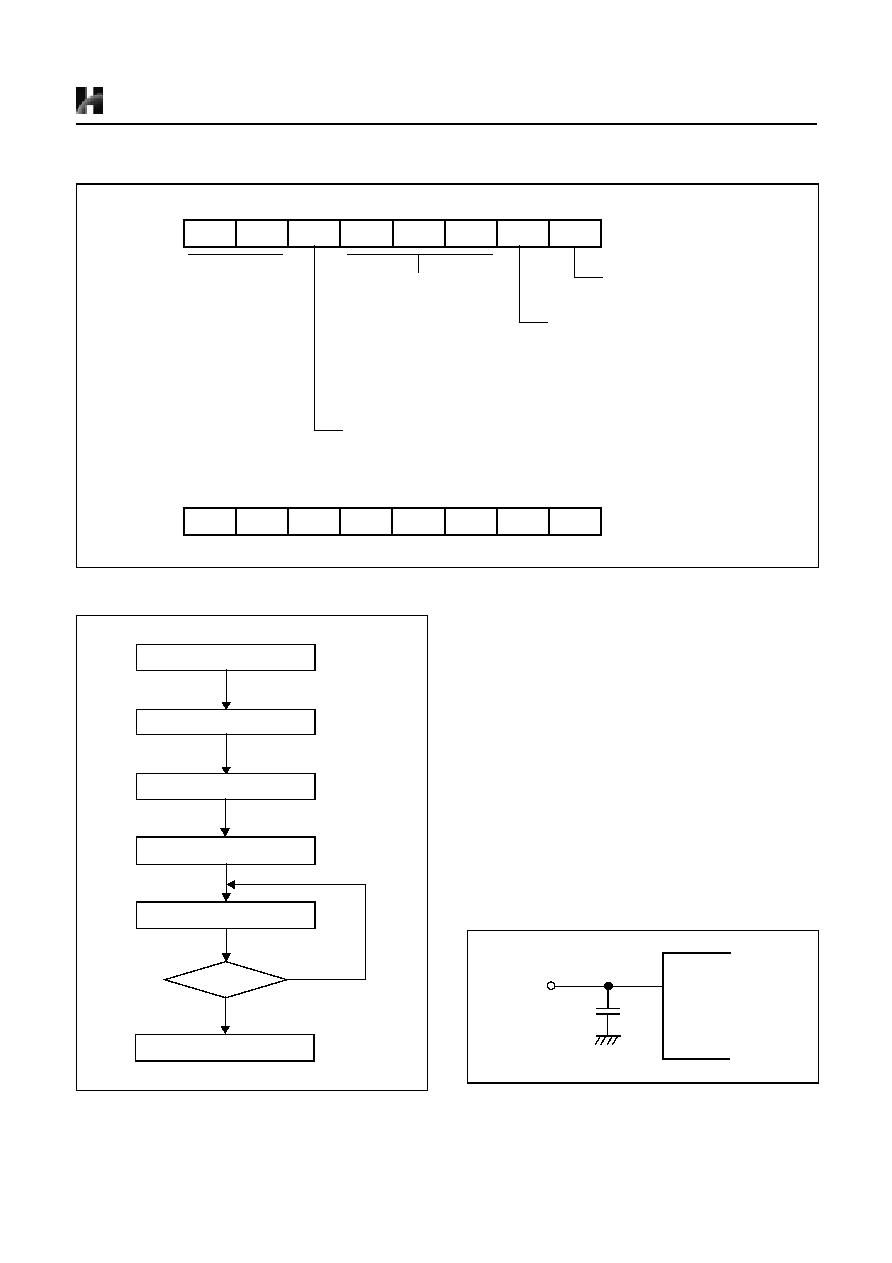
HYUNDAI MicroElectronics
HMS87C1304A/HMS87C1302A
Jan. 2001
Preliminary
47
Figure 14-2 A/D Converter Registers
Figure 14-3 A/D Converter Operation Flow
A/D Converter Cautions
(1) Input range of AN0 to AN7
The input voltage of AN0 to AN7 should be within the
specification range. In particular, if a voltage above
VDD
(or AVref)
or below V
SS
is input (even if within the absolute max-
imum rating range), the conversion value for that channel can not
be indeterminate. The conversion values of the other channels
may also be affected.
(2) Noise countermeasures
In order to maintain 8-bit resolution, attention must be paid to
noise on pins AVref(or VDD)and AN0 to AN7. Since
the effect
increases in proportion to the output impedance of the an-
alog input source, it is recommended that
a capacitor be con-
nected externally as shown in Figure 14-4 in order to reduce
noise.
Figure 14-4 Analog Input Pin Connecting Capacitor
ADCM
ADDRESS : EAH
RESET VALUE : --000001
-
-
ADEN
ADS2
ADS1
ADS0
ADST
ADSF
Reserved
Analog Channel Select
A/D Status bit
0 : A/D Conversion is in process
1 : A/D Conversion is completed
A/D Start bit
1 : A/D Conversion is started
After 1 cycle, cleared to "0"
0 : Bit force to zero
000 : Channel 0 (RB0/AN0)
001 : Channel 1 (RA1/AN1)
010 : Channel 2 (RA2/AN2)
011 : Channel 3 (RA3/AN3)
100 : Channel 4 (RA4/AN4)
101 : Channel 5 (RA5/AN5)
110 : Channel 6 (RA6/AN6)
111 : Channel 7 (RA7/AN7)
A/D Enable bit
1 : A/D Conversion is enable
0 : A/D Converter module shut off
and consumes no operation current
A/D Control Register
ADCR
ADDRESS : EBH
RESET VALUE : Undefined
ADCR7
ADCR6
ADCR5
ADCR4
ADCR3
ADCR2
ADCR1
ADCR0
A/D Result Data Register
ENABLE A/D CONVERTER
A/D START (ADST = 1)
NOP
ADSF = 1
A/D INPUT CHANNEL SELECT
ANALOG REFERENCE SELECT
READ ADCR
YES
NO
AN0~AN7
100~1000pF
Analog
Input
Preliminary

HMS87C1304A/HMS87C1302A
HYUNDAI MicroElectronics
48
Preliminary
Jan. 2001
(3) Pins AN0/RB0 and AN1/RA1 to AN7/RA7
The analog input pins AN0 to AN7 also function as input/
output port (PORT RA and RB0) pins. When A/D conver-
sion is performed with any of pins AN0 to AN7 selected,
be sure not to execute a PORT input instruction while con-
version is in progress, as this may reduce the conversion
resolution.
Also, if digital pulses are applied to a pin adjacent to the
pin in the process of A/D conversion, the expected A/D
conversion value may not be obtainable due to coupling
noise. Therefore, avoid applying pulses to pins adjacent to
the pin undergoing A/D conversion.
(4) AVref
pin input impedance
A series resistor string of approximately 10K
is connected be-
tween the AVref
pin and the V
SS
pin.
Therefore, if the output impedance of the reference voltage
source is high, this will result in parallel connection
to the
series resistor string between the AVref
pin and the V
SS
pin, and
there will be a large reference voltage error.
Preliminary
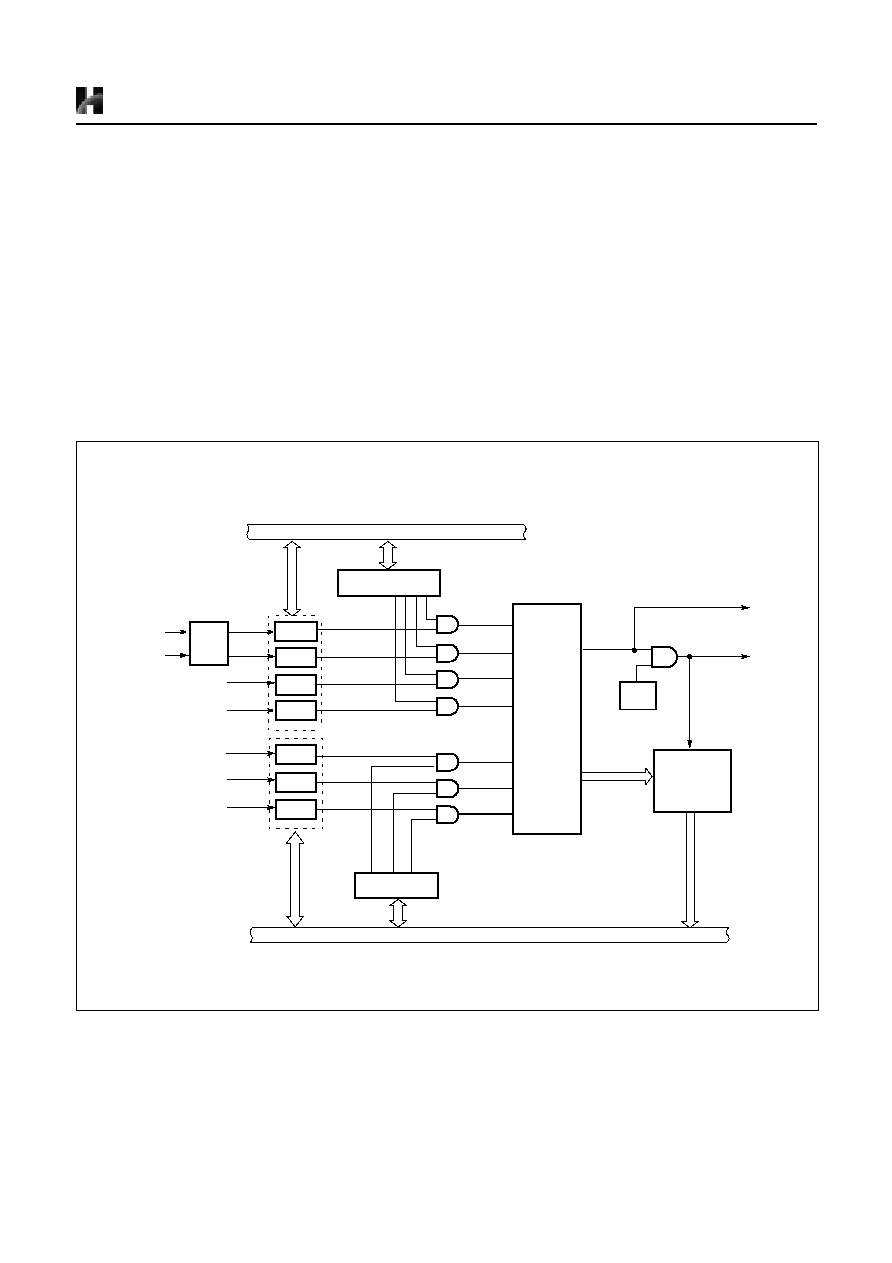
HYUNDAI MicroElectronics
HMS87C1304A/HMS87C1302A
Jan. 2001
Preliminary
49
15. INTERRUPTS
The HMS87C1304A and HMS87C1302A interrupt cir-
cuits consist of Interrupt enable register (IENH, IENL), In-
terrupt request flags of IRQH, IRQL, Interrupt Edge
Selection Register (IEDS), priority circuit and Master en-
able flag("I" flag of PSW). The configuration of interrupt
circuit is shown in Figure 15-1 and Interrupt priority is
shown in Table 15-1 .
The External Interrupts INT0 and INT1 can each be transi-
tion-activated (1-to-0, 0-to-1 and both transition).
The flags that actually generate these interrupts are bit
INT0IF and INT1IF in Register IRQH. When an external
interrupt is generated, the flag that generated it is cleared
by the hardware when the service routine is vectored to
only if the interrupt was transition-activated.
The Timer 0 and Timer 1 Interrupts are generated by T0IF
and T1IF, which are set by a match in their respective tim-
er/counter register. The AD converter Interrupt is generat-
ed by ADIF which is set by finishing the analog to digital
conversion. The Watch dog timer Interrupt is generated by
WDTIF which set by a match in Watch dog timer register
(when the bit WDTON is set to "0"). The Basic Interval
Timer Interrupt is generated by BITIF which is set by a
overflowing of the Basic Interval Timer Register(BITR).
Figure 15-1 Block Diagram of Interrupt Function
The interrupts are controlled by the interrupt master enable
flag I-flag (bit 2 of PSW), the interrupt enable register
(IENH, IENL) and the interrupt request flags (in IRQH,
IRQL) except Power-on reset and software BRK interrupt.
Interrupt enable registers are shown in Figure 15-2 . These
registers are composed of interrupt enable flags of each in-
terrupt source, these flags determines whether an interrupt
will be accepted or not. When enable flag is "0", a corre-
BIT
BITIF
WDTIF
WDT
A/D Converter
Timer 1
Timer 0
External Int. 1
External Int. 0
IENH
Interrupt Enable
Interrupt Enable
IRQH
IRQL
Interrupt
Vector
Address
Generator
Internal bus line
Register (Lower byte)
Internal bus line
Register (Higher byte)
Release STOP
To CPU
Interrupt Master
Enable Flag
I Flag
IENL
Pri
o
r
i
ty
Con
t
rol
I-flag is in PSW, it is cleared by "DI", set by
"EI" instruction.When it goes interrupt service,
I-flag is cleared by hardware, thus any other
interrupt are inhibited. When interrupt service is
completed by "RETI" instruction, I-flag is set to
"1" by hardware.
INT0IF
INT1IF
T0IF
T1IF
ADIF
7
6
5
4
7
6
5
IEDS
Preliminary
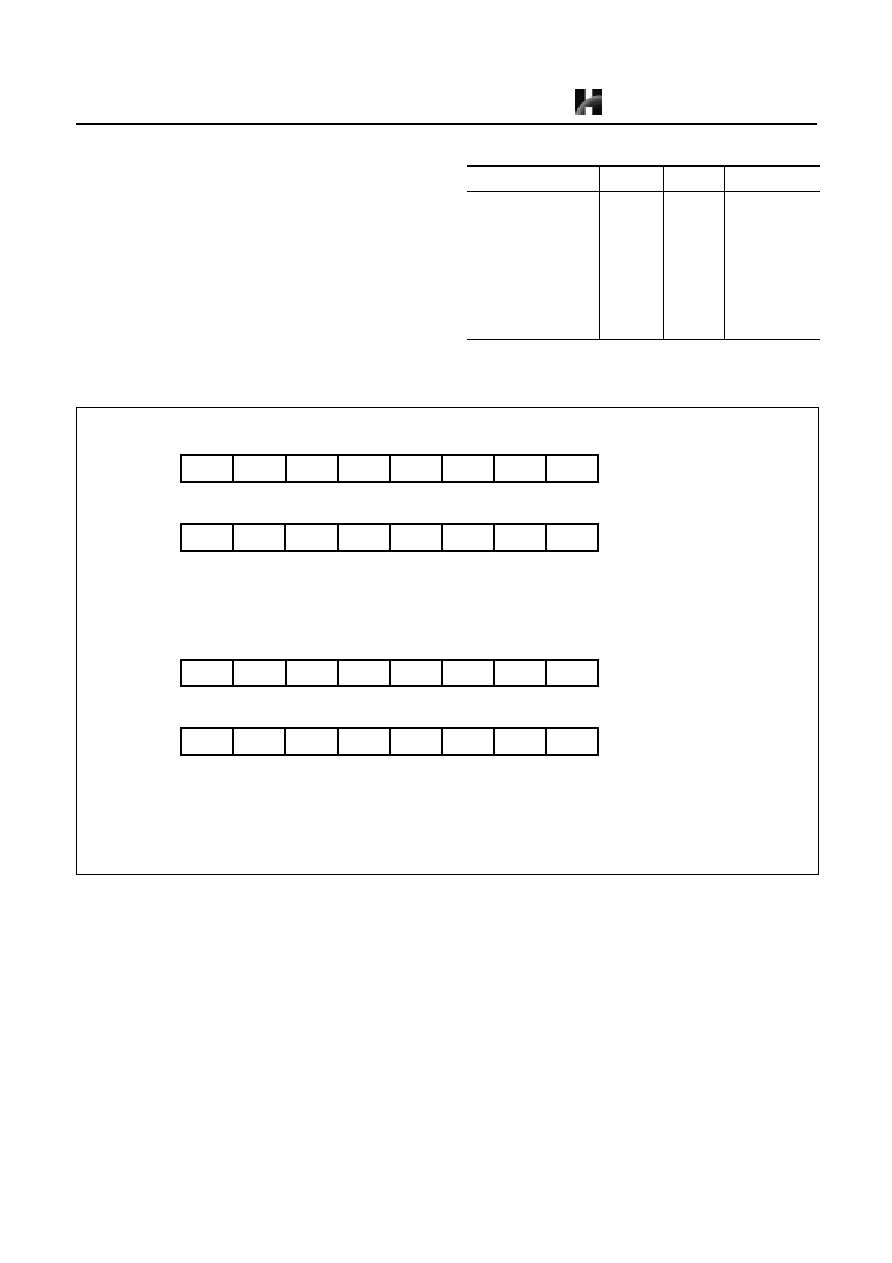
HMS87C1304A/HMS87C1302A
HYUNDAI MicroElectronics
50
Preliminary
Jan. 2001
sponding interrupt source is prohibited. Note that PSW
contains also a master enable bit, I-flag, which disables all
interrupts at once.
Figure 15-2 Interrupt Enable Registers and Interrupt Request Registers
When an interrupt is occurred, the I-flag is cleared and dis-
able any further interrupt, the return address and PSW are
pushed into the stack and the PC is vectored to. Once in the
interrupt service routine the source(s) of the interrupt can
be determined by polling the interrupt request flag bits.
The interrupt request flag bit(s) must be cleared by soft-
ware before re-enabling interrupts to avoid recursive inter-
rupts. The Interrupt Request flags are able to be read and
written.
15.1 Interrupt Sequence
An interrupt request is held until the interrupt is accepted
or the interrupt latch is cleared to "0" by a reset or an in-
struction. Interrupt acceptance sequence requires 8 f
OSC
(2
�
s at f
XIN
=4MHz) after the completion of the current in-
struction execution. The interrupt service task is terminat-
ed upon execution of an interrupt return instruction
Reset/Interrupt
Symbol
Priority
Vector Addr.
Hardware Reset
External Interrupt 0
External Interrupt 1
Timer 0
Timer 1
A/D Converter
Watch Dog Timer
Basic Interval Timer
RESET
INT0
INT1
Timer 0
Timer 1
A/D C
WDT
BIT
-
1
2
3
4
5
6
7
FFFE
H
FFFA
H
FFF8
H
FFF6
H
FFF4
H
FFEA
H
FFE8
H
FFE6
H
Table 15-1 Interrupt Priority
IENH
ADDRESS : E2H
RESET VALUE : 0000----
INT0E
INT1E
T0E
T1E
-
-
-
-
Interrupt Enable Register High
IENL
ADDRESS : E3H
RESET VALUE : 000-----
ADE
WDTE
BITE
-
-
-
-
-
Interrupt Enable Register Low
IRQH
ADDRESS : E4H
RESET VALUE : 0000----
INT0IF
INT1IF
T0IF
T1IF
-
-
-
-
Interrupt Request Register High
IRQL
ADDRESS : E5H
RESET VALUE : 000-----
ADIF
WDTIF
BITIF
-
-
-
-
-
Interrupt Request Register Low
0 : Disable
1 : Enable
Enables or disables the interrupt individually
If flag is cleared, the interrupt is disabled.
0 : Not occurred
1 : Interrupt request is occurred
Shows the interrupt occurrence
Preliminary

HYUNDAI MicroElectronics
HMS87C1304A/HMS87C1302A
Jan. 2001
Preliminary
51
[RETI].
Interrupt acceptance
1. The interrupt master enable flag (I-flag) is cleared to
"0" to temporarily disable the acceptance of any follow-
ing maskable interrupts. When a non-maskable inter-
rupt is accepted, the acceptance of any following
interrupts is temporarily disabled.
2. Interrupt request flag for the interrupt source accepted is
cleared to "0".
3. The contents of the program counter (return address)
and the program status word are saved (pushed) onto the
stack area. The stack pointer decreases 3 times.
4. The entry address of the interrupt service program is
read from the vector table address and the entry address
is loaded to the program counter.
5. The instruction stored at the entry address of the inter-
rupt service program is executed.
Figure 15-3 Timing chart of Interrupt Acceptance and Interrupt Return Instruction
A interrupt request is not accepted until the I-flag is set to
"1" even if a requested interrupt has higher priority than
that of the current interrupt being serviced.
When nested interrupt service is required, the I-flag should
be set to "1" by "EI" instruction in the interrupt service
program. In this case, acceptable interrupt sources are se-
lectively enabled by the individual interrupt enable flags.
Saving/Restoring General-purpose Register
During interrupt acceptance processing, the program
counter and the program status word are automatically
saved on the stack, but accumulator and other registers are
not saved itself. These registers are saved by the software
if necessary. Also, when multiple interrupt services are
nested, it is necessary to avoid using the same data memory
area for saving registers.
The following method is used to save/restore the general-
purpose registers.
V.L.
System clock
Address Bus
PC
SP
SP-1
SP-2
V.H.
New PC
V.L.
Data Bus
Not used
PCH
PCL
PSW
ADL
OP code
ADH
Instruction Fetch
Internal Read
Internal Write
Interrupt Processing Step
Interrupt Service Task
V.L. and V.H. are vector addresses.
ADL and ADH are start addresses of interrupt service routine as vector contents.
Basic Interval Timer
012
H
0E3
H
0FFE6
H
0FFE7
H
0E
H
2E
H
0E312
H
0E313
H
Entry Address
Correspondence between vector table address for BIT interrupt
and the entry address of the interrupt service program.
Vector Table Address
Preliminary
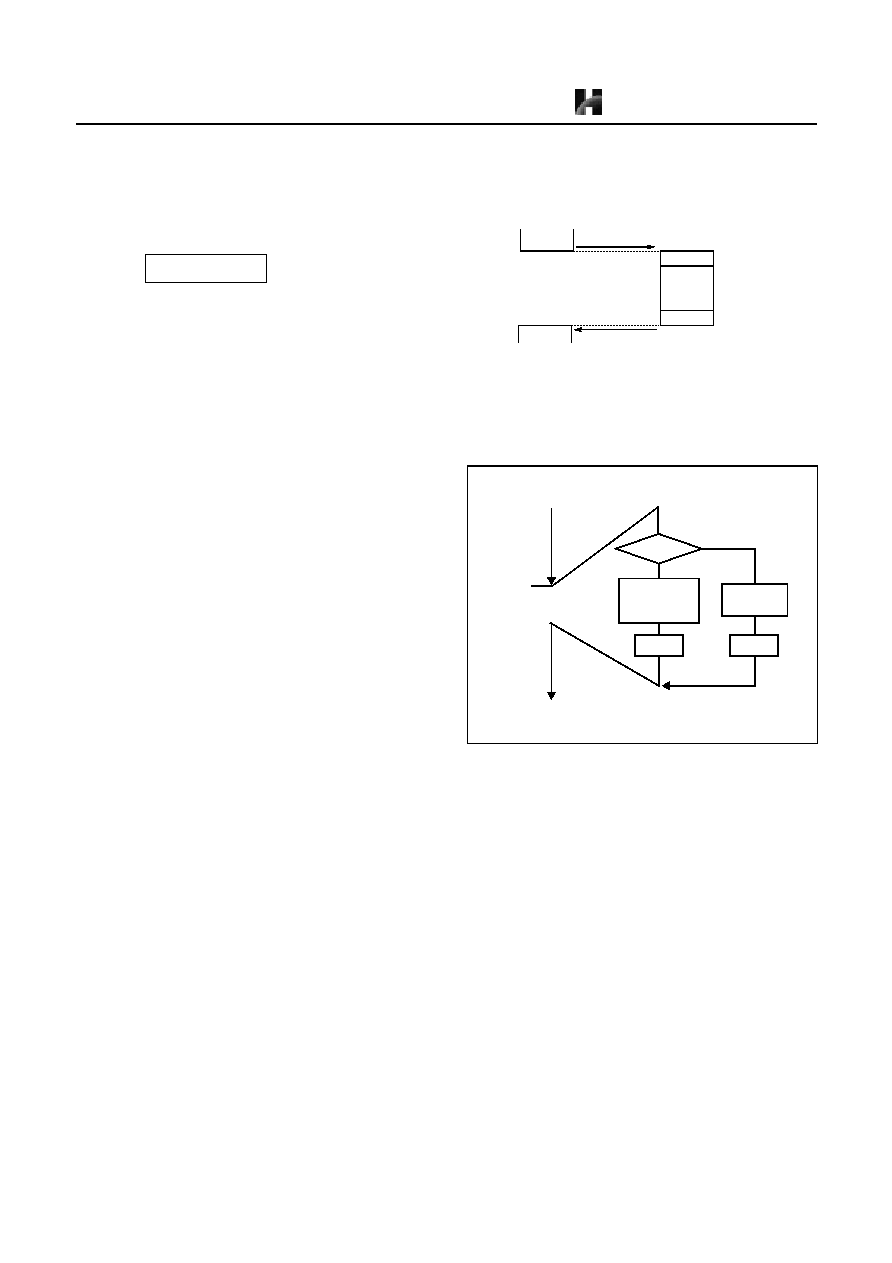
HMS87C1304A/HMS87C1302A
HYUNDAI MicroElectronics
52
Preliminary
Jan. 2001
Example: Register save using push and pop instructions
General-purpose register save/restore using push and pop
instructions;
15.2 BRK Interrupt
Software interrupt can be invoked by BRK instruction,
which has the lowest priority order.
Interrupt vector address of BRK is shared with the vector
of TCALL 0 (Refer to Program Memory Section). When
BRK interrupt is generated, B-flag of PSW is set to distin-
guish BRK from TCALL 0.
Each processing step is determined by B-flag as shown in
Figure 15-4 .
Figure 15-4 Execution of BRK/TCALL0
15.3 Multi Interrupt
If two requests of different priority levels are received si-
multaneously, the request of higher priority level is ser-
viced. If requests of the interrupt are received at the same
time simultaneously, an internal polling sequence deter-
mines by hardware which request is serviced.
However, multiple processing through software for special
features is possible. Generally when an interrupt is accept-
ed, the I-flag is cleared to disable any further interrupt. But
as user sets I-flag in interrupt routine, some further inter-
rupt can be serviced even if certain interrupt is in progress.
INTxx:
PUSH
A
PUSH
X
PUSH
Y
;SAVE ACC.
;SAVE X REG.
;SAVE Y REG.
interrupt processing
POP
Y
POP
X
POP
A
RETI
;RESTORE Y REG.
;RESTORE X REG.
;RESTORE ACC.
;RETURN
main task
interrupt
service task
saving
registers
restoring
registers
acceptance of
interrupt
interrupt return
B-FLAG
BRK
INTERRUPT
ROUTINE
RETI
TCALL0
ROUTINE
RET
BRK or
TCALL0
=0
=1
Preliminary
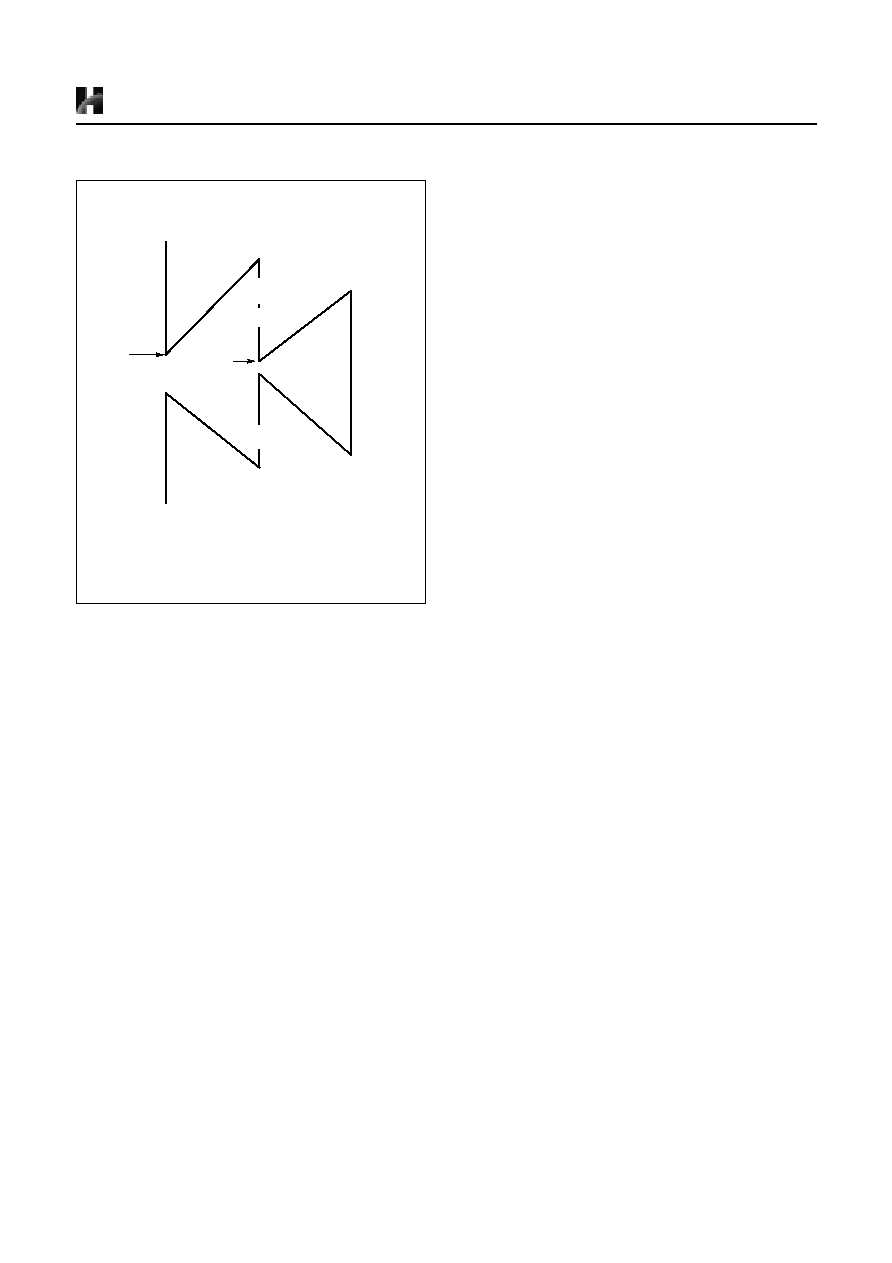
HYUNDAI MicroElectronics
HMS87C1304A/HMS87C1302A
Jan. 2001
Preliminary
53
Figure 15-5 Execution of Multi Interrupt
Example: Even though Timer1 interrupt is in progress,
INT0 interrupt serviced without any suspend.
TIMER1:
PUSH
A
PUSH
X
PUSH
Y
LDM
IENH,#80H
;
Enable INT0 only
LDM
IENL,#0
;
Disable other
EI
;
Enable Interrupt
:
:
:
:
:
:
LDM
IENH,#0F0H
;
Enable all interrupts
LDM
IENL,#0E0H
POP
Y
POP
X
POP
A
RETI
enable INT0
TIMER 1
service
INT0
service
Main Program
service
Occur
TIMER1 interrupt
Occur
INT0
EI
disable other
enable INT0
enable other
In this example, the INT0 interrupt can be serviced without any
pending, even TIMER1 is in progress.
Because of re-setting the interrupt enable registers IENH,IENL
and master enable "EI" in the TIMER1 routine.
Preliminary
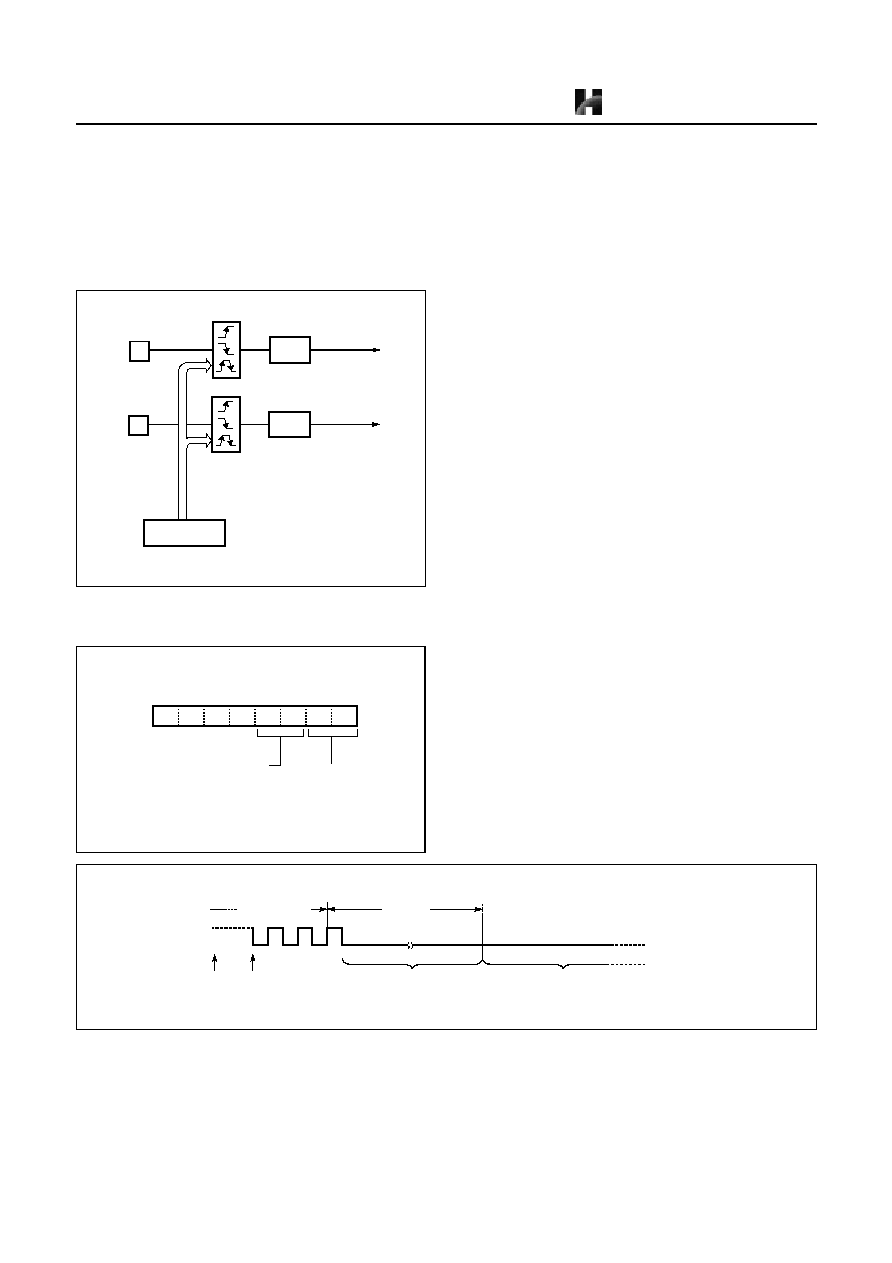
HMS87C1304A/HMS87C1302A
HYUNDAI MicroElectronics
54
Preliminary
Jan. 2001
15.4 External Interrupt
The external interrupt on INT0 and INT1 pins are edge
triggered depending on the edge selection register IEDS
(address 0E6
H
) as shown in Figure 15-6 .
The edge detection of external interrupt has three transition
activated mode: rising edge, falling edge, and both edge.
Figure 15-6 External Interrupt Block Diagram
Example: To use as an INT0 and INT1
:
:
;
**** Set port as an input port RB2
LDM
RBIO,#1111_1011B
;
;
**** Set port as an interrupt port
LDM
RBFUNC,#04H
;
;
**** Set Falling-edge Detection
LDM
IEDS,#0000_0001B
:
:
:
Response Time
The INT0 and INT1 edge are latched into INT0IF and
INT1IF at every machine cycle. The values are not actually
polled by the circuitry until the next machine cycle. If a re-
quest is active and conditions are right for it to be acknowl-
edged, a hardware subroutine call to the requested service
routine will be the next instruction to be executed. The
DIV itself takes twelve cycles. Thus, a minimum of twelve
complete machine cycles elapse between activation of an
external interrupt request and the beginning of execution
of the first instruction of the service routine.
shows interrupt response timings.
Figure 15-7 Interrupt Response Timing Diagram
INT0IF
INT0 pin
INT0 INTERRUPT
INT1IF
INT1 pin
INT1 INTERRUPT
IEDS
[0E6
H
]
edge select
ion
INT0 edge select
Ext. Interrupt Edge Selection
IEDS
ADDRESS : 0E6
H
RESET VALUE : 00000000
00 : Int. disable
W
W
W
W
W
W
01 : falling
10 : rising
11 : both
INT1 edge select
00 : Int. disable
01 : falling
10 : rising
11 : both
Register
W
W
Interrupt
goes
active
Interrupt
latched
Interrupt
processing
Interrupt
routine
8 f
OSC
max. 12 f
OSC
Preliminary

HYUNDAI MicroElectronics
HMS87C1304A/HMS87C1302A
Jan. 2001
Preliminary
55
16. WATCHDOG TIMER
The purpose of the watchdog timer is to detect the mal-
function (runaway) of program due to external noise or
other causes and return the operation to the normal condi-
tion.
The watchdog timer has two types of clock source.
The first type is an on-chip RC oscillator which does not
require any external components. This RC oscillator is sep-
arate from the external oscillator of the Xin pin. It means
that the watchdog timer will run, even if the clock on the
Xin pin of the device has been stopped, for example, by en-
tering the STOP mode.
The other type is a prescaled system clock.
The watchdog timer consists of 7-bit binary counter and
the watchdog timer data register. When the value of 7-bit
binary counter is equal to the lower 7 bits of WDTR, the
interrupt request flag is generated. This can be used as
WDT interrupt or reset the CPU in accordance with the bit
WDTON.
Note: Because the watchdog timer counter is enabled af-
ter clearing Basic Interval Timer, after the bit WD-
TON set to "1", maximum error of timer is depend on
prescaler ratio of Basic Interval Timer.
The 7-bit binary counter is cleared by setting WDTCL(bit7
of WDTR) and the WDTCL is cleared automatically after
1 machine cycle.
The RC oscillated watchdog timer is activated by setting
the bit RCWDT as shown below.
The RC oscillation period is vary with temperature, V
DD
and process variations from part to part (approximately,
40~120uS). The following equation shows the RC oscillat-
ed watchdog timer time-out.
T
R C W D T
= C L K
R C
�2
8
�[
W D T R .6~ 0]+ (C L K
R C
�2
8
)/2
w here, C L K
R C
= 4 0~ 1 20 u S
In addition, this watchdog timer can be used as a simple 7-
bit timer by interrupt WDTIF. The interval of watchdog
timer interrupt is decided by Basic Interval Timer. Interval
equation is as below.
T
WDT
= [WDTR.6~0]
�
�
�
�
Interval of BIT
Figure 16-1 Block Diagram of Watchdog Timer
:
LDM
CKCTLR,#3FH
; enable the RC-osc WDT
LDM
WDTR,#0FFH
; set the WDT period
STOP
; enter the STOP mode
NOP
NOP
; RC-osc WDT running
:
�
8
�
16
�
128
�
256
�
512
�
1024
�
32
�
64
0
1
MUX
8
3
fxin
BITR (8-bit)
BTS[2:0]
Internal RC OSC
Basic Interval Timer
Interrupt
BTCL
Clear
Watchdog Timer
BITIF
7-bit Counter
WDTR (8-bit)
OFD
WDTCL
WDTON
Interrupt Request
CPU RESET
1
0
Clock Control Register
CKCTLR
ADDRESS : ECH
RESET VALUE : -0010111
-
WAKEUP RCWDT
WDTON
BTCL
BTS2
BTS1
BTS0
-
0
X
1
X
X
X
X
Watchdog Timer Register
WDTR
ADDRESS : EDH
RESET VALUE : 01111111
WDTCL
7-bit Watchdog Counter Register
Overflow Detection
Bit Manipulation Not Available
Bit Manipulation Not Available
STOP
WAKEUP
RCWDT
Preliminary
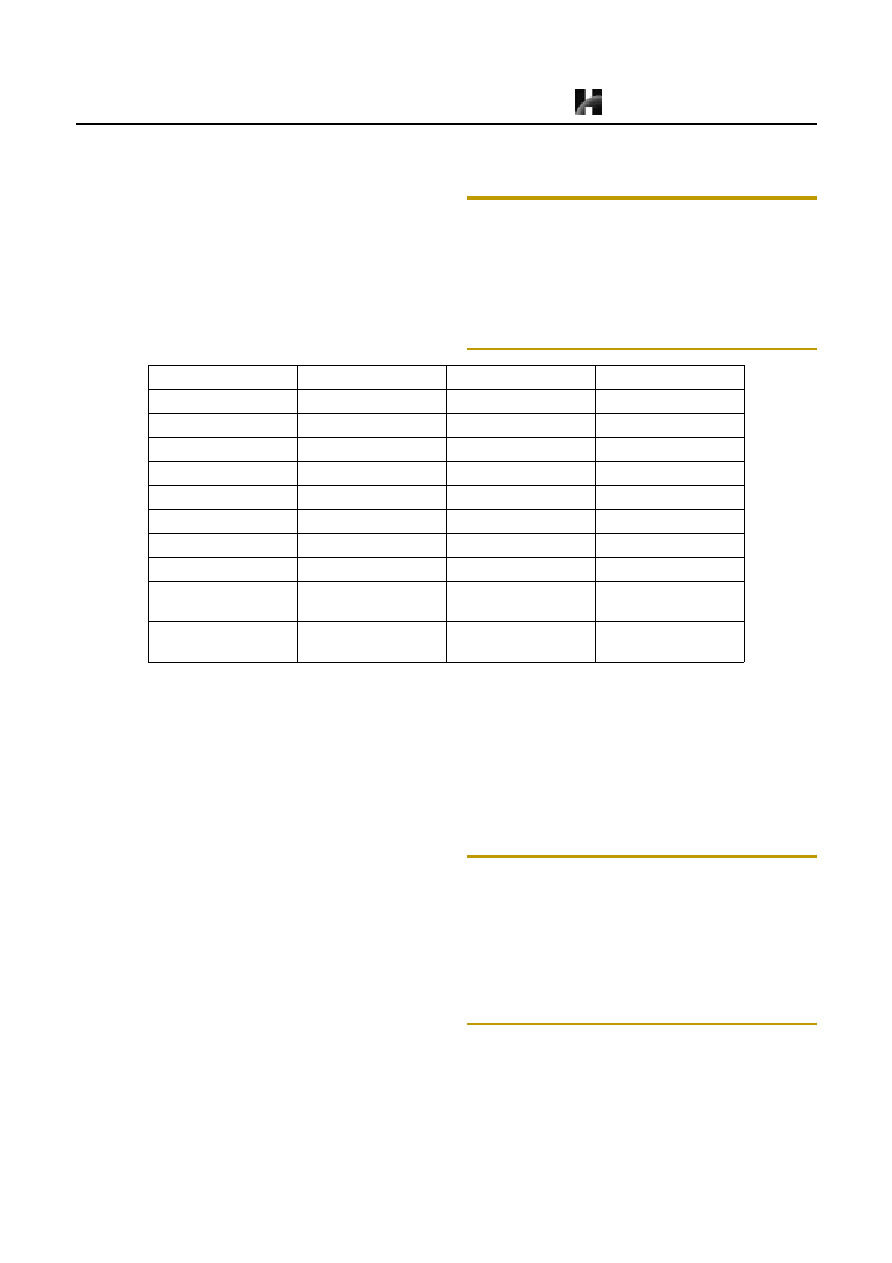
HMS87C1304A/HMS87C1302A
HYUNDAI MicroElectronics
56
Preliminary
Jan. 2001
17. Power Saving Mode
For applications where power consumption is a critical
factor, device provides three kinds of power saving func-
tions, STOP mode, Wake-up Timer mode and internal RC-
oscillated watchdog timer mode.
The power saving function is activated by execution of
STOP instruction after setting the corresponding bit
(WAKEUP, RCWDT) of CKCTLR.
Table 17-1 shows the status of each Power Saving Mode
Note: Before executing STOP instruction, clear all in-
terrupt request flag. Because if the interrupt re-
quest flag is set before STOP instruction, the MCU
runs as if it doesn't perform STOP instruction, even
though the STOP instruction is completed. So insert
two lines to clear all interrupt request flags (IRQH,
IRQL) before STOP instruction as shown each ex-
ample.
17.1 Stop Mode
In the Stop mode, the on-chip oscillator is stopped. With
the clock frozen, all functions are stopped, but the on-chip
RAM and Control registers are held. The port pins out the
values held by their respective port data register, port di-
rection registers. Oscillator stops and the systems internal
operations are all held up.
� The states of the RAM, registers, and latches valid
immediately before the system is put in the STOP
state are all held.
� The program counter stop the address of the
instruction to be executed after the instruction
"STOP" which starts the STOP operating mode.
The Stop mode is activated by execution of STOP in-
struction after setting the bit WAKEUP and RCWDT
of CKCTLR to "00". (This register should be written
by byte operation. If this register is set by bit manipu-
lation instruction, for example "set1" or "clr1" instruc-
tion, it may be undesired operation)
In the Stop mode of operation, V
DD
can be reduced to min-
imize power consumption. Care must be taken, however,
to ensure that V
DD
is not reduced before the Stop mode is
invoked, and that V
DD
is restored to its normal operating
level, before the Stop mode is terminated.
The reset should not be activated before V
DD
is restored to
its normal operating level, and must be held active long
enough to allow the oscillator to restart and stabilize.
Note: After STOP instruction, at least two or more NOP
instruction should be written
Ex) LDM CKCTLR,#0000_1110B
LDM IRQH,#0
LDM IRQL,#0
STOP
NOP
NOP
In the STOP operation, the dissipation of the power asso-
ciated with the oscillator and the internal hardware is low-
ered; however, the power dissipation associated with the
pin interface (depending on the external circuitry and pro-
gram) is not directly determined by the hardware operation
Peripheral
STOP
Wake-up Timer
Internal RC-WDT
RAM
Retain
Retain
Retain
Control Registers
Retain
Retain
Retain
I/O Ports
Retain
Retain
Retain
CPU
Stop
Stop
Stop
Timer0
Stop
Operation
Stop
Oscillation
Stop
Oscillation
Stop
Prescaler
Stop
�
2048 only
Stop
Internal RC oscillator
Stop
Stop
Oscillation
Entering Condition
CKCTLR[6,5]
00
1X
01
Power Saving Release
Source
RESET, INT0, INT1
RESET, INT0, INT1,
Timer0
RESET, INT0, INT1,
RC-WDT
Table 17-1 Power Saving Mode
Preliminary

HYUNDAI MicroElectronics
HMS87C1304A/HMS87C1302A
Jan. 2001
Preliminary
57
of the STOP feature. This point should be little current
flows when the input level is stable at the power voltage
level (V
DD
/V
SS
), however, when the input level gets high-
er than the power voltage level (by approximately 0.3 to
0.5V), a current begins to flow. Therefore, if cutting off the
output transistor at an I/O port puts the pin signal into the
high-impedance state, a current flow across the ports input
transistor, requiring to fix the level by pull-up or other
means.
Release the STOP mode
The exit from STOP mode is hardware reset or external in-
terrupt. Reset re-defines all the Control registers but does
not change the on-chip RAM. External interrupts allow
both on-chip RAM and Control registers to retain their val-
ues.
After releasing STOP mode, instruction execution is divid-
ed into two ways by I-flag(bit2 of PSW).
If I-flag = 1, the normal interrupt response takes place. If I-
flag = 0, the chip will resume execution starting with the
instruction following the STOP instruction. It will not vec-
tor to interrupt service routine. (refer to )
When exit from Stop mode by external interrupt, enough
oscillation stabilization time is required to normal opera-
tion. shows the timing diagram. When release the Stop
mode, the Basic interval timer is activated on wake-up. It
is increased from 00
H
until FF
H
. The count overflow is set
to start normal operation. Therefore, before STOP instruc-
tion, user must be set its relevant prescaler divide ratio to
have long enough time (more than 20msec). This guaran-
tees that oscillator has started and stabilized.
By reset, exit from Stop mode is shown in .
Minimizing Current Consumption in Stop Mode
The Stop mode is designed to reduce power consumption.
To minimize the current consumption during Stop mode,
the user should turn-off output drivers that are sourcing or
sinking current, if it is practical. Weak pull-ups on port
pins should be turned off, if possible. All inputs should be
either as V
SS
or at V
DD
(or as close to rail as possible).
An intermediate voltage on an input pin causes the input
buffer to draw a significant amount of current.
Figure 17-1 STOP Releasing Flow by Interrupts
Figure 17-2 Timing of STOP Mode Release by External Interrupt
IEXX
=0
=1
STOP
INSTRUCTION
STOP Mode
Interrupt Request
STOP Mode Release
I-FLAG
=1
Interrupt Service Routine
Next
INSTRUCTION
=0
Master Interrupt
Enable Bit PSW[2]
Corresponding Interrupt
Enable Bit (IENH, IENL)
~~
STOP Mode
Normal Operation
Oscillator
(X
IN
pin)
~~
~~
N+1
N
N+2
00
01
FE
FF
00
01
N-1
N-2
~~
~~
~~
~~
~~
Clear Basic Interval Timer
STOP Instruction Execution
Normal Operation
Stabilization Time
t
ST
> 20mS
Internal
Clock
External
Interrupt
BIT
Counter
~~
Preliminary
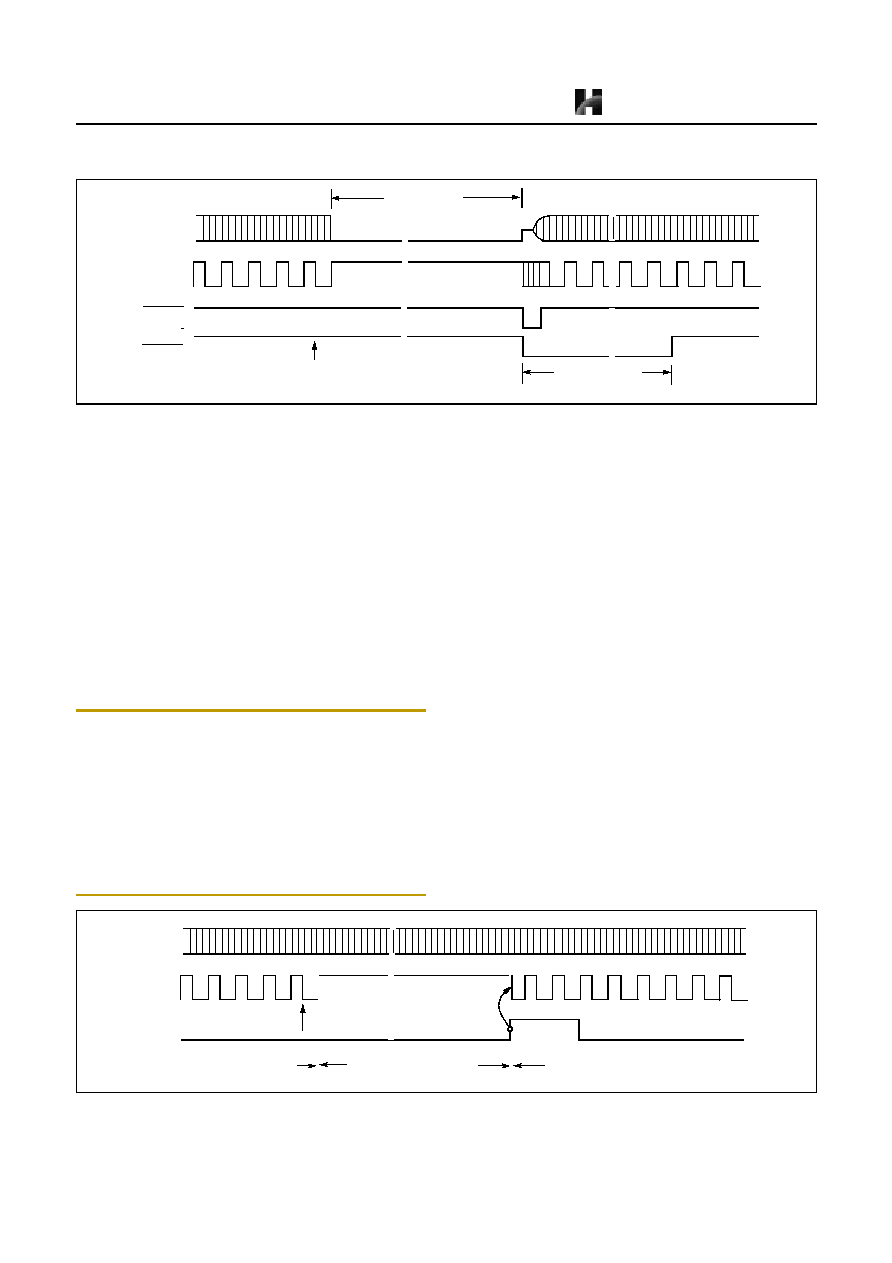
HMS87C1304A/HMS87C1302A
HYUNDAI MicroElectronics
58
Preliminary
Jan. 2001
Figure 17-3 Timing of STOP Mode Release by RESET
17.2 Wake-up Timer Mode
In the Wake-up Timer mode, the on-chip oscillator is not
stopped. Except the Prescaler (only 2048 divided ratio) and
Timer0, all functions are stopped, but the on-chip RAM
and Control registers are held. The port pins out the values
held by their respective port data register, port direction
registers.
The Wake-up Timer mode is activated by execution of
STOP instruction after setting the bit WAKEUP of
CKCTLR to "1". (This register should be written by
byte operation. If this register is set by bit manipulation
instruction, for example "set1" or "clr1" instruction, it
may be undesired operation)
Note: After STOP instruction, at least two or more NOP in-
struction should be written
Ex) LDM TDR0,#0FFH
LDM TM0,#0001_1011B
LDM CKCTLR,#0100_1110B
LDM IRQH,#0
LDM IRQL,#0
STOP
NOP
NOP
In addition, the clock source of timer0 should be select-
ed to 2048 divided ratio. Otherwise, the wake-up func-
tion can not work. And the timer0 can be operated as
16-bit timer with timer1 (refer to timer function). The
period of wake-up function is varied by setting the tim-
er data register 0, TDR0.
Release the Wake-up Timer mode
The exit from Wake-up Timer mode is hardware reset,
Timer0 overflow or external interrupt. Reset re-defines all
the Control registers but does not change the on-chip
RAM. External interrupts and Timer0 overflow allow both
on-chip RAM and Control registers to retain their values.
If I-flag = 1, the normal interrupt response takes place. If I-
flag = 0, the chip will resume execution starting with the
instruction following the STOP instruction. It will not vec-
tor to interrupt service routine (refer to ).
When exit from Wake-up Timer mode by external inter-
rupt or timer0 overflow, the oscillation stabilization time is
not required to normal operation. Because this mode do not
stop the on-chip oscillator shown as .
Figure 17-4 Wake-up Timer Mode Releasing by External Interrupt or Timer0 Interrupt
~~
STOP Mode
Oscillator
(X
IN
pin)
~~
~~
~~
STOP Instruction Execution
Stabilization Time
t
ST
= 64mS @4MHz
Internal
Clock
Internal
~~
~~
~~
~~
~~
RESET
RESET
Time can not be controlled by software
Wake-up Timer Mode
Oscillator
(X
IN
pin)
~~
STOP Instruction
Normal Operation
Normal Operation
CPU
Clock
Request
Interrupt
~~
~~
Execution
Do not need Stabilization Time
(stop the CPU clock)
~~
Preliminary

HYUNDAI MicroElectronics
HMS87C1304A/HMS87C1302A
Jan. 2001
Preliminary
59
17.3 Internal RC-Oscillated Watchdog Timer Mode
In the Internal RC-Oscillated Watchdog Timer mode, the
on-chip oscillator is stopped. But internal RC oscillation
circuit is oscillated in this mode. The on-chip RAM and
Control registers are held. The port pins out the values held
by their respective port data register, port direction regis-
ters.
The Internal RC-Oscillated Watchdog Timer mode is
activated by execution of STOP instruction after set-
ting the bit WAKEUP and RCWDT of CKCTLR to
"01". (This register should be written by byte opera-
tion. If this register is set by bit manipulation instruc-
tion, for example "set1" or "clr1" instruction, it may be
undesired operation)
Note: After STOP instruction, at least two or more NOP in-
struction should be written
Ex) LDM WDTR,#1111_1111B
LDM CKCTLR,#0010_1110B
LDM IRQH,#0
LDM IRQL,#0
STOP
NOP
NOP
Release the Internal RC-Oscillated Watchdog Timer mode
The exit from Internal RC-Oscillated Watchdog Timer
mode is hardware reset or external interrupt. Reset re-de-
fines all the Control registers but does not change the on-
chip RAM. External interrupts allow both on-chip RAM
and Control registers to retain their values.
If I-flag = 1, the normal interrupt response takes place. In
this case, if the bit WDTON of CKCTLR is set to "0" and
the bit WDTE of IENH is set to "1", the device will exe-
cute the watchdog timer interrupt service routine.() How-
ever, if the bit WDTON of CKCTLR is set to "1", the
device will generate the internal RESET signal and exe-
cute the reset processing. ()
If I-flag = 0, the chip will resume execution starting with
the instruction following the STOP instruction. It will not
vector to interrupt service routine (refer to ).
When exit from Internal RC-Oscillated Watchdog Timer
mode by external interrupt, the oscillation stabilization
time is required for normal operation. shows the timing di-
agram. When release the Internal RC-Oscillated Watchdog
Timer mode, the basic interval timer is activated on wake-
up. It is increased from 00
H
until FF
H
. The count overflow
is set to start normal operation. Therefore, before STOP in-
struction, user must be set its relevant prescaler divide ratio
to have long enough time (more than 20msec). This guar-
antees that oscillator has started and stabilized.
By reset, exit from internal RC-Oscillated Watchdog Tim-
er mode is shown in .
Figure 17-5 Internal RCWDT Mode Releasing by External Interrupt or WDT Interrupt
~~
RCWDT Mode
Normal Operation
Oscillator
(X
IN
pin)
~~
~~
N+1
N
N+2
00
01
FE
FF
00
00
N-1
N-2
~~
~~
~~
~~
~~
Clear Basic Interval Timer
STOP Instruction Execution
Normal Operation
Stabilization Time
t
ST
> 20mS
Internal
Clock
External
Interrupt
BIT
Counter
~~
Internal
RC Clock
(or WDT Interrupt)
Preliminary

HMS87C1304A/HMS87C1302A
HYUNDAI MicroElectronics
60
Preliminary
Jan. 2001
Figure 17-6 Internal RCWDT Mode Releasing by RESET.
Figure 17-7 Application Example of Unused Input Por
t
Figure 17-8 Application Example of Unused input Port
~~
Oscillator
(X
IN
pin)
~~
~~
~~
~~
Internal
Clock
Internal
RC Clock
~~
STOP Instruction Execution
Stabilization Time
t
ST
= 64mS @4MHz
Internal
~~
~~
~~
RESET by WDT
RESET
RESET
RCWDT Mode
Time can not be controlled by software
INPUT PIN
V
DD
GND
i
V
DD
X
Weak pull-up current flows
V
DD
internal
pull-up
INPUT PIN
i
V
DD
X
Very weak current flows
V
DD
O
O
OPEN
OPEN
i=0
O
i=0
O
GND
When port is configured as an input, input level should
be closed to 0V or 5V to avoid power consumption.
OUTPUT PIN
GND
i
In the left case, much current flows from port to GND.
X
ON
OFF
OUTPUT PIN
GND
i
In the left case, Tr. base current flows from port to GND.
i=0
X
OFF
ON
V
DD
L
ON
OFF
OPEN
GND
V
DD
L
ON
OFF
To avoid power consumption, there should be low output
ON
OFF
O
O
V
DD
O
to the port .
Preliminary
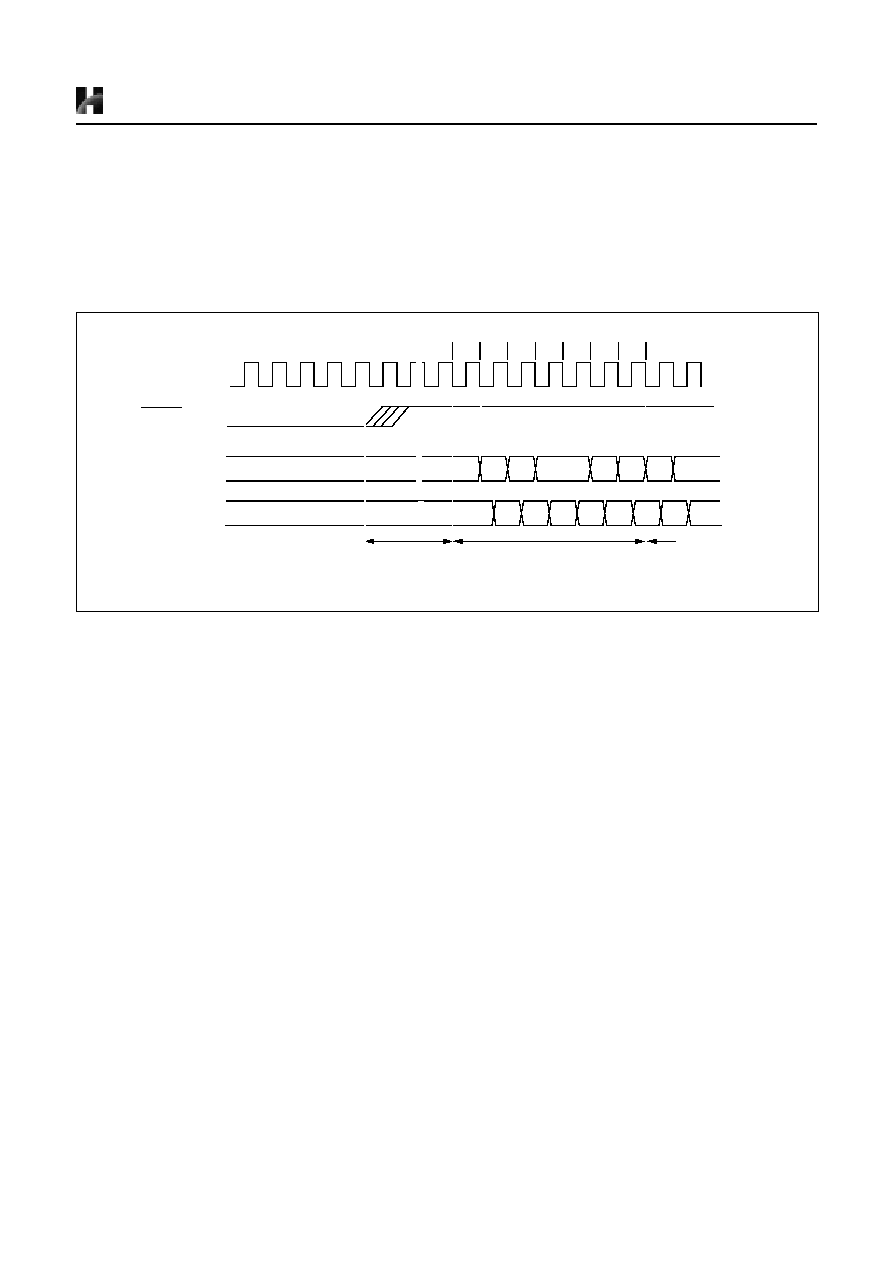
HYUNDAI MicroElectronics
HMS87C1304A/HMS87C1302A
Jan. 2001
Preliminary
61
18. RESET
The reset input is the RESET pin, which is the input to a
Schmitt Trigger. A reset in accomplished by holding the
RESET pin low for at least 8 oscillator periods, while the
oscillator running. After reset, 64ms (at 4 MHz) add with
7 oscillator periods are required to start execution as shown
in Figure 18-1 .
Internal RAM is not affected by reset. When V
DD
is turned
on, the RAM content is indeterminate. Therefore, this
RAM should be initialized before reading or testing it.
Initial state of each register is shown as Table 8-1 .
Figure 18-1 Timing Diagram after RESET
MAIN PROGRAM
Oscillator
(X
IN
pin)
?
?
FFFE FFFF
Stabilizing Time
t
ST
= 64mS at 4MHz
RESET
ADDRESS
DATA
1
2
3
4
5
6
7
?
?
Start
?
?
?
FE
?
ADL
ADH
OP
BUS
BUS
RESET Process Step
~~
~~
~~
~~
~~
~~
Preliminary
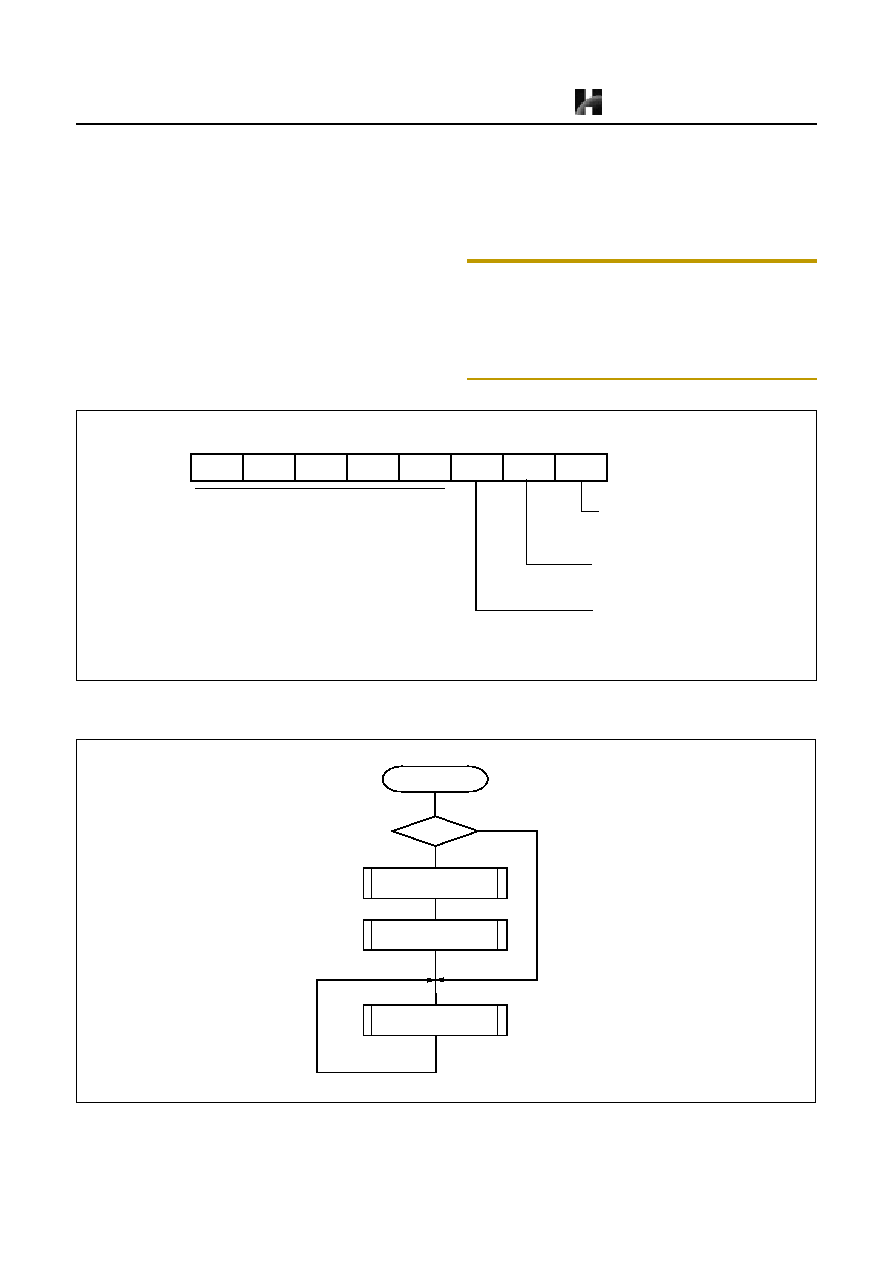
HMS87C1304A/HMS87C1302A
HYUNDAI MicroElectronics
62
Preliminary
Jan. 2001
19. POWER FAIL PROCESSOR
The HMS87C1304A and HMS87C1302A has an on-chip
power fail detection circuitry to immunize against power
noise. A configuration register, PFDR, can enable (if clear/
programmed) or disable (if set) the Power-fail Detect cir-
cuitry. If V
DD
falls below 2.5~3.5V(2.0~3.0V) range for
longer than 50 nS, the Power fail situation may reset MCU
according to PFS bit of PFDR. And power fail detect level
is selectable by mask option. On the other hand, in the
OTP, power fail detect level is decided by setting the bit
PFDLEVEL of CONFIG register when program the OTP.
As below PFDR register is not implemented on the in-cir-
cuit emulator, user can not experiment with it. Therefore,
after final development of user program, this function may
be experimented.
Note: Power fail detect level is decided by mask option
checking the bit PFDLEVEL of MASK ORDER
SHEET (refer to MASK ORDER SHEET)
In thc case of OTP, Power fail detect level is decid-
ed by setting the bit PFDLEVEL of CONFIG register
(refer to Figure 20-1 .
Figure 19-1 Power Fail Detector Register
Figure 19-2 Example S/W of RESET by Power fail
PFDR
ADDRESS : EFH
RESET VALUE : -----100
-
-
-
-
-
PFDIS
PFDM
PFS
Reserved
Power Fail Status
0 : Normal Operate
1 : This bit force to "1" when
Operation Mode
0 : System Clock Freeze during power fail
1 : MCU will be reset during power fail
Disable Flag
0 : Power fail detection enable
1 : Power fail detection disable
Power Fail Detector Register
Power fail was detected
FUNTION
EXECUTION
INITIALIZE RAM DATA
PFS =1
NO
RESET VECTOR
INITIALIZE ALL PORTS
INITIALIZE REGISTERS
RAM CLEAR
YES
Skip the
initial routine
Preliminary
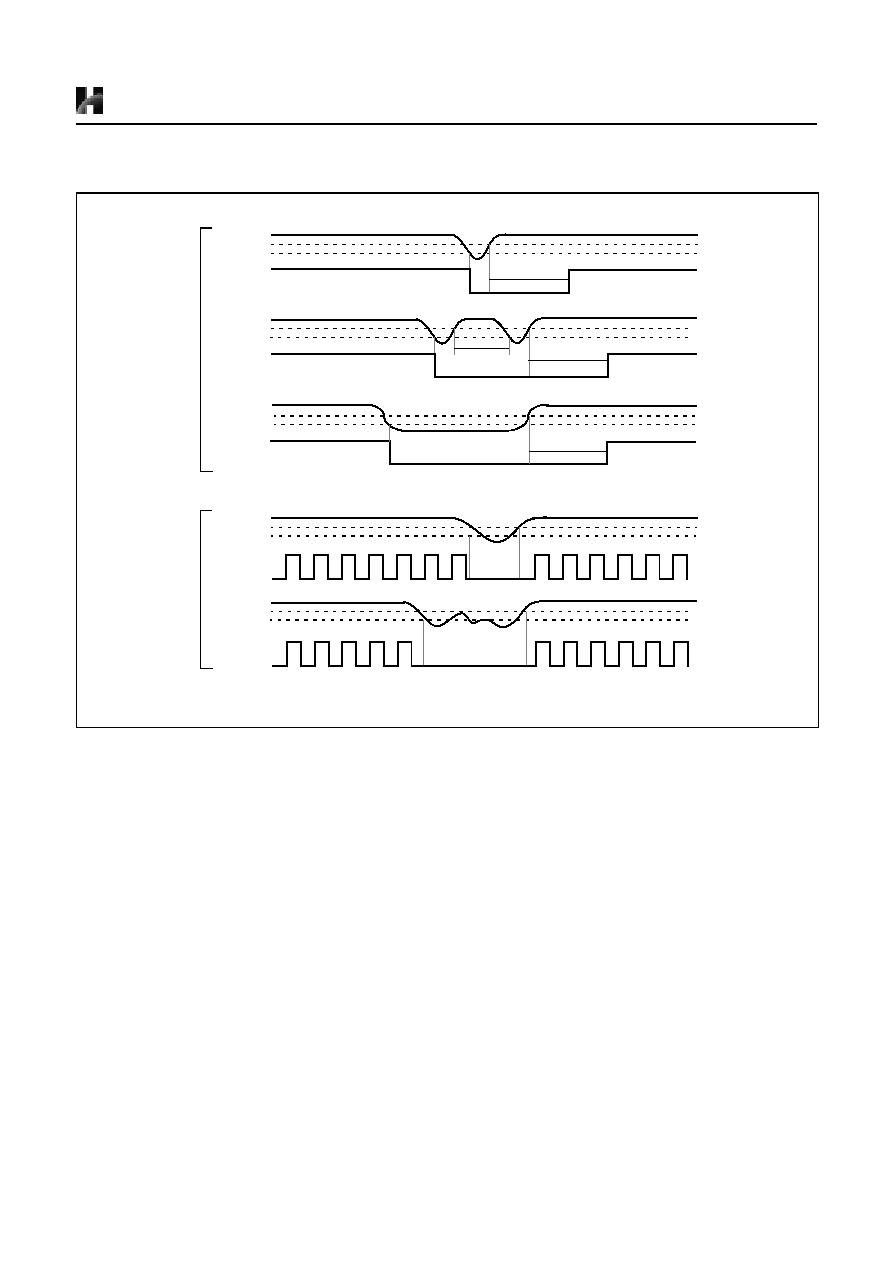
HYUNDAI MicroElectronics
HMS87C1304A/HMS87C1302A
Jan. 2001
Preliminary
63
Figure 19-3 Power Fail Processor Situations
Internal
RESET
Internal
RESET
Internal
RESET
V
DD
V
DD
V
DD
PFV
DD
MAX
PFV
DD
MIN
PFV
DD
MAX
PFV
DD
MIN
PFV
DD
MAX
PFV
DD
MIN
64mS
64mS
t < 64mS
64mS
When PFDM = 1
V
DD
V
DD
PFV
DD
MAX
PFV
DD
MIN
PFV
DD
MAX
PFV
DD
MIN
When PFDM = 0
System
Clock
System
Clock
Preliminary
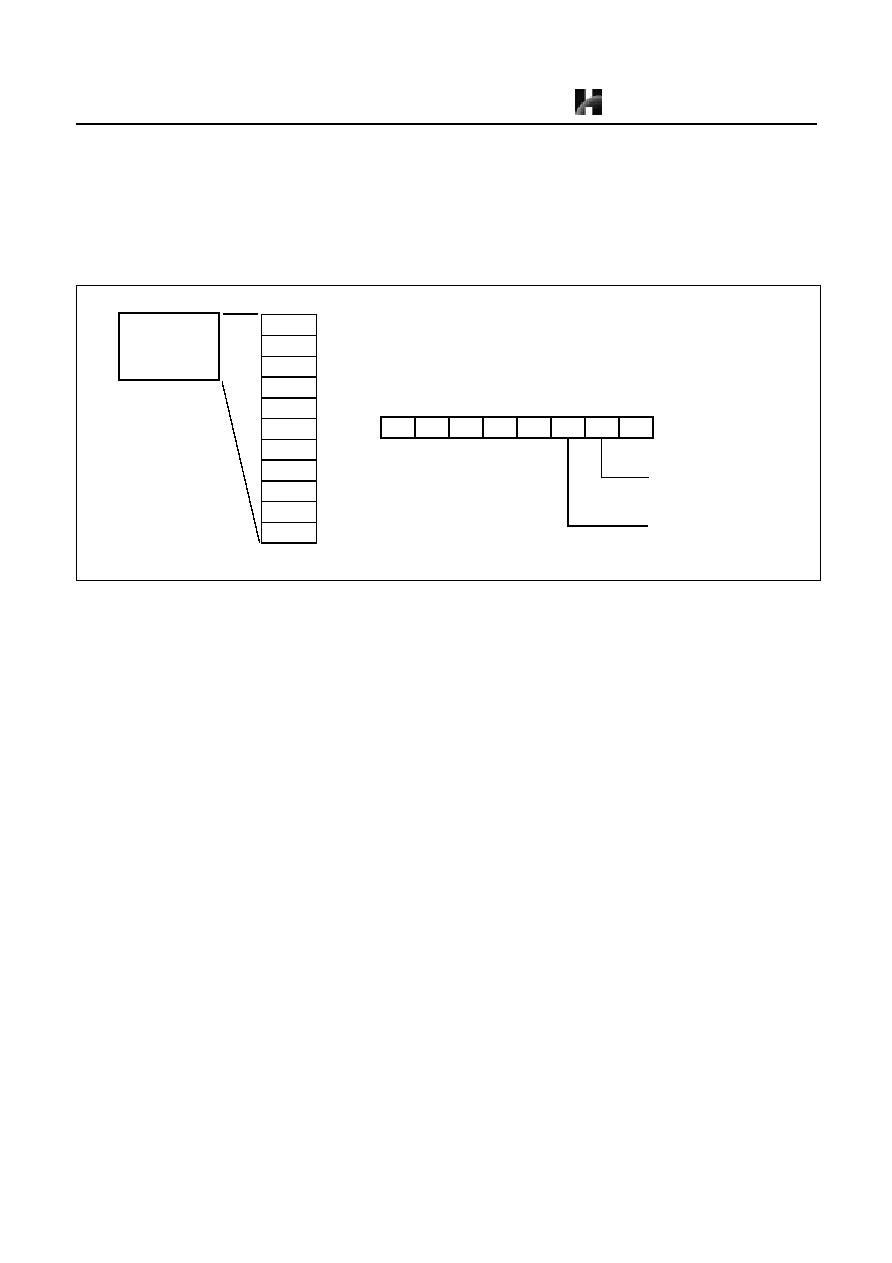
HMS87C1304A/HMS87C1302A
HYUNDAI MicroElectronics
64
Preliminary
Jan. 2001
20.
DEVICE CONFIGURATION AREA
The Device Configuration Area can be programmed or left
unprogrammed to select device configuration such as secu-
rity bit.
Ten memory locations (0F50
H
~ 0FE0
H
) are designated as
Customer ID recording locations where the user can store
check-sum or other customer identification numbers.
This area is not accessible during normal execution but is
readable and writable during program / verify.
Figure 20-1 Device Configuration Area
DEVICE
0F50
H
0F50
H
0FF0
H
0FF0
H
ID
CONFIG
CONFIGURATION
AREA
0F60
H
ID
0F70
H
ID
0F80
H
ID
0F90
H
ID
0FA0
H
ID
0FB0
H
ID
0FC0
H
ID
0FD0
H
ID
0FE0
H
ID
-
Configuration Register
CONFIG
ADDRESS : 0FF0H
-
LOCK
-
-
-
-
PFD
0 Allow Code Read Out
1 : Prohibit Code Read Out
SECURITY BIT
LEVEL
0 : PFD Level High (2.5~3.5V)
1 : PFD Level Low (2.0~3.0V)
PFD Level Select
Preliminary
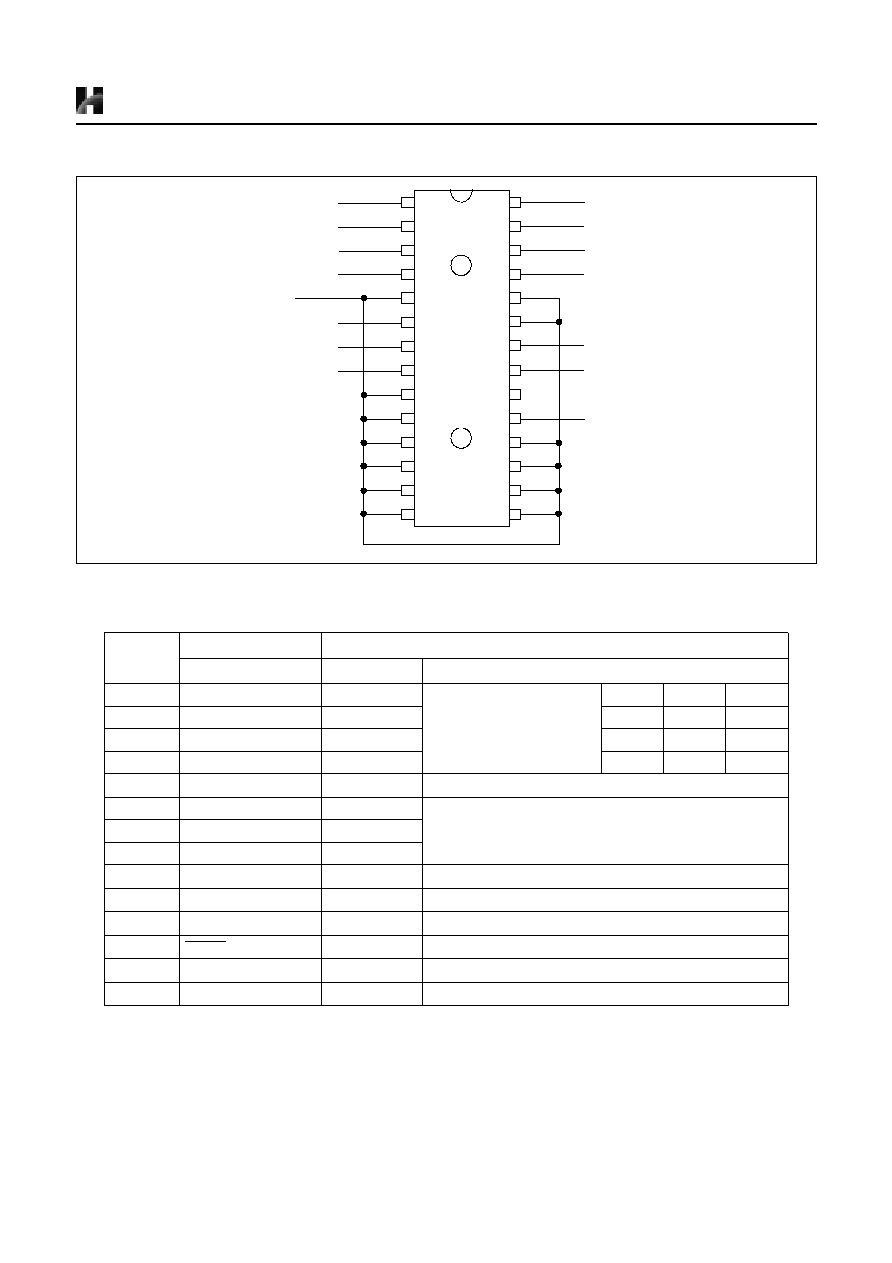
HYUNDAI MicroElectronics
HMS87C1304A/HMS87C1302A
Jan. 2001
Preliminary
65
Figure 20-2 Pin Assignment
V
DD
1
2
3
4
5
6
7
8
9
10
28
27
26
25
24
23
22
21
20
19
11
12
13
14
18
17
16
15
V
PP
A_D0
A_D1
A_D2
A_D3
EPROM Enable
A_D7
A_D6
A_D5
A_D4
CTL2
CTL1
CTL0
V
SS
NC
Pin No.
User Mode
EPROM MODE
Pin Name
Pin Name
Description
1
RA4 (AN4)
A_D4
Address Input
Data Input/Output
A12
A4
D4
2
RA5 (AN5)
A_D5
A13
A5
D5
3
RA6 (AN6)
A_D6
A14
A6
D6
4
RA7 (AN7)
A_D7
A15
A7
D7
5
V
DD
V
DD
Connect to V
DD
(6.0V)
6
RB0 (AVref/AN0)
CTL0
Read/Write Control
Address/Data Control
7
RB1 (INT0)
CTL1
8
RB2 (INT1)
CTL2
9~18
RB3~7, RC3~6, RD2
V
DD
Connect to V
DD
(6.0V)
19
X
IN
EPROM Enable
High Active, Latch Address in falling edge
20
X
OUT
NC
No connection
21
RESET
V
PP
Programming Power (0V, 12.75V)
22
V
SS
V
SS
Connect to V
SS
(0V)
23, 24
RC0, 1
V
DD
Connect to V
DD
(6.0V)
Table 20-1 Pin Description in EPROM Mode
Preliminary

HMS87C1304A/HMS87C1302A
HYUNDAI MicroElectronics
66
Preliminary
Jan. 2001
25
RA0 (EC0)
A_D0
Address Input
Data Input/Output
A8
A0
D0
26
RA1 (AN1)
A_D1
A9
A1
D1
27
RA2 (AN2)
A_D2
A10
A2
D2
28
RA3 (AN3)
A_D3
A11
A3
D3
Table 20-1 Pin Description in EPROM Mode
Preliminary
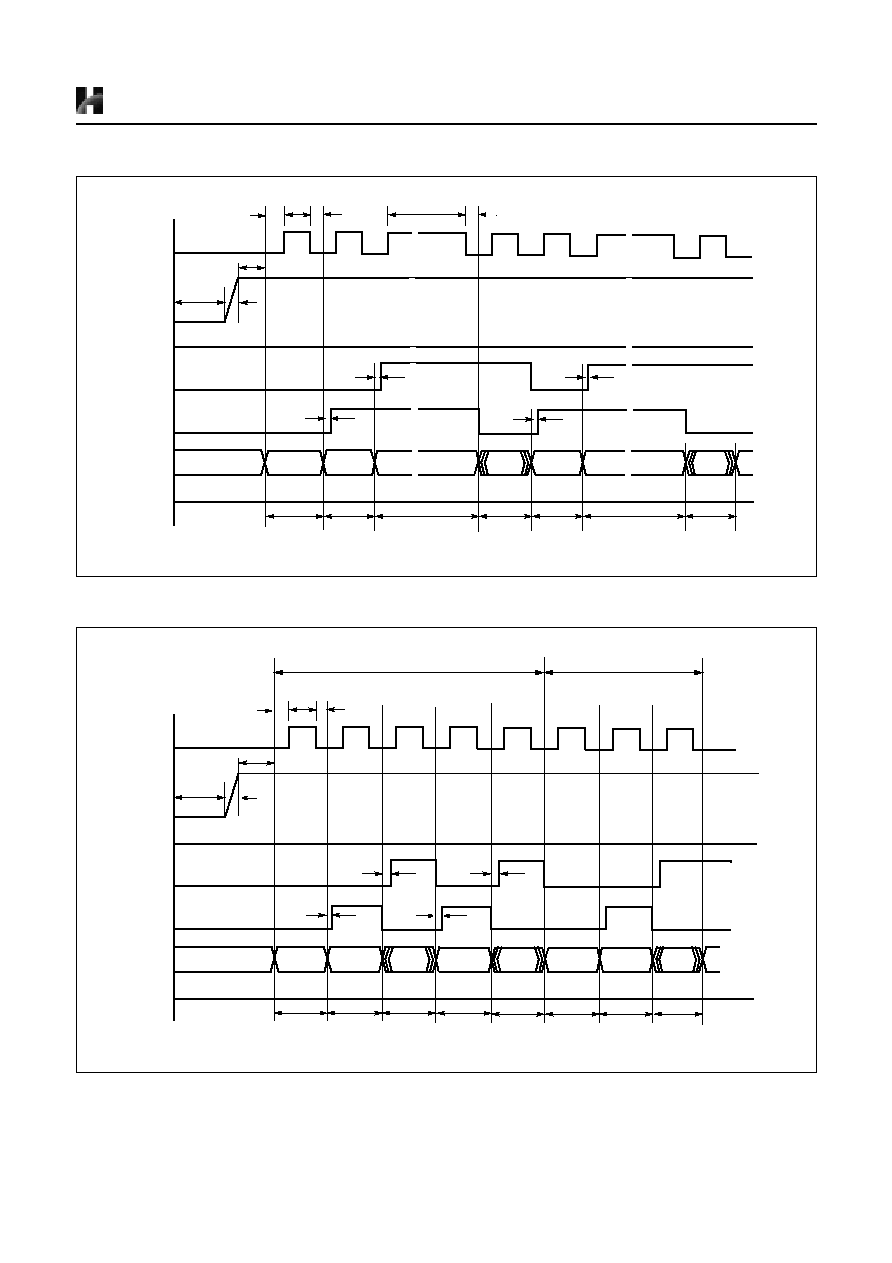
HYUNDAI MicroElectronics
HMS87C1304A/HMS87C1302A
Jan. 2001
Preliminary
67
Figure 20-3 Timing Diagram in Program (Write & Verify) Mode
Figure 20-4 Timing Diagram in READ Mode
V
PP
CTL0
~~
High 8bit
HA
LA
DATA IN
DATA
~~
~~
~~
~~
OUT
LA
DATA IN
DATA
OUT
EPROM
Enable
CTL1
CTL2
A_D7~
V
DD
V
DD1H
0V
0V
0V
Address
Input
Low 8bit
Address
Input
Write Mode
Verify
Low 8bit
Address
Input
Write Mode
Verify
A_D0
T
VDDS
T
VPPR
T
VPPS
~~
V
DD1H
V
DD1H
V
IHP
~~
~~
~~
~~
~~
~~
~~
~~
T
HLD1
T
HLD2
T
SET1
T
DLY1
T
DLY2
T
CD1
T
CD1
T
CD1
T
CD1
V
PP
CTL0
High 8bit
HA
LA
DATA
LA
DATA
DATA
EPROM
Enable
CTL1
CTL2
A_D7~
V
DD
V
DD2H
0V
0V
0V
Address
Input
Low 8bit
Address
Input
DATA
A_D0
T
VDDS
T
V P P R
T
VPPS
V
DD2H
V
DD2H
V
IHP
T
HLD1
T
SET1
T
DLY1
T
CD1
T
CD2
T
CD2
T
CD1
HA
LA
Output
Low 8bit
Address
Input
High 8bit
Address
Input
Low 8bit
Address
Input
DATA
Output
DATA
Output
After input a high address,
output data following low address input
Another high address step
Preliminary

HMS87C1304A/HMS87C1302A
HYUNDAI MicroElectronics
68
Preliminary
Jan. 2001
Parameter
Symbol
MIN
TYP
MAX
Unit
Programming Supply Current
I
VPP
-
-
50
mA
Supply Current in EPROM Mode
I
VDDP
-
-
20
mA
V
PP
Level during Programming
V
IHP
11.5
12.0
12.5
V
V
DD
Level in Program Mode
V
DD1H
5
6
6.5
V
V
DD
Level in Read Mode
V
DD2H
-
2.7
-
V
CTL2~0 High Level in EPROM Mode
V
IHC
0.8V
DD
-
-
V
CTL2~0 Low Level in EPROM Mode
V
ILC
-
-
0.2V
DD
V
A_D7~A_D0 High Level in EPROM Mode
V
IHAD
0.9V
DD
-
-
V
A_D7~A_D0 Low Level in EPROM Mode
V
ILAD
-
-
0.1V
DD
V
V
DD
Saturation Time
T
VDDS
1
-
-
mS
V
PP
Setup Time
T
VPPR
-
-
1
mS
V
PP
Saturation Time
T
VPPS
1
-
-
mS
EPROM Enable Setup Time after Data Input
T
SET1
200
nS
EPROM Enable Hold Time after T
SET1
T
HLD1
500
nS
EPROM Enable Delay Time after T
HLD1
T
DLY1
200
nS
EPROM Enable Hold Time in Write Mode
T
HLD2
100
nS
EPROM Enable Delay Time after T
HLD2
T
DLY2
200
nS
CTL2,1 Setup Time after Low Address input and Data input
T
CD1
100
nS
CTL1 Setup Time before Data output in Read and Verify Mode
T
CD2
100
nS
Table 20-2 AC/DC Requirements for Program/Read Mode
Preliminary

HYUNDAI MicroElectronics
HMS87C1304A/HMS87C1302A
Jan. 2001
Preliminary
69
Figure 20-5 Programming Flow Chart
START
Set V
DD
=V
DD1H
Set V
PP
=V
IHP
Verify blank
First Address Location
EPROM Write
N=1
Verify pass
Last address
Apply 3N program cycle
100uS program time
Next address location
Verify pass
Report
Programming failure
Report
Programming failure
Verify for all address
Verify OK
Report
Verify failure
Report
Programming OK
V
DD
=V
pp
=0v
END
NO
YES
YES
YES
YES
YES
NO
NO
NO
NO
Preliminary

HMS87C1304A/HMS87C1302A
HYUNDAI MicroElectronics
70
Preliminary
Jan. 2001
Figure 20-6 Reading Flow Chart
START
Set V
DD
=V
DD2H
Set V
PP
=V
IHP
Last address
First Address Location
V
DD
=0V
Report Read OK
V
PP
=0V
Next address location
Verify for all address
END
NO
YES
Preliminary





































































